HYPHAE

AN ORGANIC BINDING INVENTORY
Jessica Celis Documentary
„Don‘t think of materials as a dead, unresponsive mass, but as allies within a co-dependent design process. (...) Be aware of the consequences your design could have for others.„
(translated from german, Non-human Design: Manifest: Magazin für Haltung und Design, Ausgabe 294 Natur,december 2021, Page 60-63)
Thank to:
Pilzfarm.ch
Fine funghi,
Cecile Villiger
Kernser Edelpilze Grown.bio
Thomas Wüthrich
Werkstätten HSLU
Nadine Werner
Ruben Borer
Tim Widmer
3 HYPHAE EXPERIMENTS
A PROCESS IN MOTION



Emphasizes the sentience, intelligence, and agency of other organisms, necessitating a serious consideration of their needs, sensory capacities, and ability to interact. It is crucial to be mindful of the resource consumption and environmental impact of technologies, alongside their potential advantages.
We collaborate with regenerative systems that sustain themselves, while also acknowledging the linear progression of natural history. Nature is perpetually evolving; nothing remains static. Everything in nature gradually changes through evolution, and our goal is to avoid sudden, harmful disruptions and mass extinctions. As humans, we must tread lightly, offering generative contributions rather than disturbances.
We reject the pursuit of perfection and idealized futures. Instead, we address diverse and sometimes conflicting needs, focusing on making life survivable for both ourselves and other organisms.
5 HYPHAE EXPERIMENTS
(More-Than-Human Design Manifesto by Anton Poikolainen Rosén /MDPI)
LIST OF CONTENTS

CONCEPT
limits of own material perception
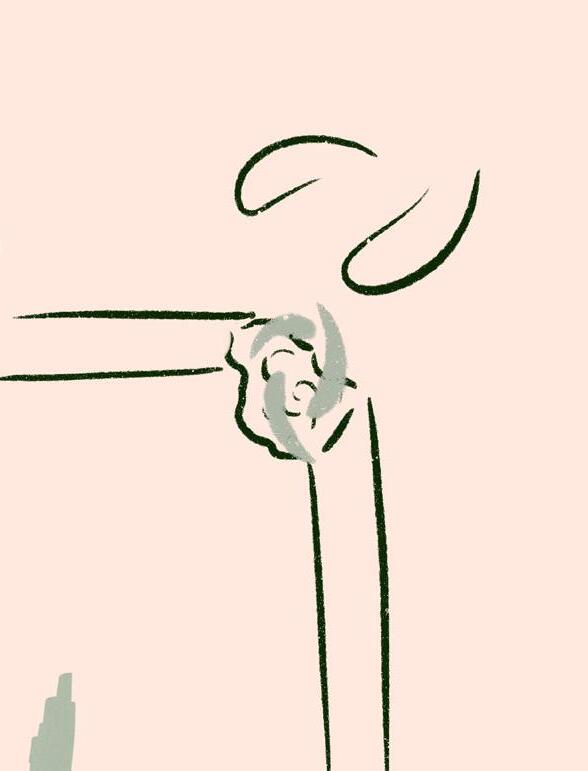
research about mycelium experiments
GROWTH

HEALING, BIOWELDING AND REACTIVATING
regeneration of tissue natural binder

NATURAL ADHESIVE AND CONNECTING VARIATIONS
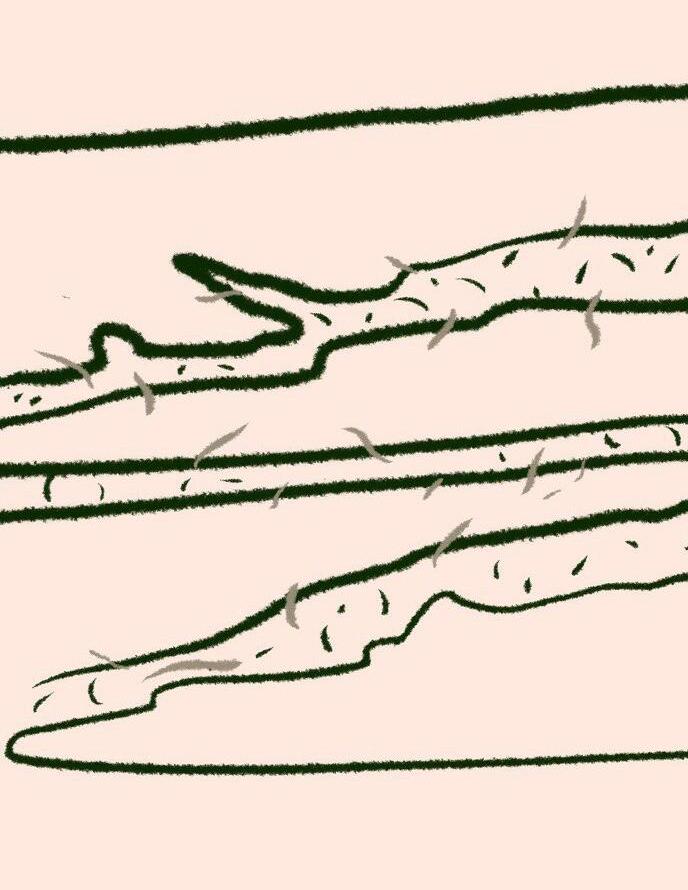
APPLIED CONTEXTS
adaptations and applied situation reflecting on mycelium in design
7 HYPHAE EXPERIMENTS 01 02 03 04 05
100% reusability 0 % waste wood bonding filler material aesthetic
CONCEPT
challenging material perceptions and exploratory design processes
There is a lack of awareness about material use in design, leading to excessive consumption. My focus is on a material that has been a focal point for many designers and architects due to its alternative-solution-driven characteristics. I firmly believe its potential utilization is not fully realized. Concerned about our wasteful handling of natural resources and the declining appreciation for slow, natural processes, which are vital for long-term stability, I was drawn to mycelium from the start. My interest lies not in its materiality but in its growth process and origin.
Firstly, when discussing mycelium, I want to acknowledge earlier research on the subject, taking further steps toward less wasteful material usage. Although this is still an exploitation of the natural world, where we kill the organism for our preferences and the „greater good,“ it is not a solution nor a justification. I want to emphasize that biomaterials are not always the more sustainable solution, often requiring more energy and materials than conventional production, which damages the primary cause we are all fighting for. I have observed that state-of-theart examples, such as mushroom leather or architectural applications, often detach mycelium from its natural state. The chemicals and technical processes used to enhance mycelium to meet modern production standards are barbaric and entirely at odds with its natural essence. Although the fascinating world of mushrooms is gaining recognition and mycelium is trending, its true purpose as a living organism is undervalued. It is used for packaging, a material to protect products during transport, reducing it to a commodity for consumer appeal. How degrading is that.
Furthermore, mycelium has been used beyond its natural capabilities and compared to synthetic materials. It should not be seen as an alternative to anything but appreciated for what it is:
a living entity.
Mycelium has been used for furniture, often as large, grown forms. This approach misunderstands and misapplies mycelium, artificializing it instead of acknowledging its original natural aesthetic. My bachelor thesis explores the synergy between natural creation processes and my role as a designer, observing and focusing on mycelium‘s potential without harming it. Through practical experiments, I demonstrate its regenerative and reactivating abilities after a dormant state instead of killing it
with heat as it is normally done, creating a continuous circular system where no material is lost. Previous forms can be transformed into new ones within the same volume, simplifying repairs through the mushroom‘s self-regeneration when revived with water.
The documentation of various growth forms is a vital part of my research, as the evolving stages of growth can only be observed temporarily and must be documented, similar to how children change rapidly - they grow so fast. These changes cannot be retrieved, and since I reuse the mycelium, most of the initial attempts evolve into been another form. I set this limit of material use by reusing old samples for new attachment methods.
This exploratory approach to design incorporates living organisms in a manner that prevents their exploitation, discovering their behaviors and potential by allowing them to steer the design, forming unique attachments with wood rather than mass-producing dried forms.
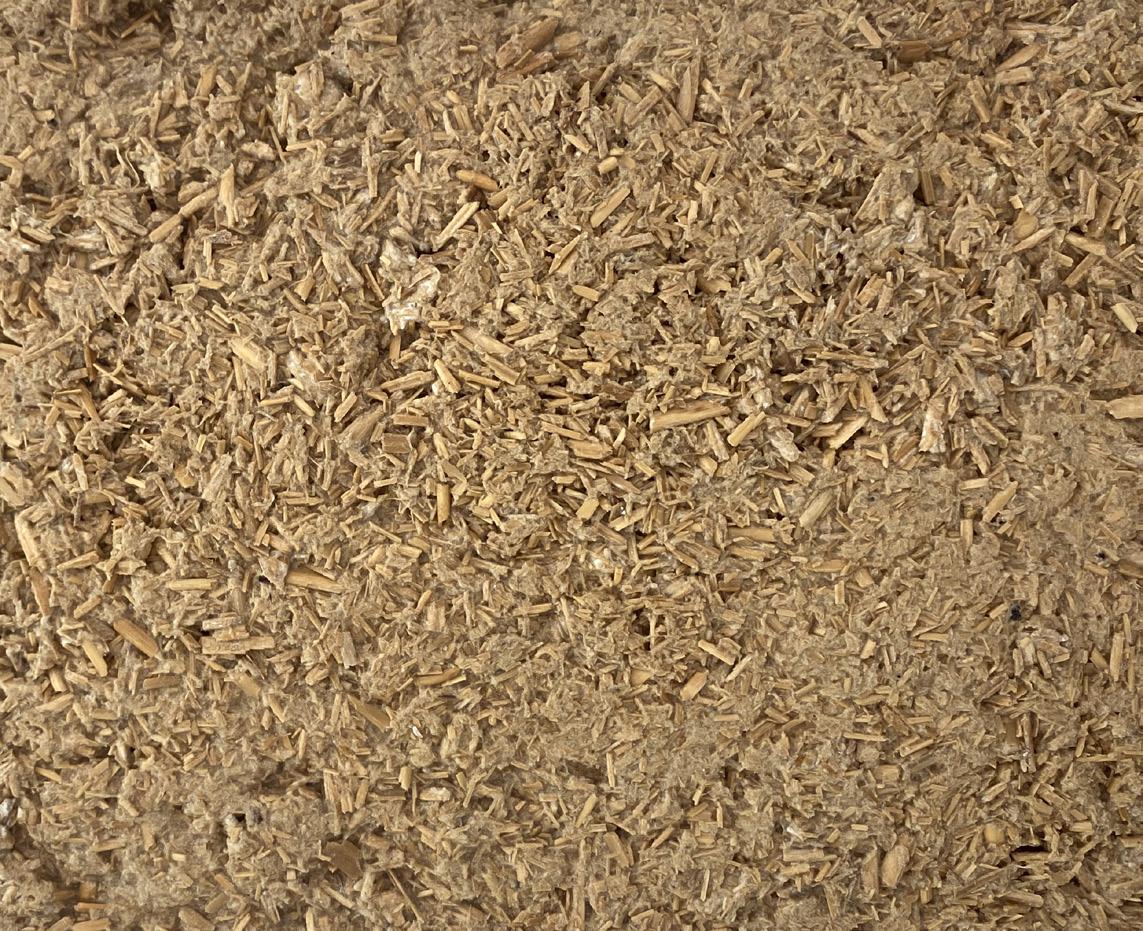
01

It turned out to be a series of relationships. I realized how every interaction with the mycelium led to different relationships. As it functions with people, those relationships I neglected rebelled and were disconnected (died), while those I was attentive and listened to lasted the longest.
I noticed how everyone talks about this organism. For people who don‘t know much about the topic, it seems bizarre and untouchable. For those working with it as a material, it‘s just that: a material difficult to handle. But talking with small cultivators (Paul and Fabia from Pilzfarm.ch), it seemed more than just food or material. It is a living individual that connects the world beneath us, and the more you read about it, the more you realize how ingraned it is in how ecosystems function, that why we need to be mindful of the consumption of this source as well.
We are depleting all of nature‘s resources and are drastically turning to alternative materials to save us from our own consumption. The truth is we shouldn‘t consume that much in the first place, and finding a replacement simply does not solve the problem.
This should not become a new source to exploit from, but a conscious reminder that they are organisms before being materials, and that sometimes small acts, like letting live, might have a bigger impact than we think.
It turned out to be a series of relationships. I realized how every interaction with the mycelium led to different relationships. As it functions with people, those relationships I neglected rebelled and were disconnected (died), while those I was attentive and listened to lasted the longest.
This should not be seen as a new source to exploit, but rather as a conscious reminder that they are organisms before they are materials. Embracing this perspective, we realize that small acts, like letting them live, can have a far-reaching impact. Let‘s work together in co-designing solutions that honors other lifeforms life and promote more long-term perspectives.
9 HYPHAE EXPERIMENTS

ABOUT MYCELIUM MYCELIUM AS A COOPERATIVE
PARTNER
Mycelium, the vegetative part of fungi, consists of a network of fine threads called hyphae. It only needs air, food and moisture, then it grows by extending and branching out, absorbing nutrients and breaking down organic matter through releasing enzymes. Mycelium forms symbiotic relationships with plants and other organisms, aids in nutrient exchange, and reproduces through spores released from fruiting bodies fro further spreading. Highly adaptable, mycelium thrives in diverse environments and plays a crucial role in nutrient recycling and biodegradation. Fungal mycelium is fascinating due to its nature as a living, complex adaptive system with emergent collective properties. Understanding mycelium‘s biology is key to utilizing its potential in various applications, including sustainable materials and bioremediation.
Cooperation is often seen as unexpected in nature because it appears to go against the principle of natural selection, which typically emphasizes competition and self-interest for survival. Despite the immediate costs and risks, cooperation involves complex coordination and sometimes self-sacrifice. Collaborating with nature, such as with living organisms like mycelium, challenges the traditional view of individualistic innovation driven solely by self-interest. Cooperative behaviors evolve to balance out long-term benefits for everyone. Understanding and utilizing natural processes can lead to more efficient resource use and less human-made waste, while also fostering a sense of responsibility to protect and nurture the environment by recognizing the interconnectedness of all life forms.
Consciously witnessing the growth of new developments over time, since nature is never static, allows us to observe the gradual development, dynamic changes, and adaptation to chance of these organisms, which often occurs over extended periods. Appreciating slow natural processes is a crucial aspect of this project.
TIME GROWTH
By observing growth, one witnesses the adaptability and potential of living organisms, which may inspire design solutions. It offers an opportunity to experience unexpected directions for design, including regeneration and healing processes. Maintaining an openminded approach allowed me to embrace the natural complexity and potential for surprises, leading to more holistic
AUTORSHIP
This offers a unique opportunity to indulge in an uncontrolling attitude towards creation. Working with living organisms like mycelium allows to collaborate, isnpire and explore ifordward-thinking possibilities and unconventional design approaches. This allows mycelium to guide and influence creative endeavors, leading to unexpected outcomes.
CURRENT FINDINGS
Several methods have been explored to utilize mycelium-based materials in design applications, it is primarily marketed for packaging and insulation this resource is recognized as renewable and biodegradable. It is used as an eco-friendly alternative, offering robust yet lightweight construction, with heat and sound insulation, moisture regulation, and carbon-negative attributes due to its low-energy, waste-free production process.
THE DILEMMA
But this current findings on mycelium reveal a troubling reality: the disregard of their natural properties and cultivating mycelium for the distruction. This prevalent misuse of living mycelium results in its destruction through exposure to heat.This heating process not only kills the mycelium but also removes most of the moisture from the product. This prevents the fungus from further growth. This not only goes against its natural potential but also contradicts the whole idea of sustainable design for everyone, merely human-centered. Undermining their very essence of natural processes and regeneration. Therefore they do not sustain the unique adaptive living properties.

MY APPROACH
Approach: Without subjecting the mycelium to heat, it can enter a dormant state, preserving its viability. This dormant state can be reactivated by rehydration for regeneration, further growth, reshaping, or the formation of fruit bodies.
My goal during this study is to manage this project with minimal waste and energy production, utilizing as few materials as possible.
RETROSPECTIVE
NOTE
For the entirity of my thesis, I used about 10 kg of substrate made of residue wood factorie (see Grown.bio), distributed in 3 bags, each with 1/10 content of mycelium spawn. This means I used just 1 kg of mycelium and, by nurturing the organism, I could reactivate old samples to grow new forms together with the mycelium. I worked in a system where I didn‘t rely on new material but shaped new forms and reconnected with the same volume and some water. The negative form for the beging samples were old ceramic dishes and reusable aluminium plates. All the wood applied for the binding experiments was residue material from the wood workshop.
11 HYPHAE EXPERIMENTS

MISCONCEPTION ABOUT MYCELIUM, MOLD OR FUNGI
First, there are about 2.2 to 3.8 million species of fungi on Earth, and we only associate with them in a limited way, such as in food, mold, or materials. Mycelium, unlike mold, is a safe root-like structure of fungi. Mold, a type of fungi, grows on food and damp surfaces, potentially harmful when inhaled.
During its process, mycelium undergoes a drying process to prevent fungal growth and spore production, ensuring safety during handling. This can be achieved with heat of 100 degrees or through air-drying. Already air-dried mycelium effectively halts any active fungal growth and spore production, making the mycelium stable and safe to use. However, standard precautions like wearing protective equipment are still advised when handling organic materials.
NATURE TALK
Talking with people who have already worked with mycelium, I noticed a widespread perception about natural surfaces. By consciously and smartly implementing them in alignment with their growth behavior, rather than against it, we can achieve results that respect their natural physique and aesthetic. Often, the focus is not on what the material is, but on how it could be in the product market. This leads to altering color, shape, and properties of the natural material, often making it non-degradable. Instead of changing our perspectives to embrace the natural structure, form, pattern, and color, we often alter the natural properties, transforming it into something else and missing the visually intriguing and dynamic surfaces that change with light and point of view through their porosity. This usually happens because we want to compete with other materials and conventional design markets, requiring chemical processing to make mycelium as leathery as leather, as seen from previous alternative inventions.
Despite the nature talk surrounding it, mycelium is not far removed from completely synthetic fake leather materials. Another danger lies in the long-term consequences of calling it a substitute. It will be treated as leather without having the same properties as leather. Therefore, I find it a better solution not to label it as an existing material it is trying to emulate, but rather as what it truly is. That is honest design.
Unprocessed mycelium often has a rough, unpolished surface, giving it a unique aesthetic. Of course, for packaging, the surface isn’t as important, but I want to embrace mycelium’s aesthetic to create a unique product instead of an alternative to something else. Like wood, where cracks are forgiven in design, the bumpy surface of mycelium can be used as a visual element, adding excitement and variety to otherwise monotonous patterns.

13 HYPHAE EXPERIMENTS
RESEARCH
Regarding fungi in the food industry, mushroom farm nutrition systems, and innovation in materiality
First, I gathered information and material samples from mushroom farms, researchers, and mycelium building material manufacturers to understand how they effectively prepare the substrate for food or packaging material. I learned that ingredients, mushroom species, mixing ratios, shaping, environment, and other interventions play crucial roles in achieving goal-oriented growth and consistency. Given the advanced state of research, I did not attempt to reinvent the wheel. Instead, I focused on establishing contacts with these industries.
I noticed that I didn‘t have the time to cultivate mycelium from the start, so I reached out to firms that could provide me with prepared mycelium for further growth. The knowledge about growing and handling living materials


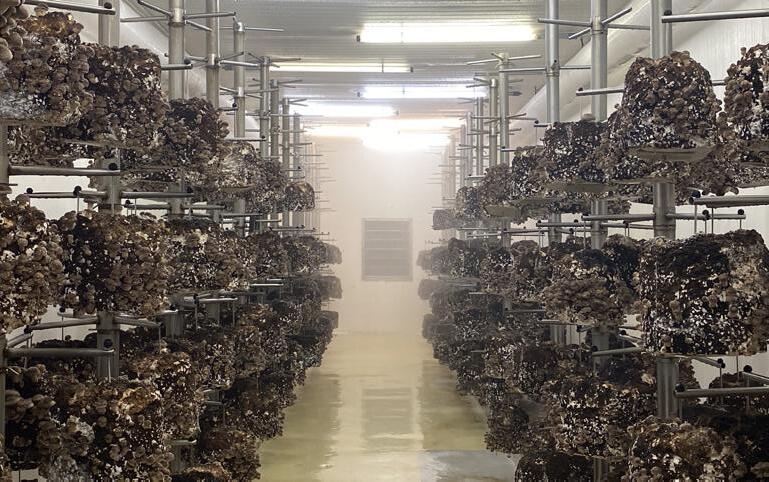
Insight about fungi and substrate
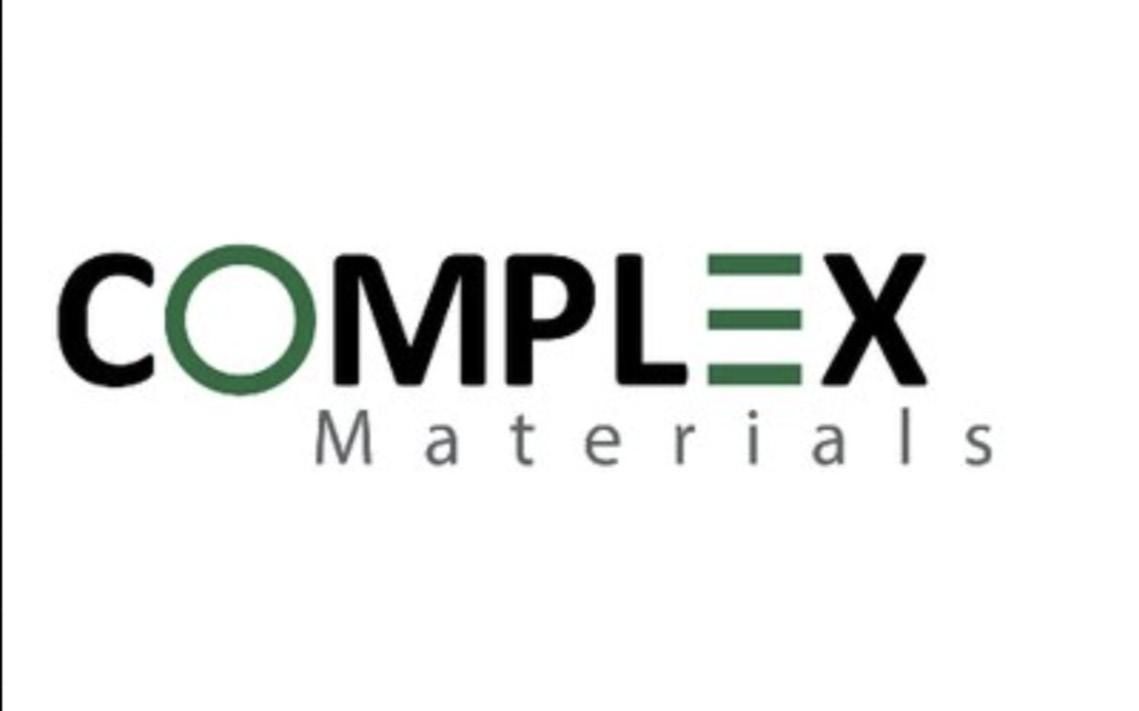
Insight about fungi and substrate
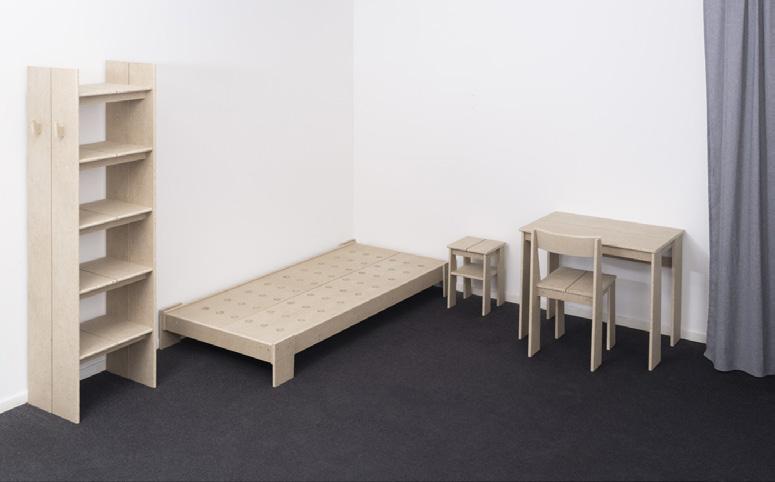
Insight about living materials
Insight about mycelium in design
Insight about fungi and substrate
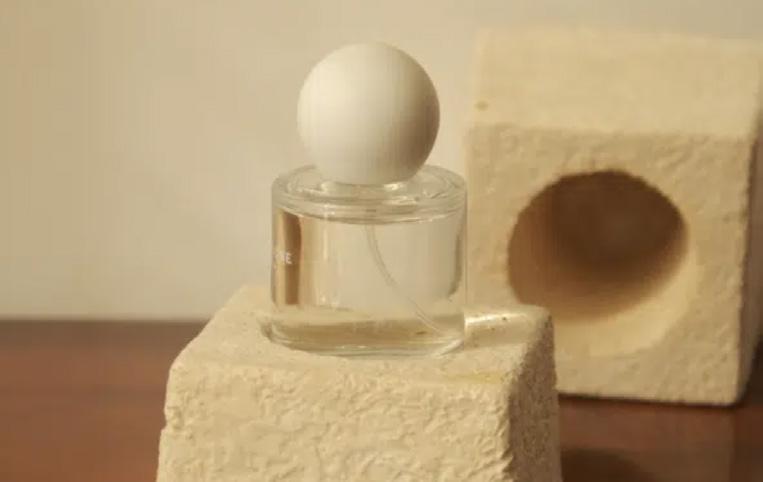
Insight about substrate and mycelium packaging
15 HYPHAE EXPERIMENTS
Pilzfarm
Kernser Edelpilz
Fine Funghi
ETH - Complex Materials
Grown.bio
Frederik Buchmann
MYCELIUM JOURNAL

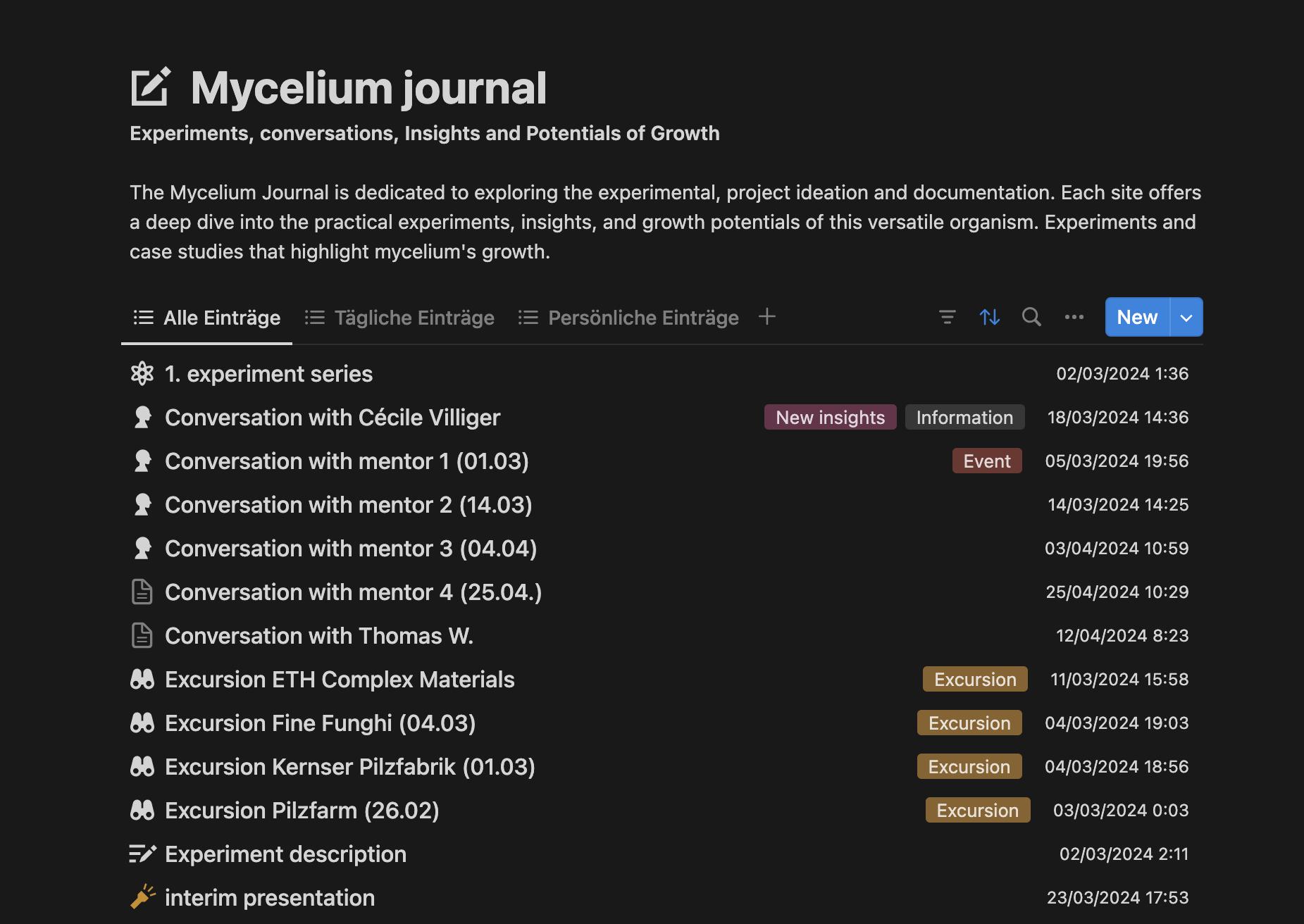
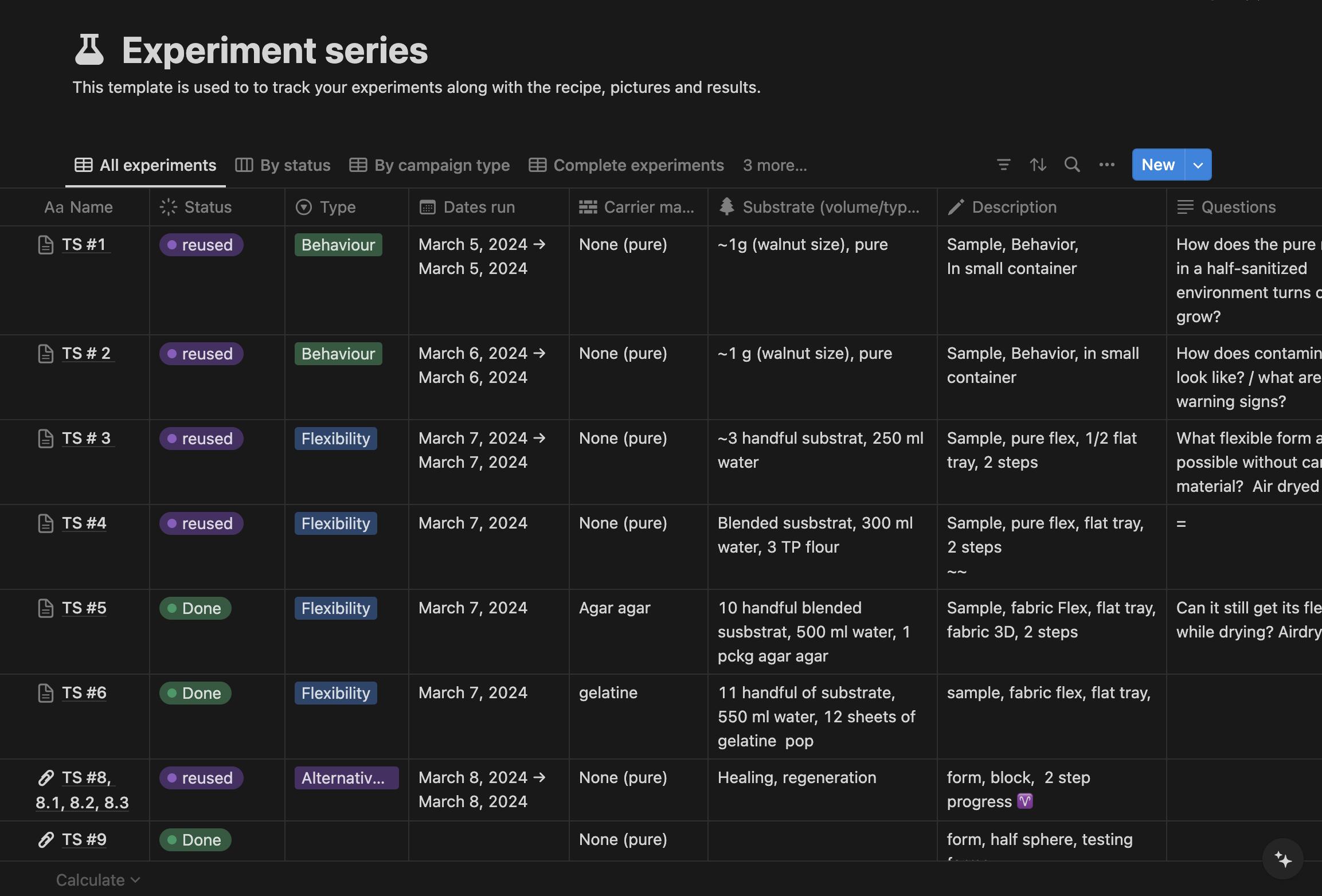
17 HYPHAE EXPERIMENTS
GROWTH
exploring mycelium experiments

02

TYPES OF FUNGI SPAWN SUBSTRATE
I will work with Pleurotus ostreatus, commonly known as oyster mushrooms, is an the choice for mycelium spawn material especially for beginners, due to its rather faster growth rate and adaptability to various substrates. It can thrive on a wide range of organic materials, including straw, coffee grounds, and sawdust. Additionally, its resilient nature allows it to outcompete contaminants, reducing the risk of failure during cultivation.
Grain spawn is the best type for mushroom cultivation due to its high nutrient content and ease of distribution. Made from sterilized grains like rye or millet, it effectively inoculates bulk substrates, promoting rapid and uniform mycelium growth. Its versatility and nutrient richness make it ideal for both beginners and experienced growers. It could also be used with saw dust and other variants.
The most commonly used substrate for grains is straw or other natural fibers, as mycelium can grow on them and they provide the most robust material for mycelium cultivation. Due to the time-consuming nature of cultivating various types of fungi with spawn and then mixing them with substrate, I reached out to Grown.bio, a Dutch company that provides ready-made substrate. This allows me to focus on growth development, experimenting with diverse mixtures and forming the design.
19 HYPHAE
SUSBTRATE
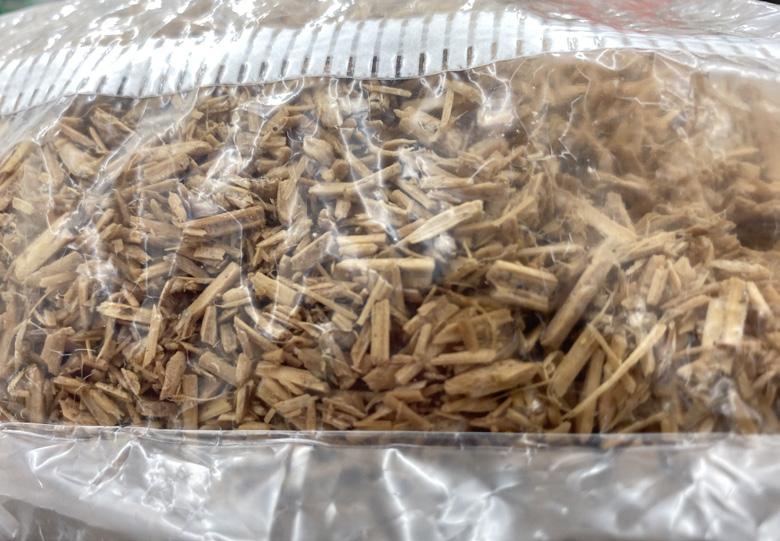

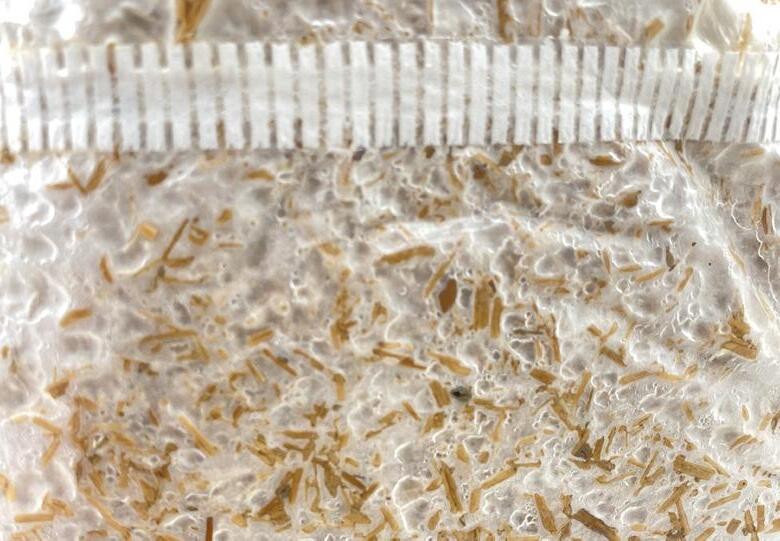



MOVING AWAY FROM ONE-WAY UTENSILS
Transitioning from single-use to washable utensils in research is crucial for sustainability. This involves incorporating durable materials like ceramic forms, which are easy to sterilize and reuse. Using disinfectants such as 70% ethanol ensures these utensils remain clean and safe for repeated use. This shift reduces waste, lowers our carbon footprint, and demonstrates a commitment to sustainable practices, aligning both our methods and products with our environmental goals.





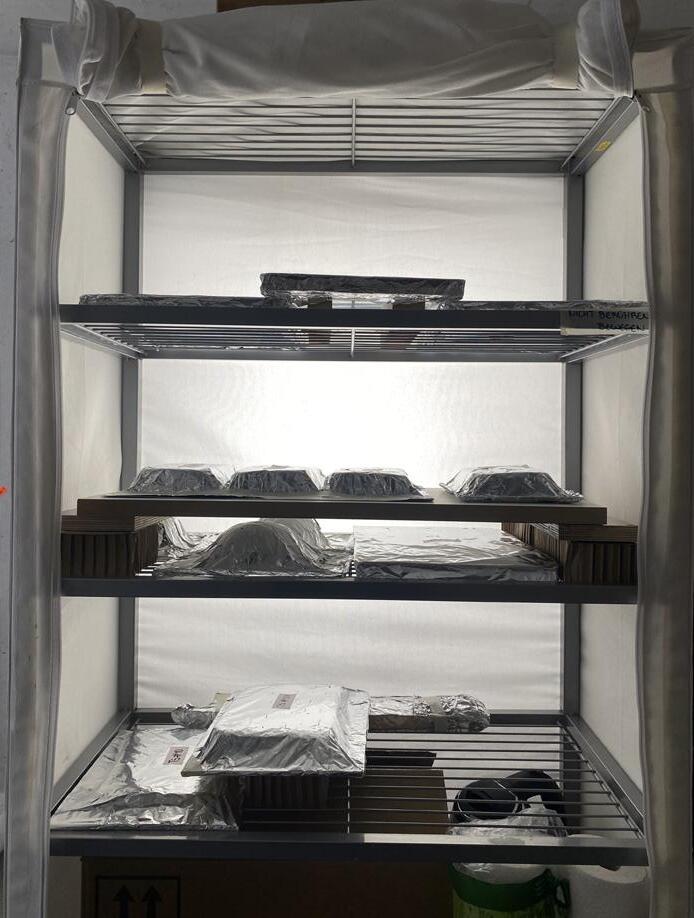
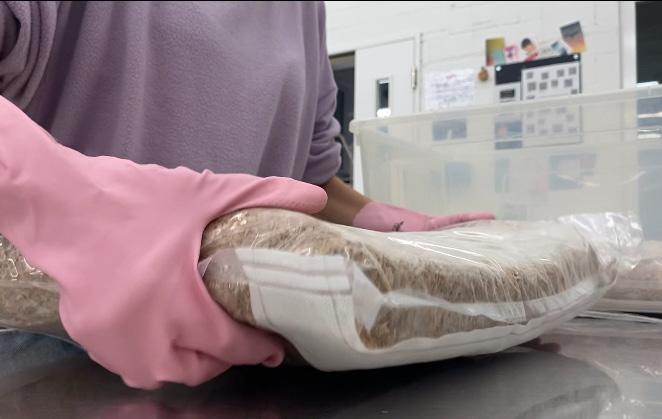
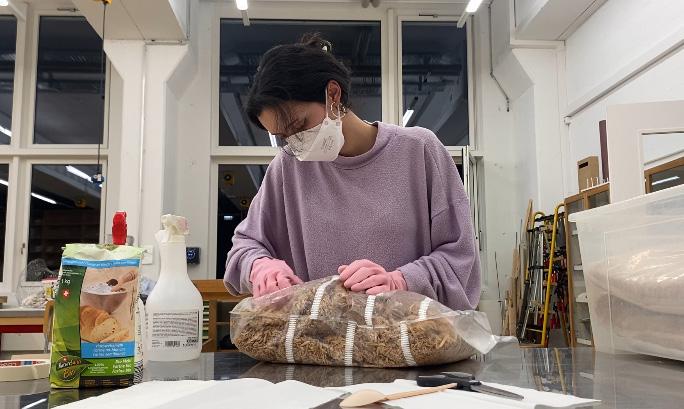
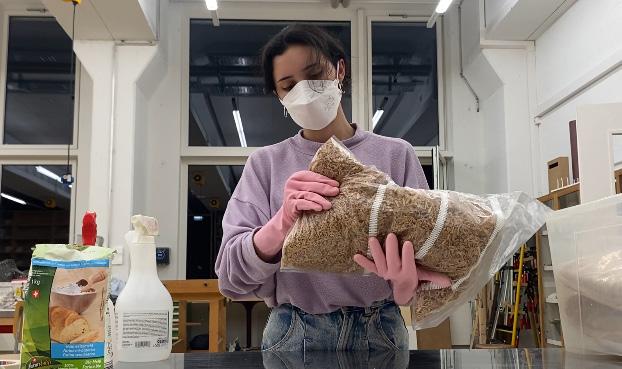
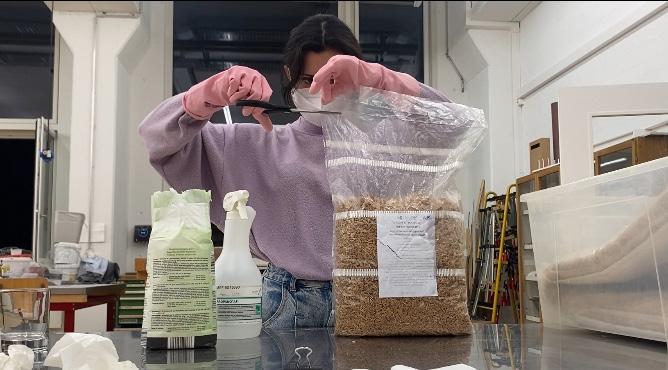
23 HYPHAE EXPERIMENTS
EXPERIMENT 1
EXPLORING MYCELIUM
PURPOSE
First attempt of growth observation and filament growth behavior. Getting to know my partner.
RECIPE
200 g substrate
100g water
3 Spoon flour
GROWTH
It started to build the filaments surprisenly fast. Hyphae builds up already after a few days, strengthes in a week and dries up naturally in additional days. So, although it is in indeed a slow process of two week for the growing part it stil is faster when we consider we need a 18 years to fully develope, trees as well need decades to grow too.







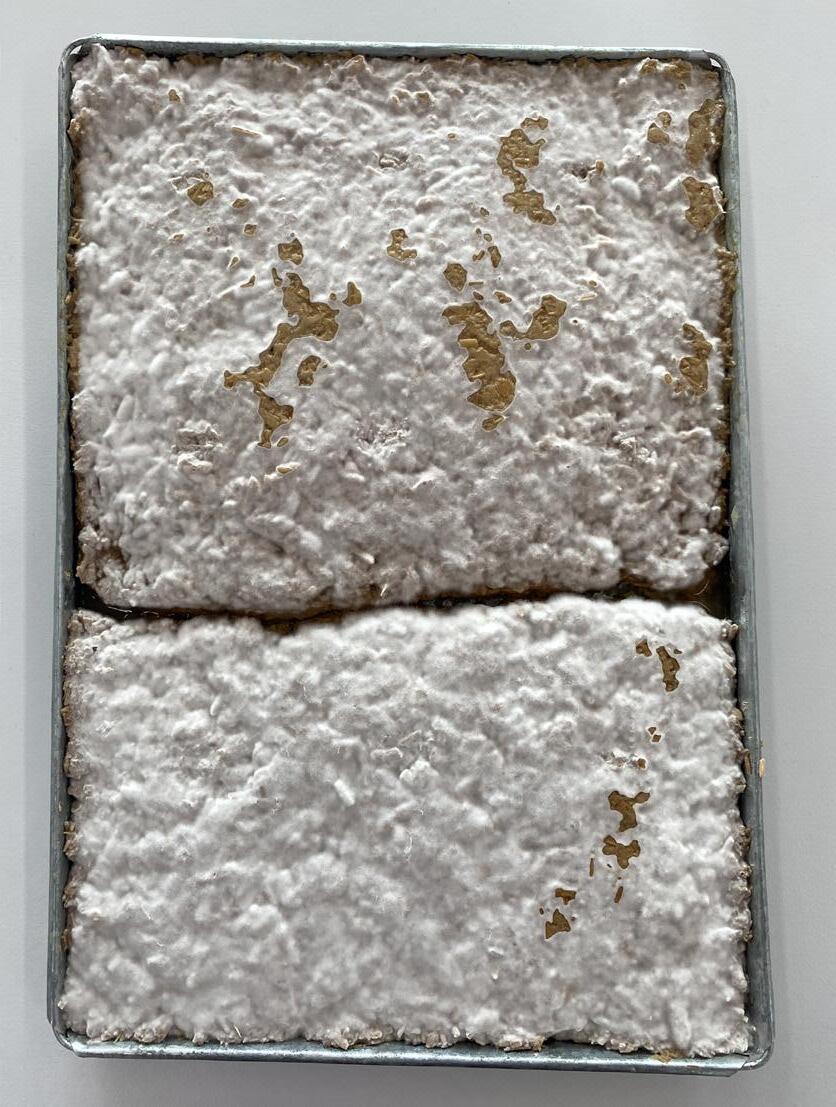


First attempt of growth observation and filament growth behavior. Getting to know my partner.

HYPHAE
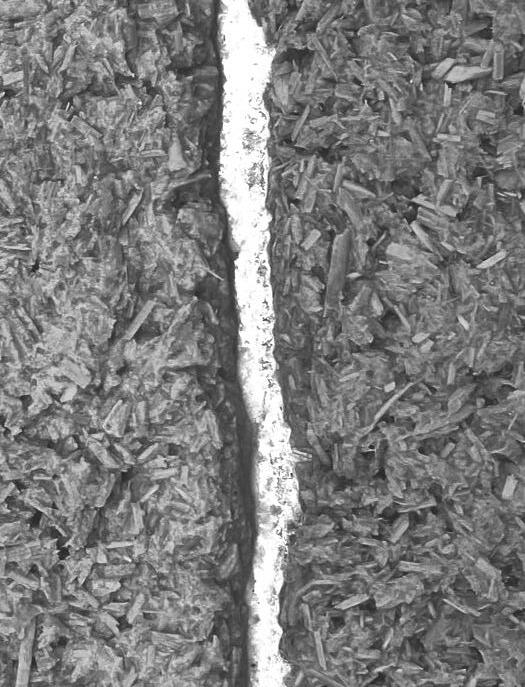


27 HYPHAE EXPERIMENTS
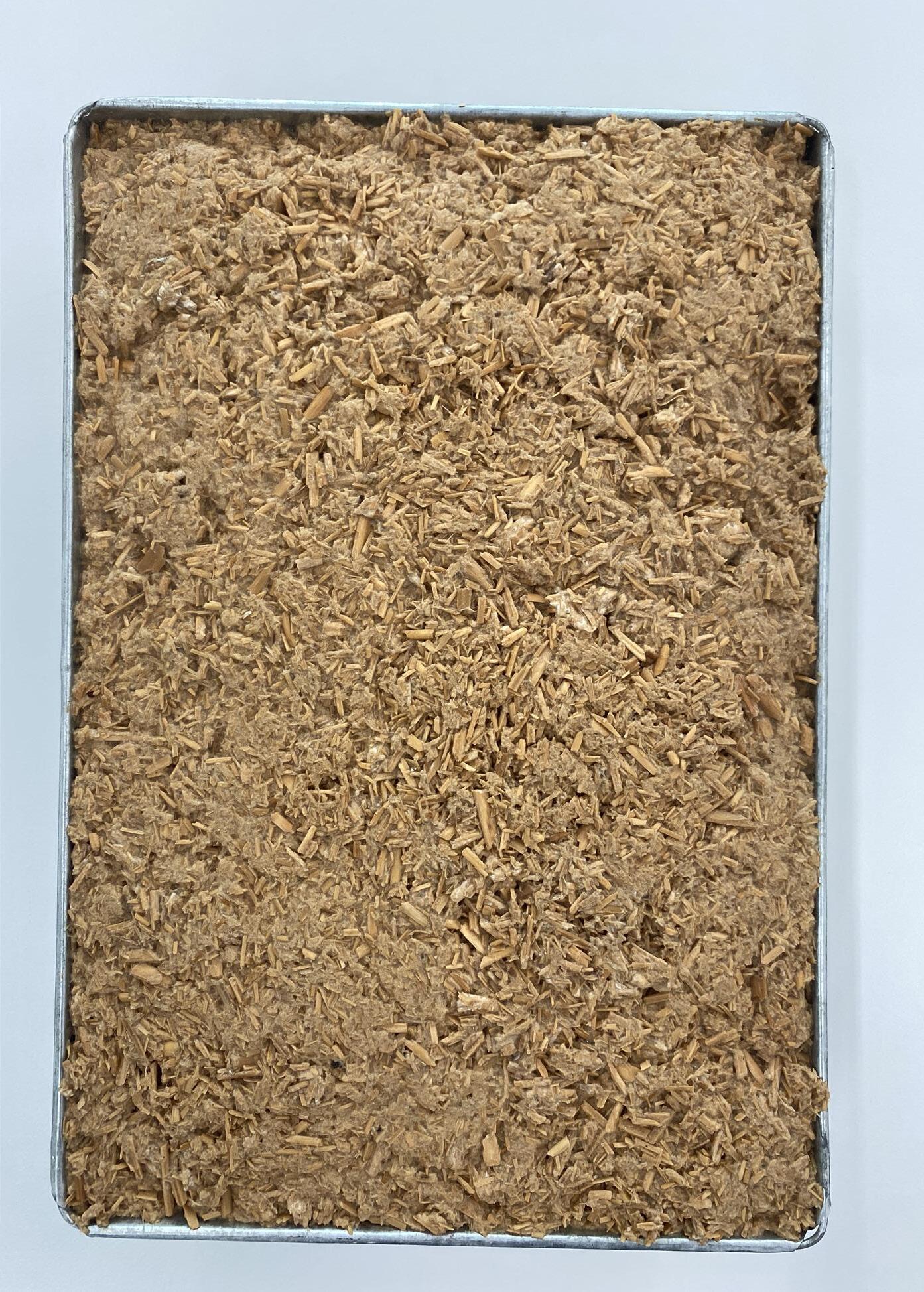

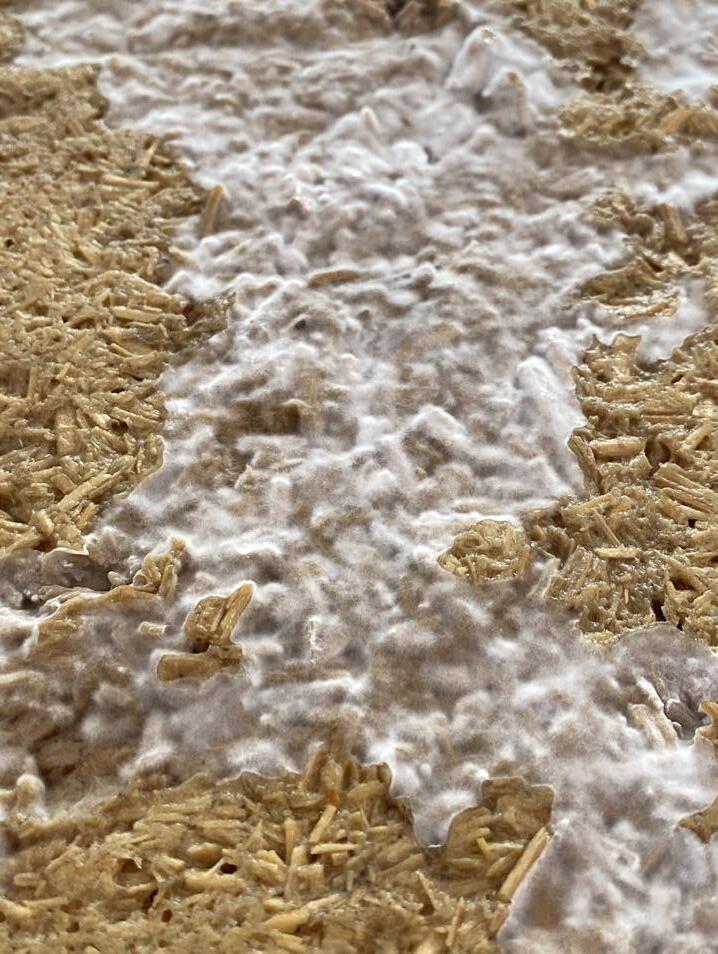


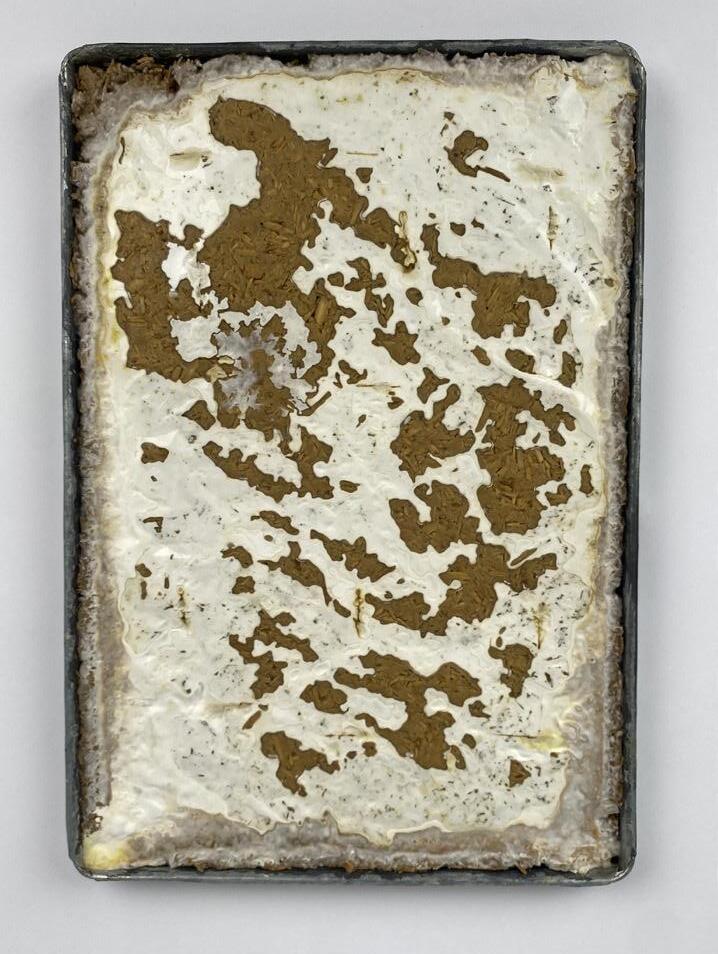

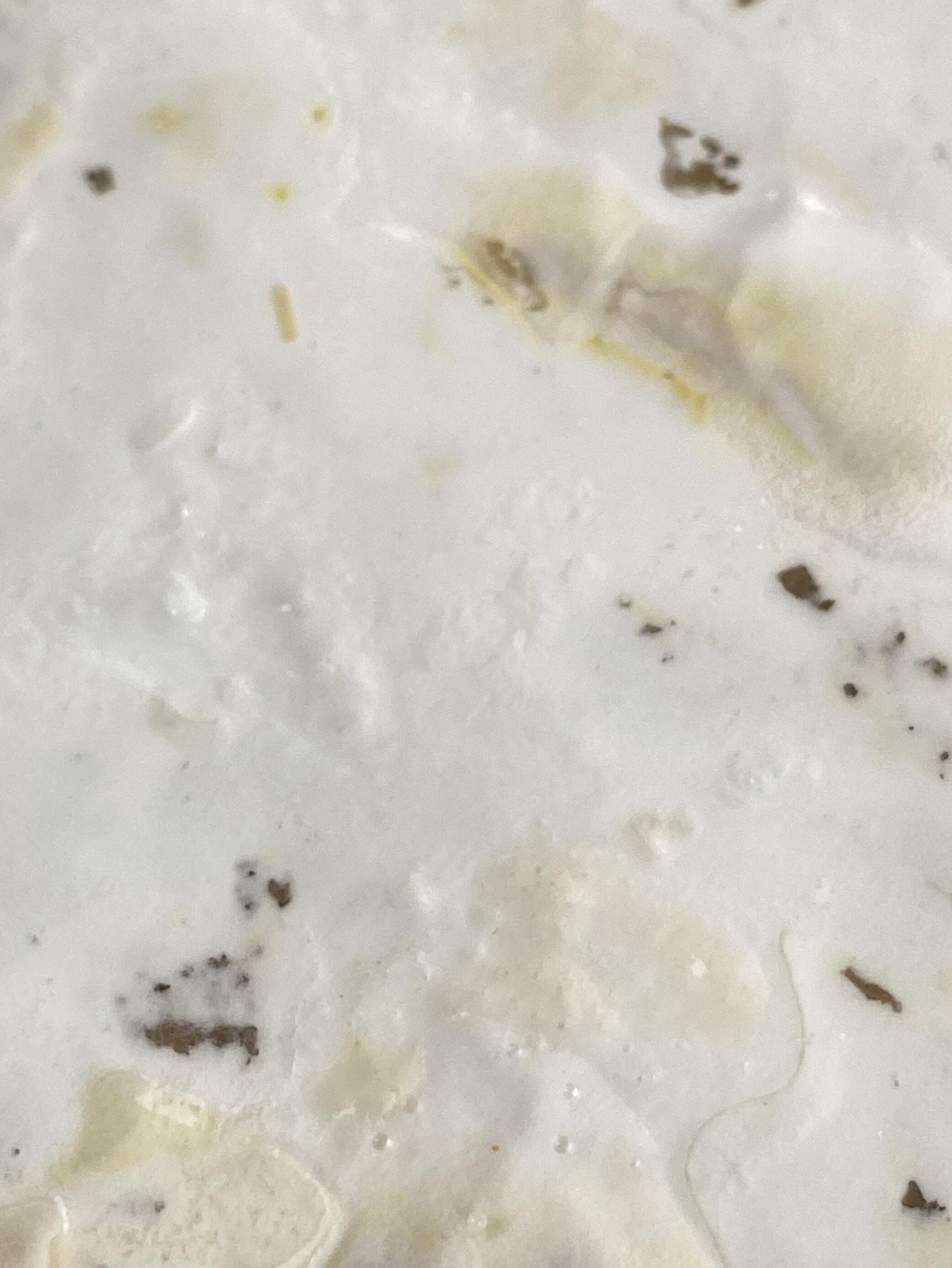
29 HYPHAE EXPERIMENTS
EXPERIMENT 2
EXPLORING WITH FABRIC

Technology from fabric composit fabric, compound material containing fiber for reinforcement
PURPOSE
Reinforced matrix made of fabric as a bedding form. The fabric is to be tested for flexible deformation and reinforcement in the dry state. This can be used to test whether fabric offers an improvement in shaping.
In first test the mycelium is placed over the fabric, the thesis is that either it growts together or it it grows a specicitic surface, an imprint of the fabric.
In the second test, the fabric is placed in between as a sandwich method to test its capabilities
RECIPE
200 g substrate
100g water
3 Spoon water
GROWTH
It started to build the filaments surprisenly fast arounf the textile. The second try in which the textile was in the middle made it possible for me to bend the whole structure while still growing without dettachment but the down side is the non-degradability of textiles o thats why i drop it off.
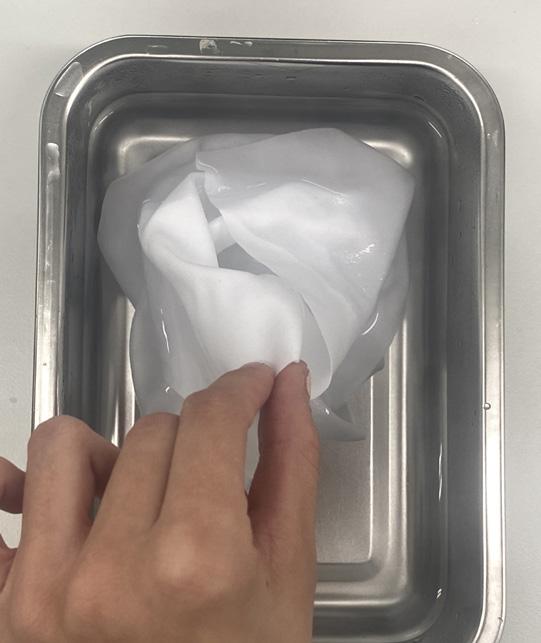


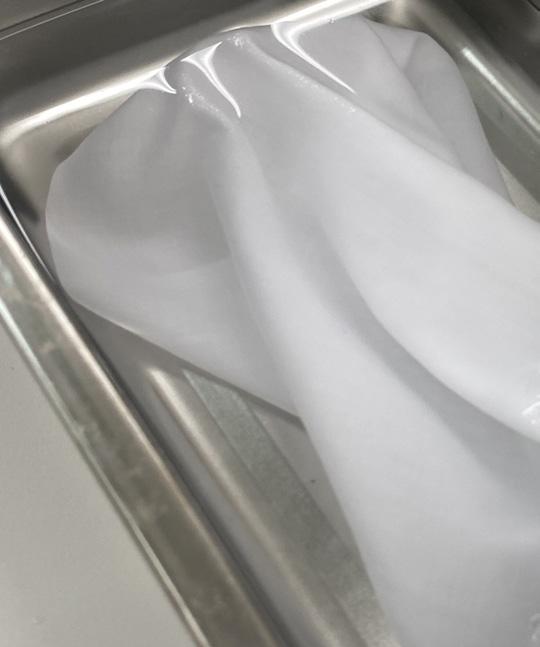

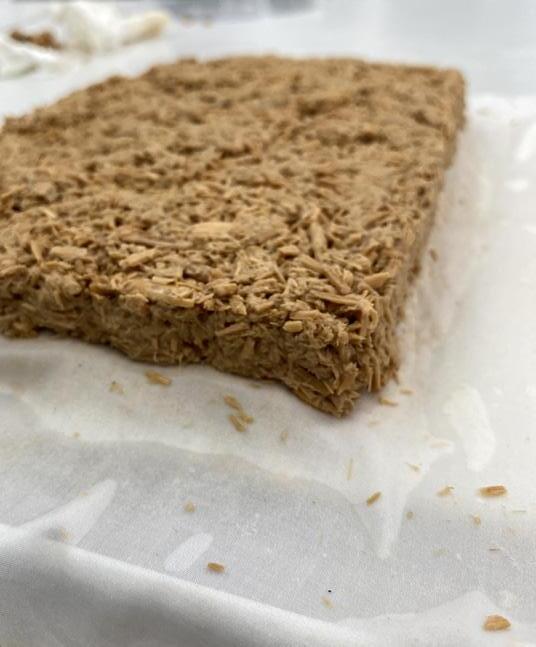



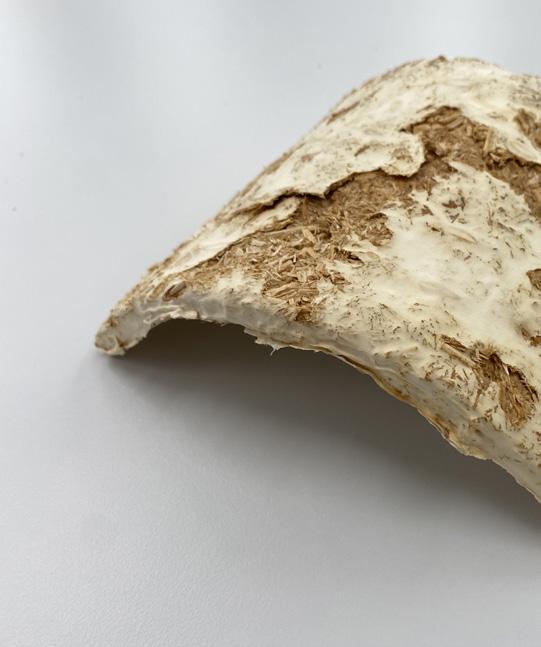

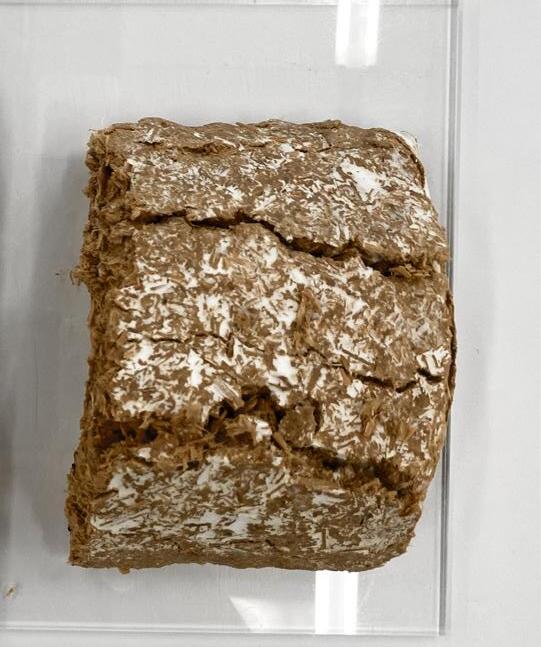

31 HYPHAE EXPERIMENTS

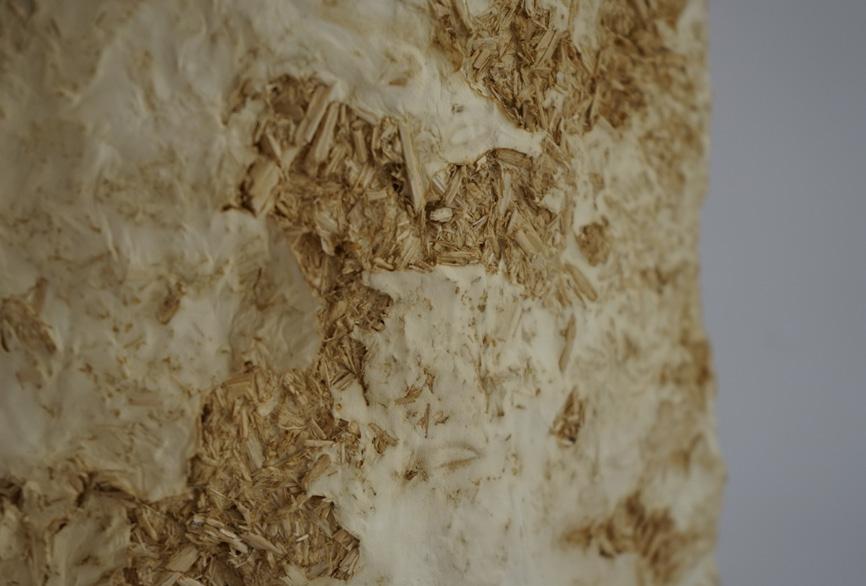

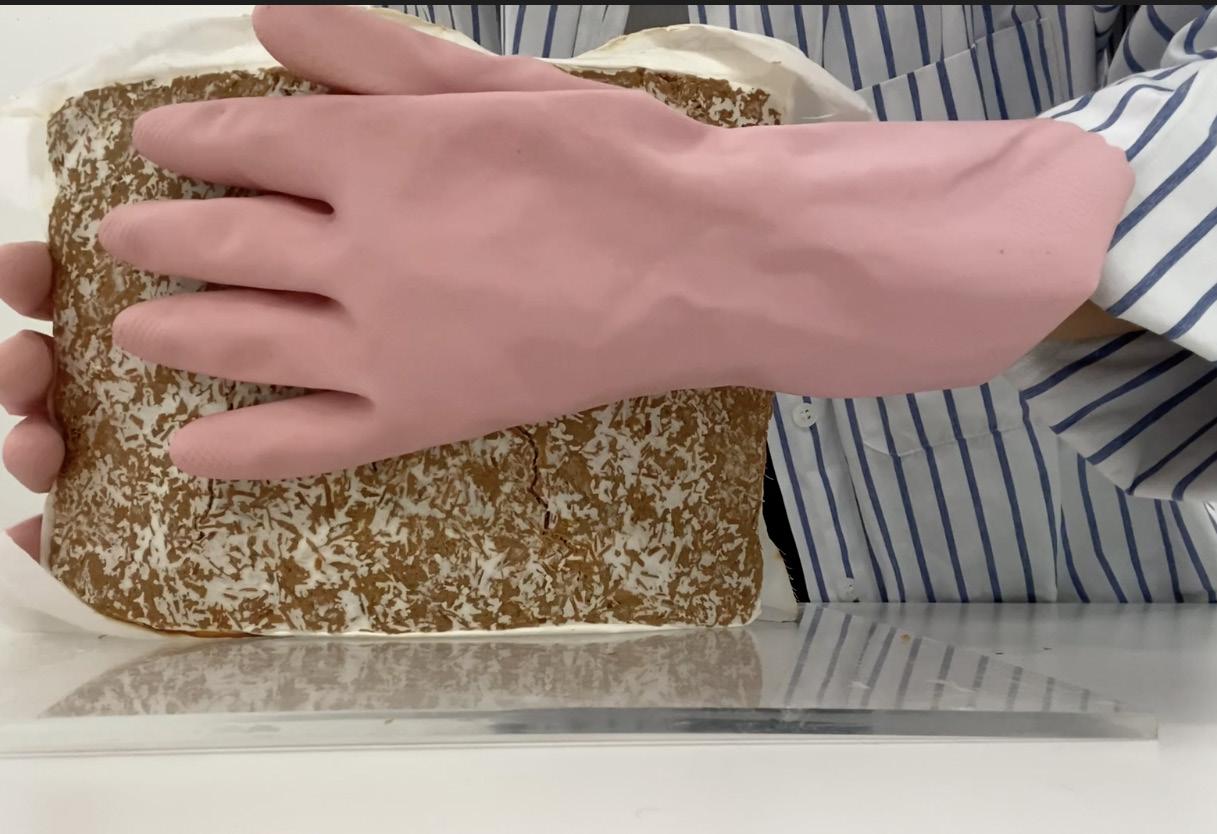


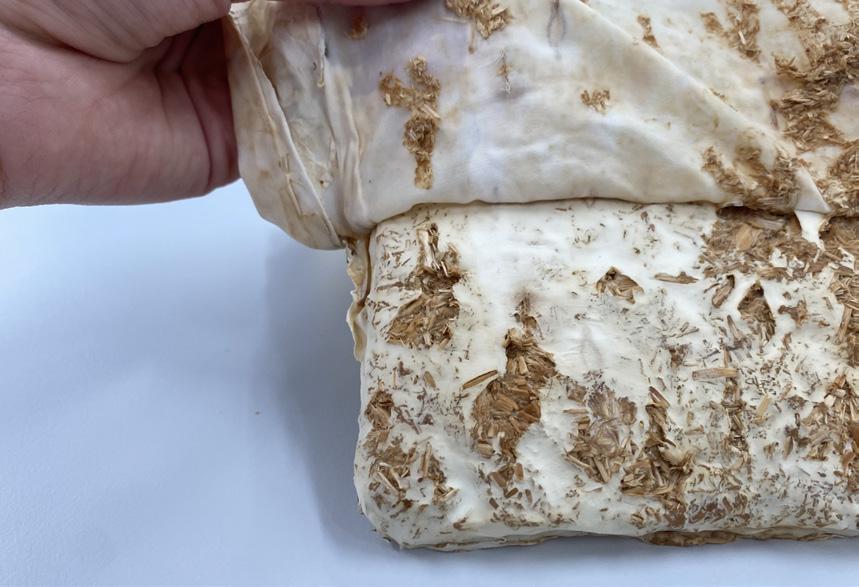
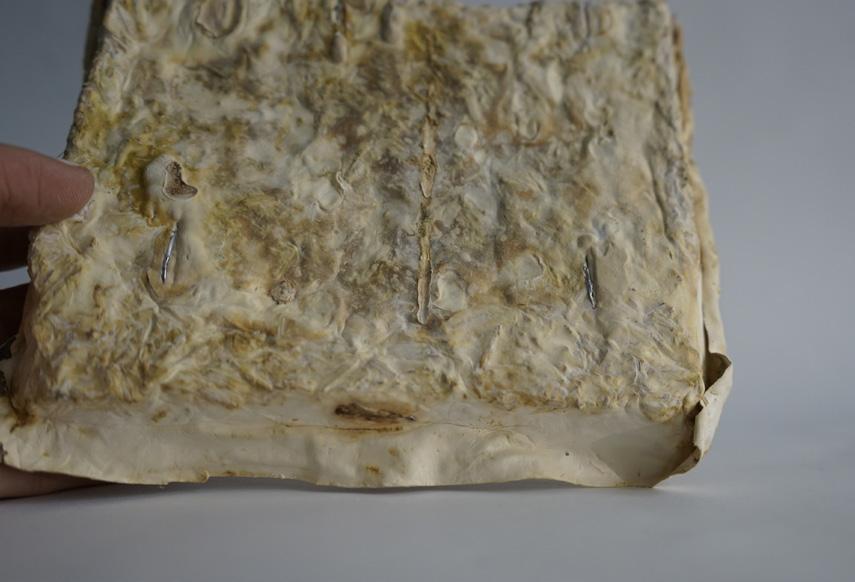
EXPERIMENT 3
BIO-WELDING OF ORGANIC SHAPES
PURPOSE
Here I want to explore the chances and circumstances under which mycelium can form curved surfaces, a feature that is less achievable with other binders in this organic matter.
GROWTH
The half-spheres grew in about four days and welded together without any pressure. The half-spheres glued together so well that force was needed to take them apart afterward.


33 HYPHAE EXPERIMENTS

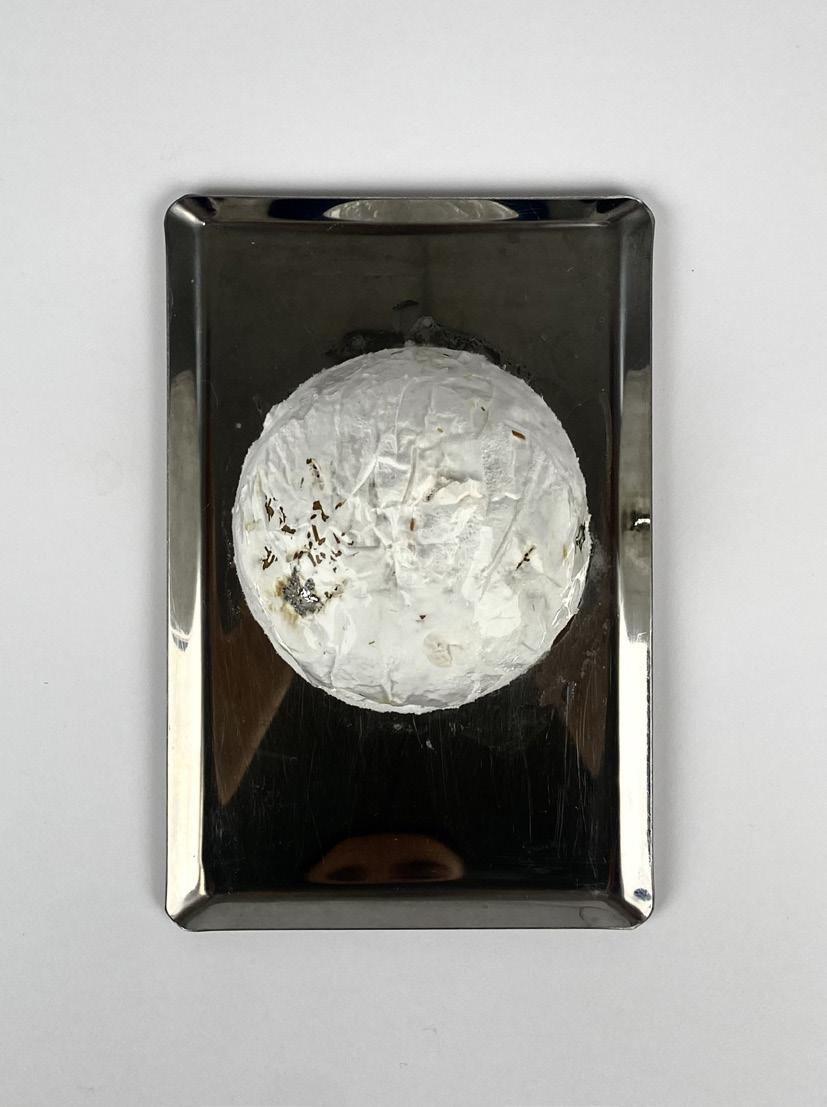

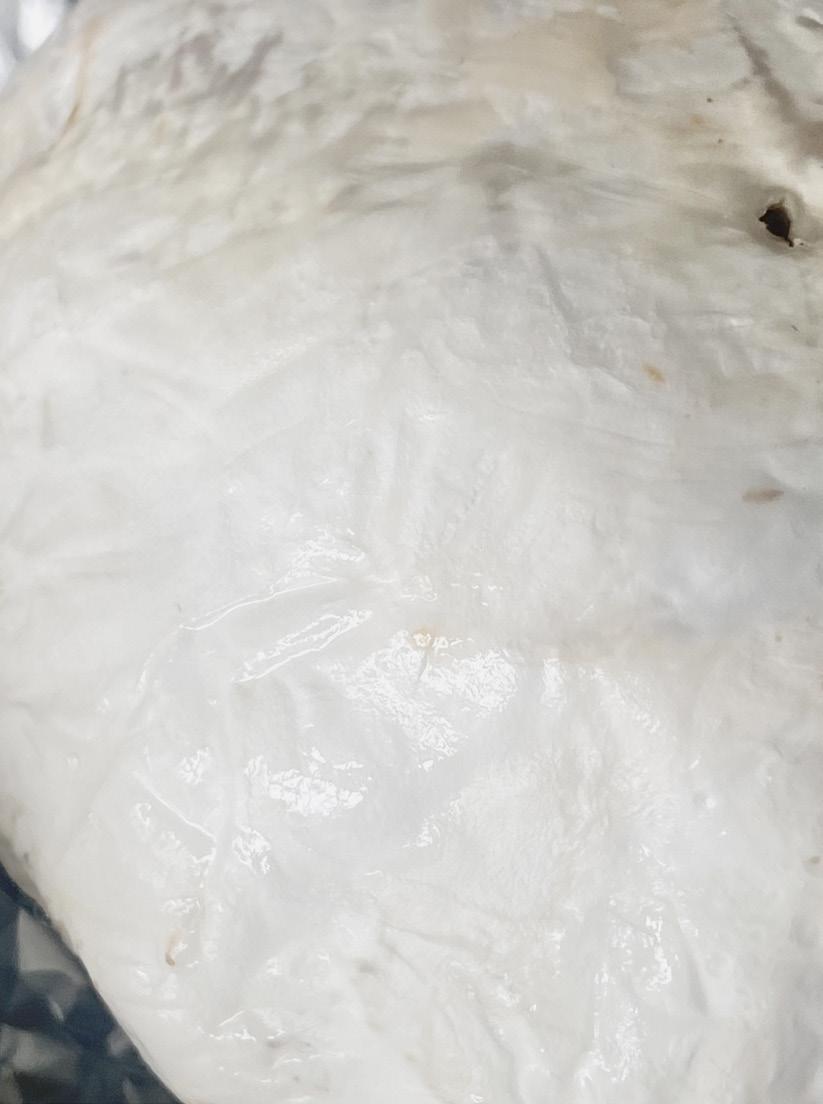


The dried half spheres were joined together by applying water and sealing them off from airflow and sunlight for a few days. The moisture trapped inside the structure revitalizes the mycelium, encouraging it to spread and bond the structure together uniformly, irrespective of the surface texture.




35 HYPHAE EXPERIMENTS
EXPERIMENT 4
REGENERATION AND HEALING TIME ATTACHMENT OF UNCONVENSIONAL SURFACES
MODULAR USE OF SINGUALR FORMS



PURPOSE GROWTH
By creating conventional forms out of mycelium, I want to test how they can attach to each other (and later to other materials). The bio-welding can be demonstrated by arranging these blocks in different variations and assessing their attachment quality, as well as by bonding unconventional forms together.
Instead of using a plastic negative form, I decided to work with a ceramic mold. By doing so, I needed to press the mycelium slightly to ensure it attached together without the mold. Conversations with Cecile Villiger, a biologist from Fine Funghi, made me aware of the danger of pressing it too much before growth. Excessive pressure or adding too much water can deprive the mycelium of sufficient air, causing it to grow only on the surface. However, since my intention is to test the natural healing of mycelium, this did not pose a significant issue.



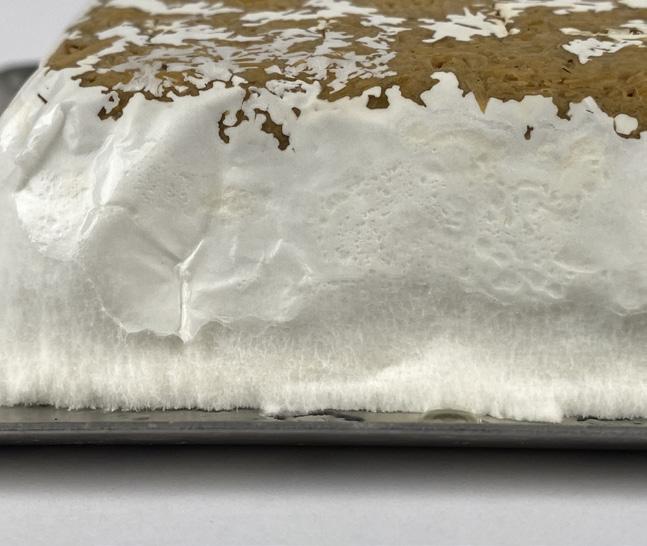




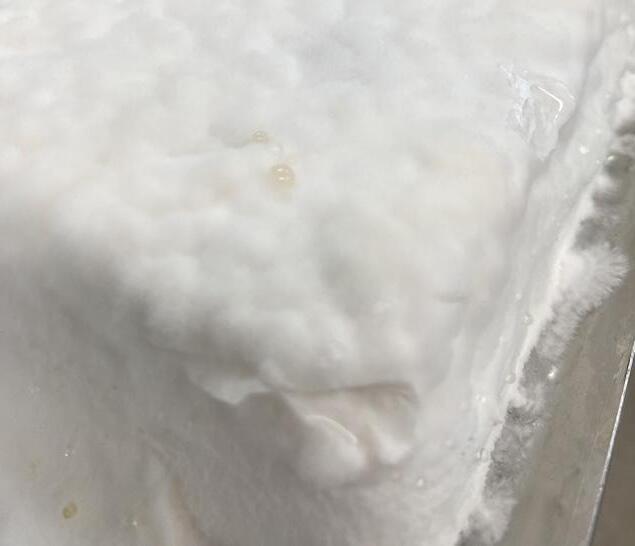
37 HYPHAE EXPERIMENTS
HEALING AND BIO-WELDING
regeneration of tissue natural binder
100% reusability
0% waste
03

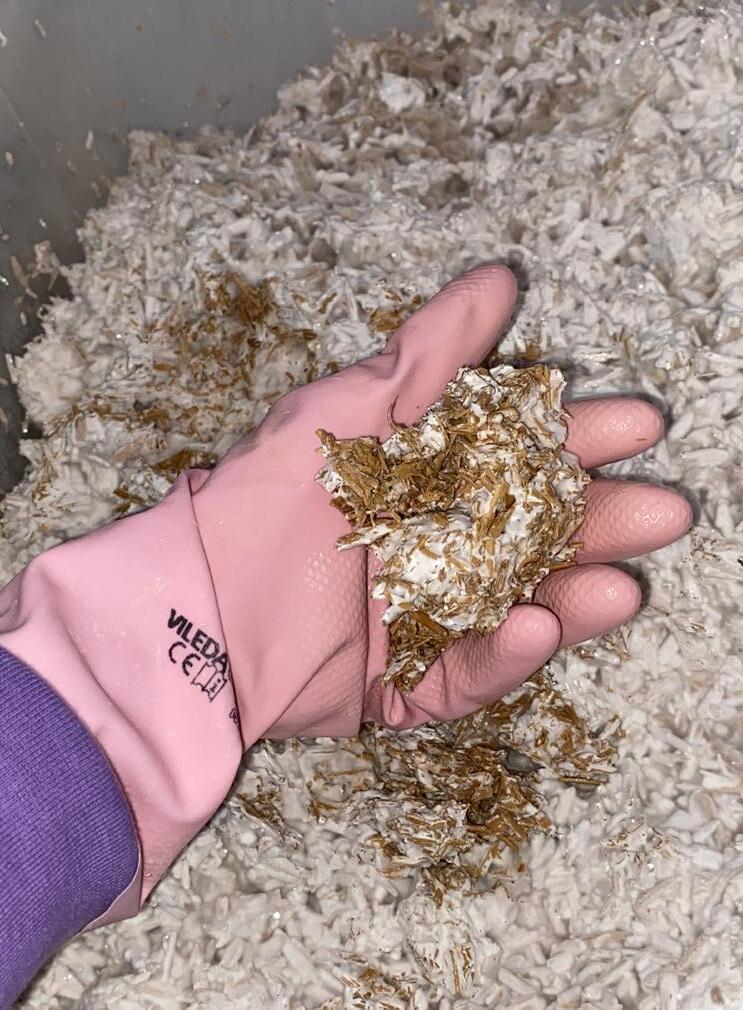
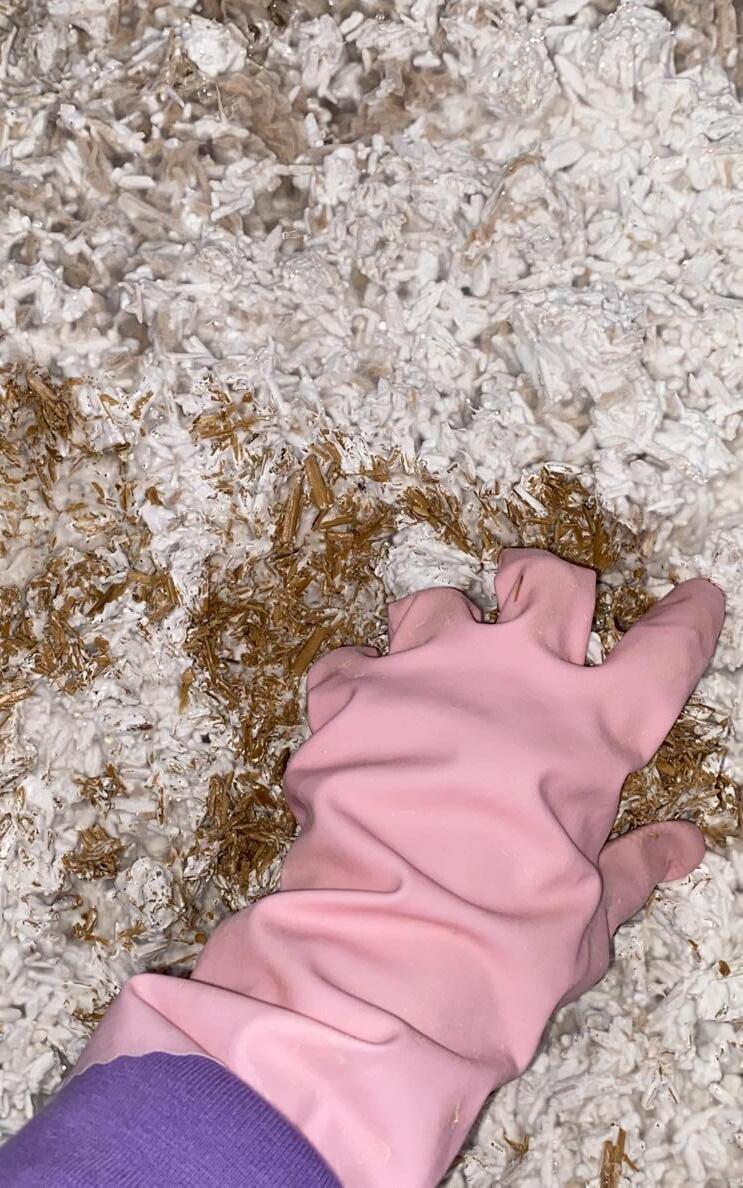
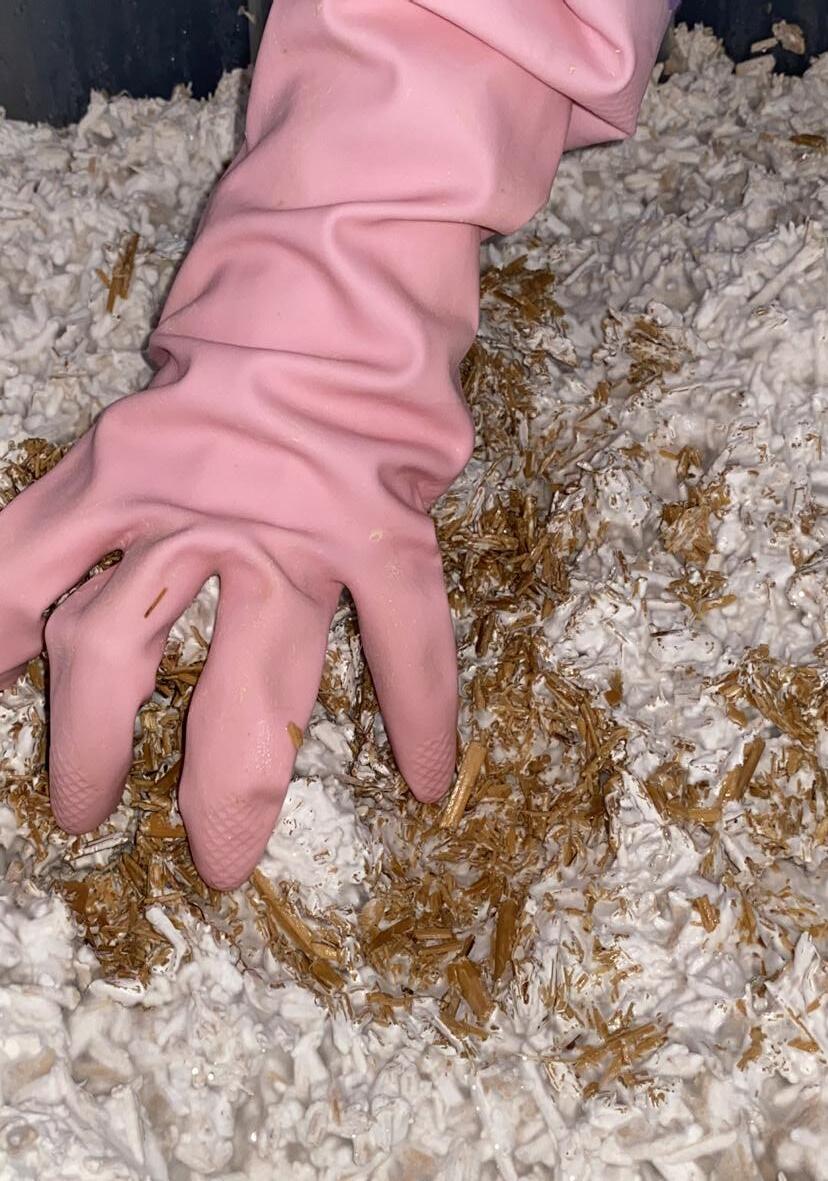
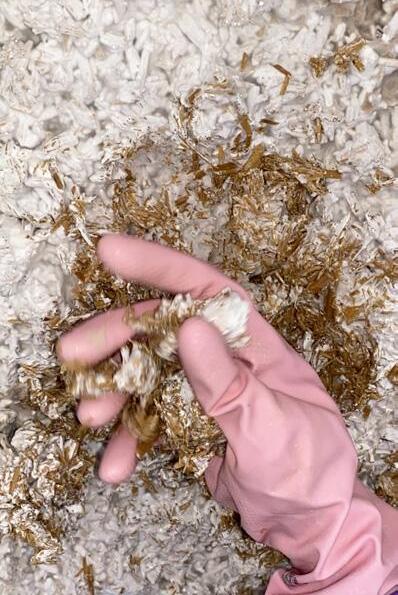
39 HYPHAE EXPERIMENTS
REGENERATION
A bioremediation system for creosote-treated wood is proposed, based on the detoxifying capability of Pleurotus ostreatus, a ligninolythic fungus. Non-sterilized chipped contaminated wood was mixed at various ratios with wheat straw on which Pleurotus mycelia was grown.

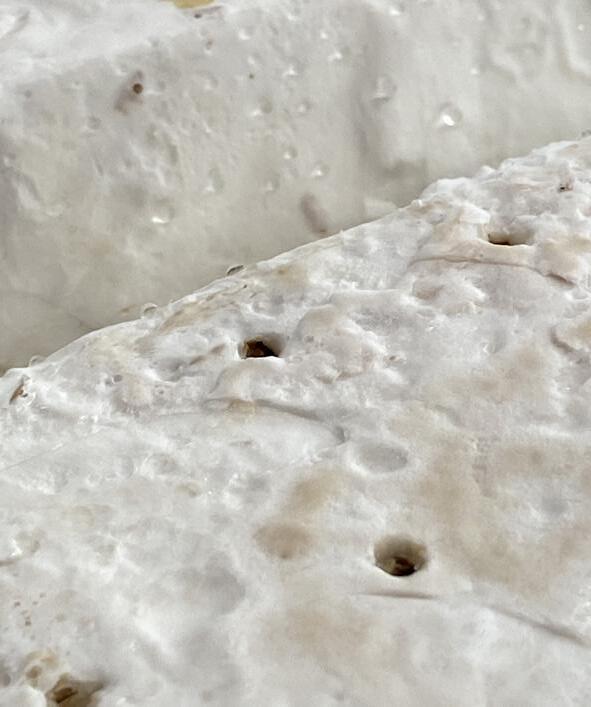




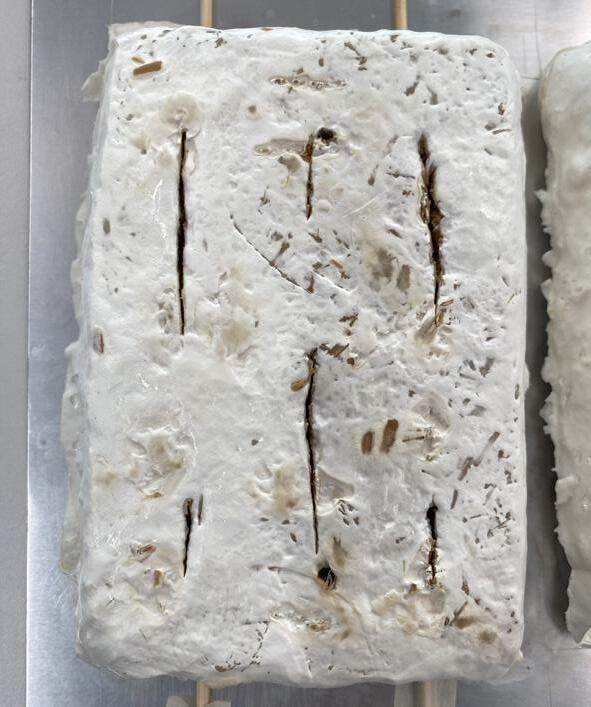


HEALING
MINOR SCRATCHES
To test the healing duration and quality of regrowth, I made small cuts and poked tiny holes in the surface. The holes were almost invisible after just three days, and the scratches healed too, although they left more visible marks. Overall, it healed rapidly, indicating the potential to repair surfaces after breakage or damage.
LARGE DAMAGES
For the next experiment, I focused on large surfaces to evaluate the healing duration and quality of regrowth on a broader scale. I created reactangualr cuts across expansive areas of the material. Over the following days, I monitored the healing process closely. The larger cuts and holes initially showed more visible damage, but after a week, the surfaces began to show signs of regeneration. By the end of two weeks, most of the large punctures were significantly reduced, and the cuts had healed considerably, although some visible marks remained. This experiment demonstrated that even large surfaces possess a remarkable ability to repair themselves after major damage, suggesting robust regenerative properties.




41 HYPHAE EXPERIMENTS
MODULAR BUILDING FORMS
Building blocks are known in the mycelium material world. While trying to attach them together after an air-dried state, I was able to weld the individual pieces together. This means that the building blocks can be arranged in any form to fit a larger pattern, holding together with just one material.
This opens up the possibilities to construct structures such as customized modular furniture, partitions, and walls.


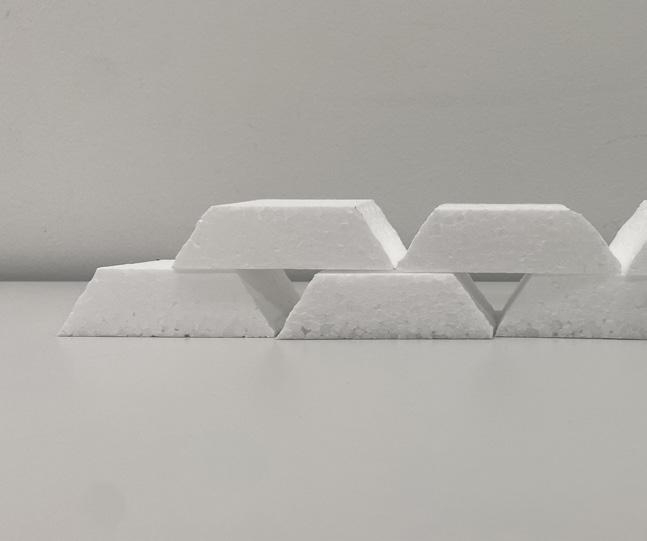

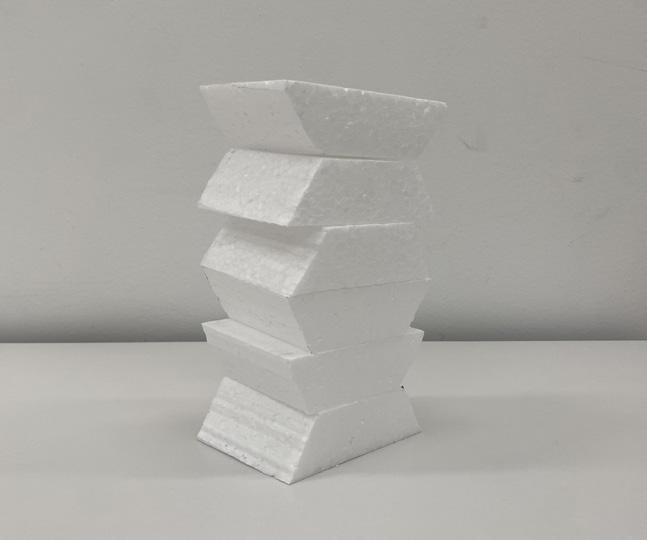

BIO-WELDING





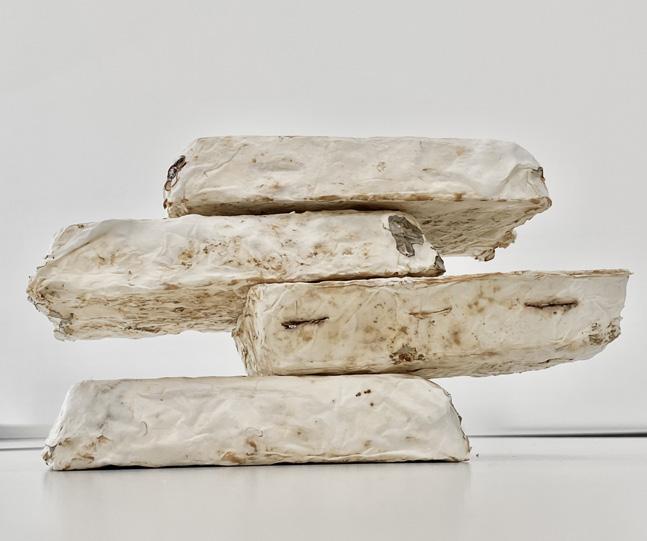
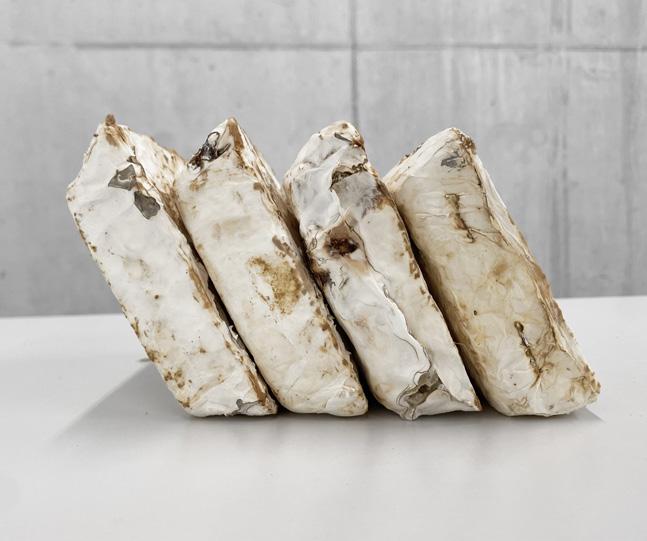





Exploring possibilities of welding forms together
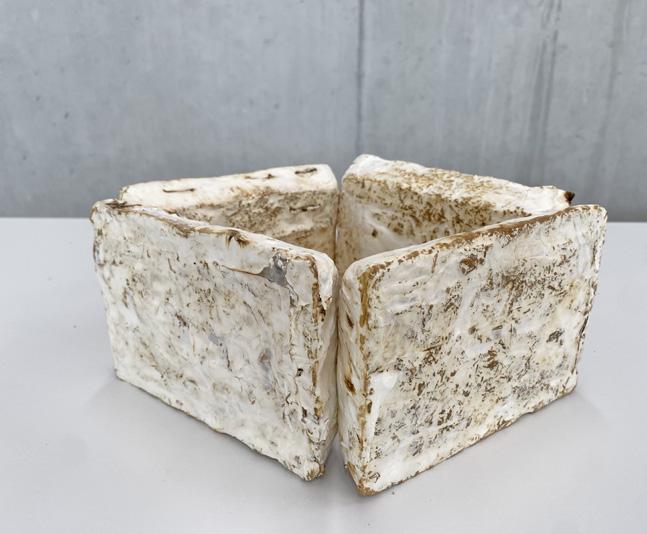

43 HYPHAE EXPERIMENTS
was reactivated and then down from the sides. This process moisturizing and drying the mybefore carefully grinding the edges the desired shape and surface

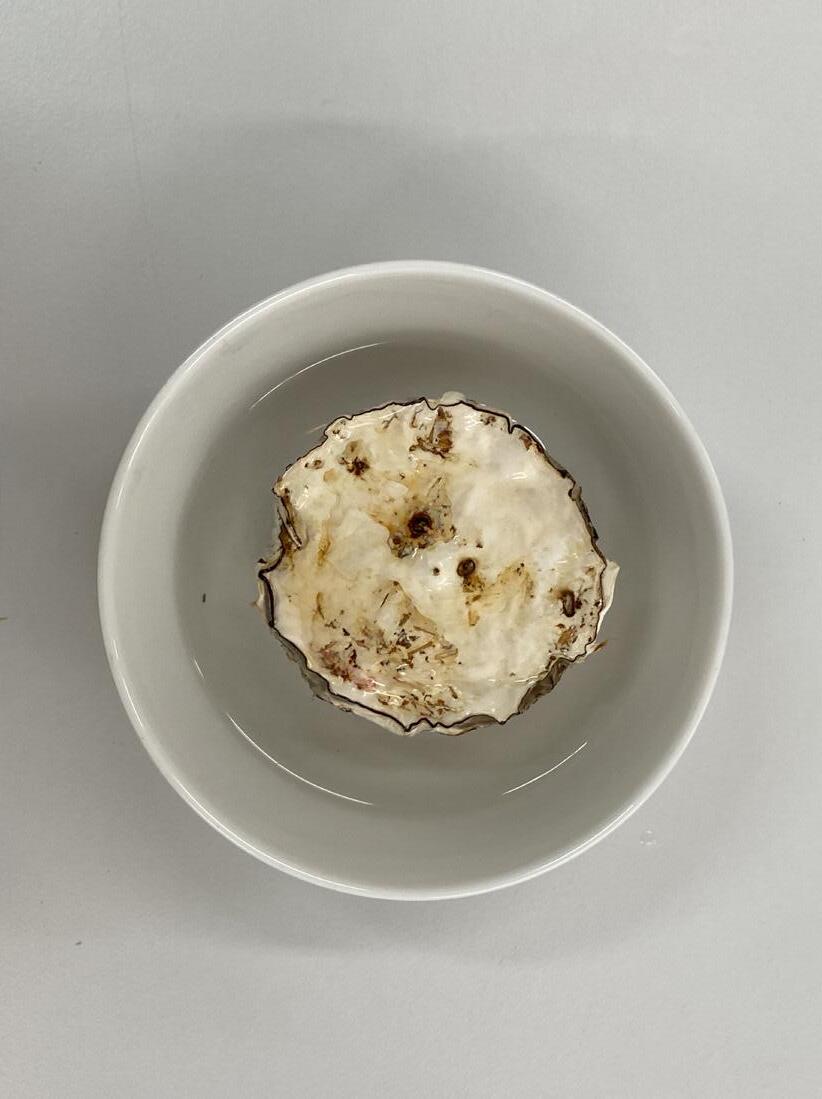





The ability to self-regenerate damaged sites stems from the metabolic activity of mycelial cells, which have evolved to navigate and grow within the openings of porous structures.
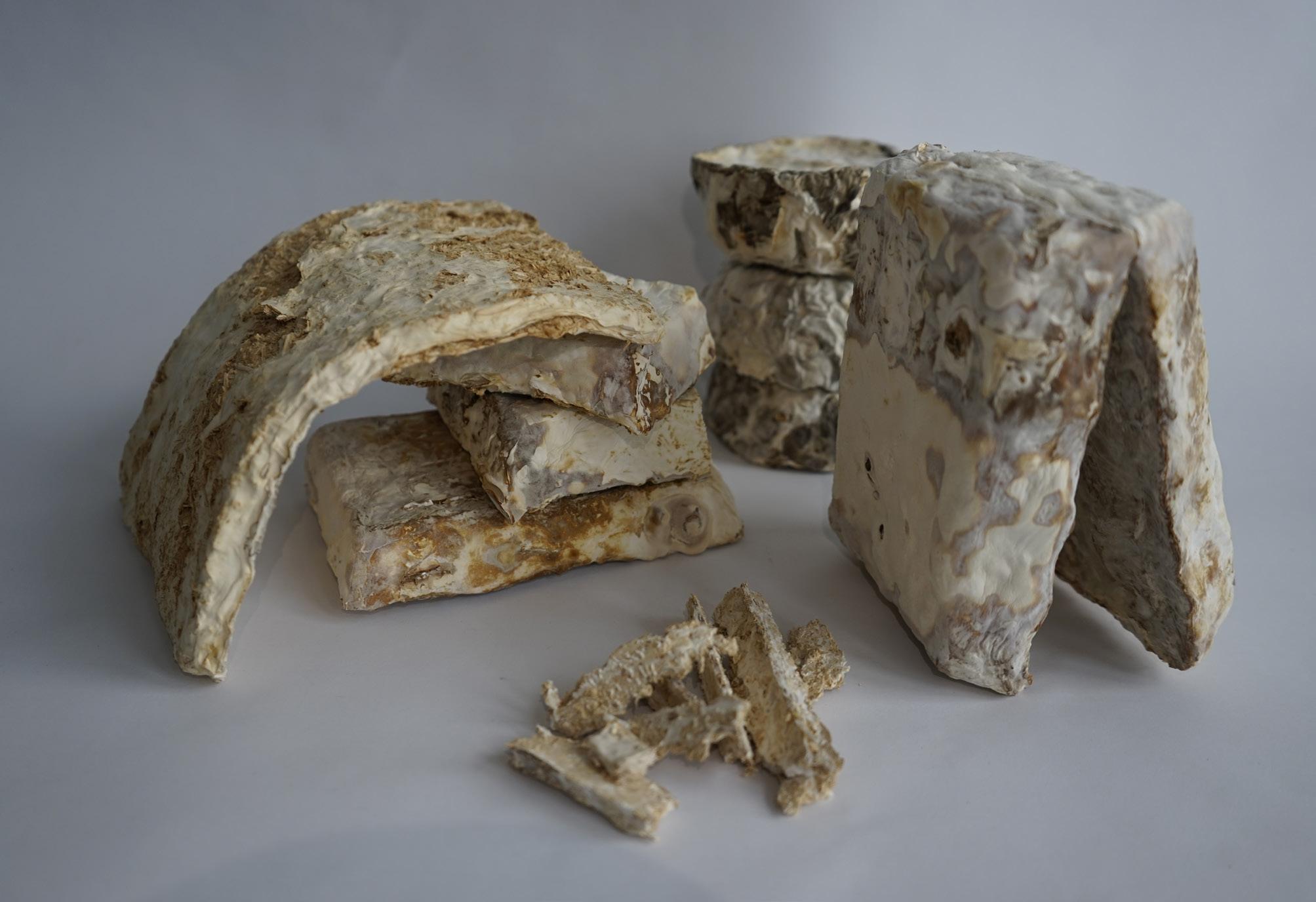
45 HYPHAE EXPERIMENTS

OPPORTUNITIES OF GROWN DESIGN
The experiment with the repair and adhesive properties of mycelium opens up numerous opportunities in the design field. Most notably, there is the potential for self-repairing structures with the addition of just a small amount of water. Individual structures can be created and stacked together, enabling them to weld into larger configurations such as tables or walls.
One of the most significant opportunities is the ability to repurpose residual wood, which is often discarded during production. Mycelium can fill cracks and bind where other materials might fail, providing a sustainable and efficient solution for using waste wood. This not only reduces waste but also enhances the structural integrity of composite materials.

47 HYPHAE EXPERIMENTS

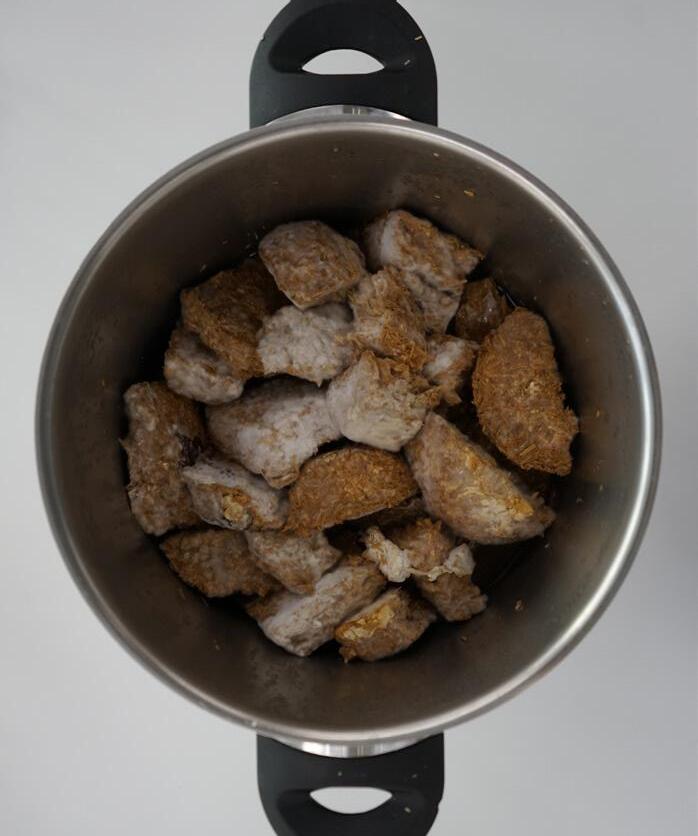


Working with the same material involves crumbling down older pieces and re-nurturing the mycelium for renewed growth. This process entails breaking down the existing mycelium structures into smaller fragments, which are then provided with fresh nutrients and optimal conditions to stimulate new growth.


49 HYPHAE EXPERIMENTS
NATURAL ADHESIVE AND CONNECTING VARIATIONS
wood bonding filler material aesthetic 04
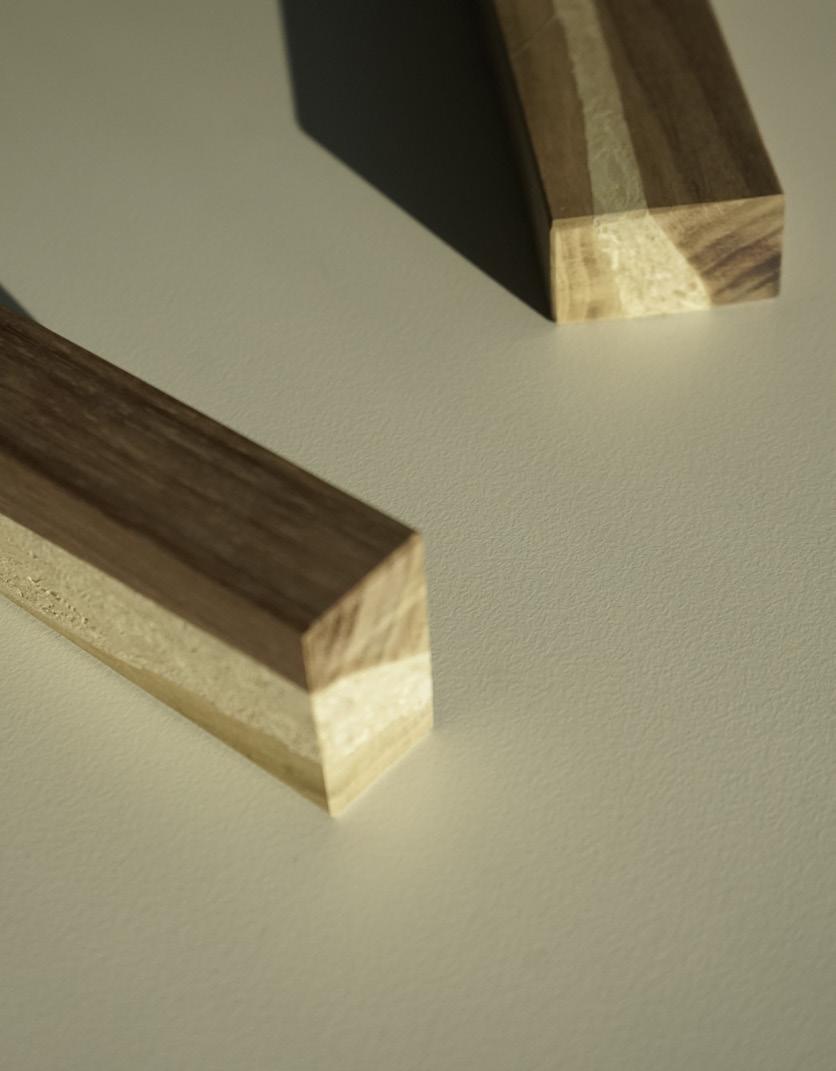

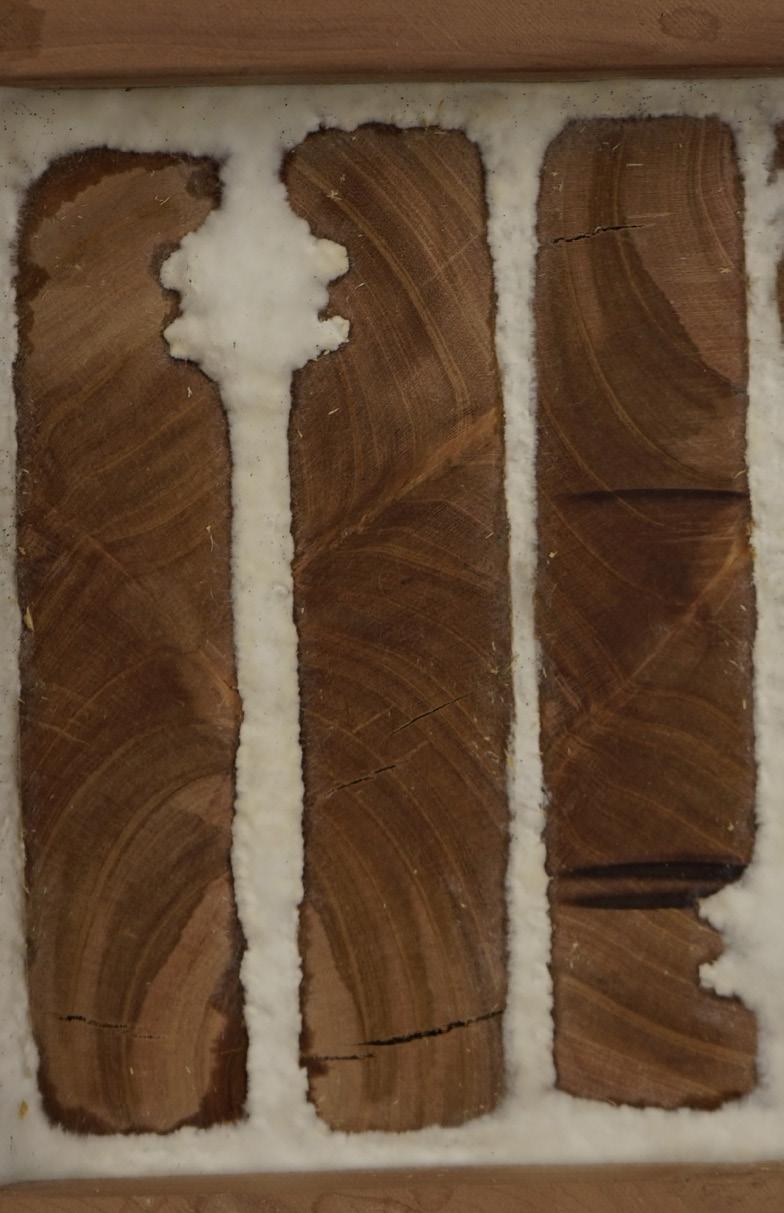
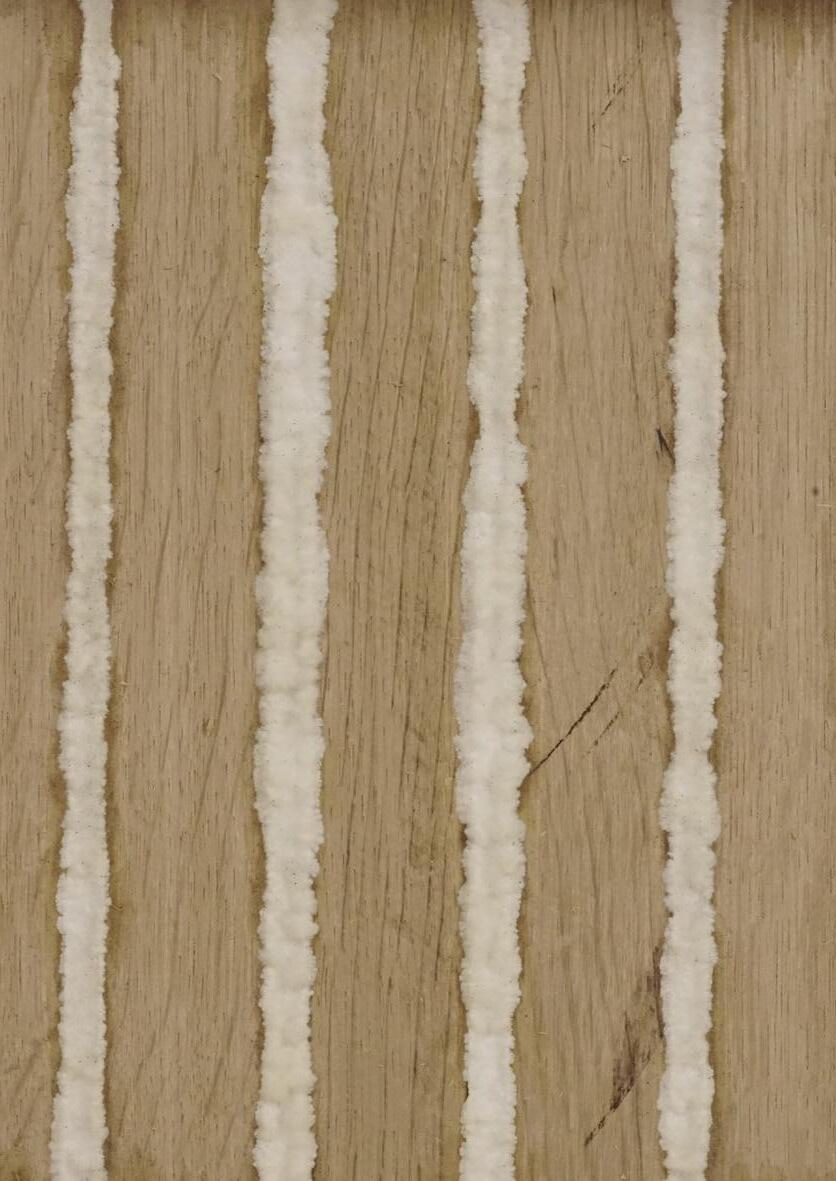

51 HYPHAE EXPERIMENTS
CONNECTIONS
Erster Einblick im Konstrukt durch ein Modell von 1:20. Das Ziel hier ist das Testen vom Mechanismus des Schirms. Der Stab kommt in die kleinen Öffnungen und wird befestigt mit einer Steckverbindung. Der Stoff spannt sich durch die Stäbe und die Stäbe verdrehen sich nicht durch die Spannung des Stoffes und die Metallhal-






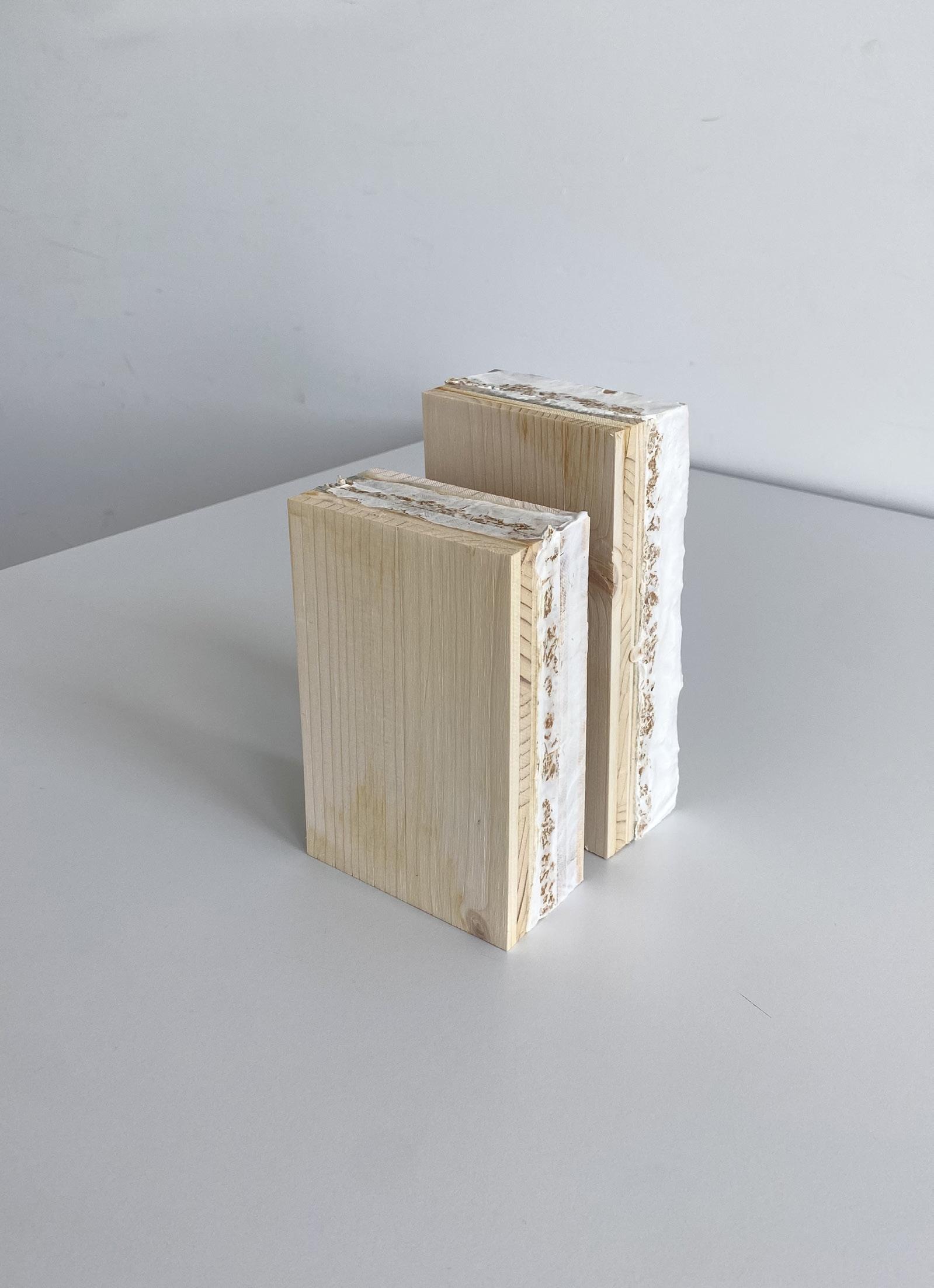


53 HYPHAE EXPERIMENTS
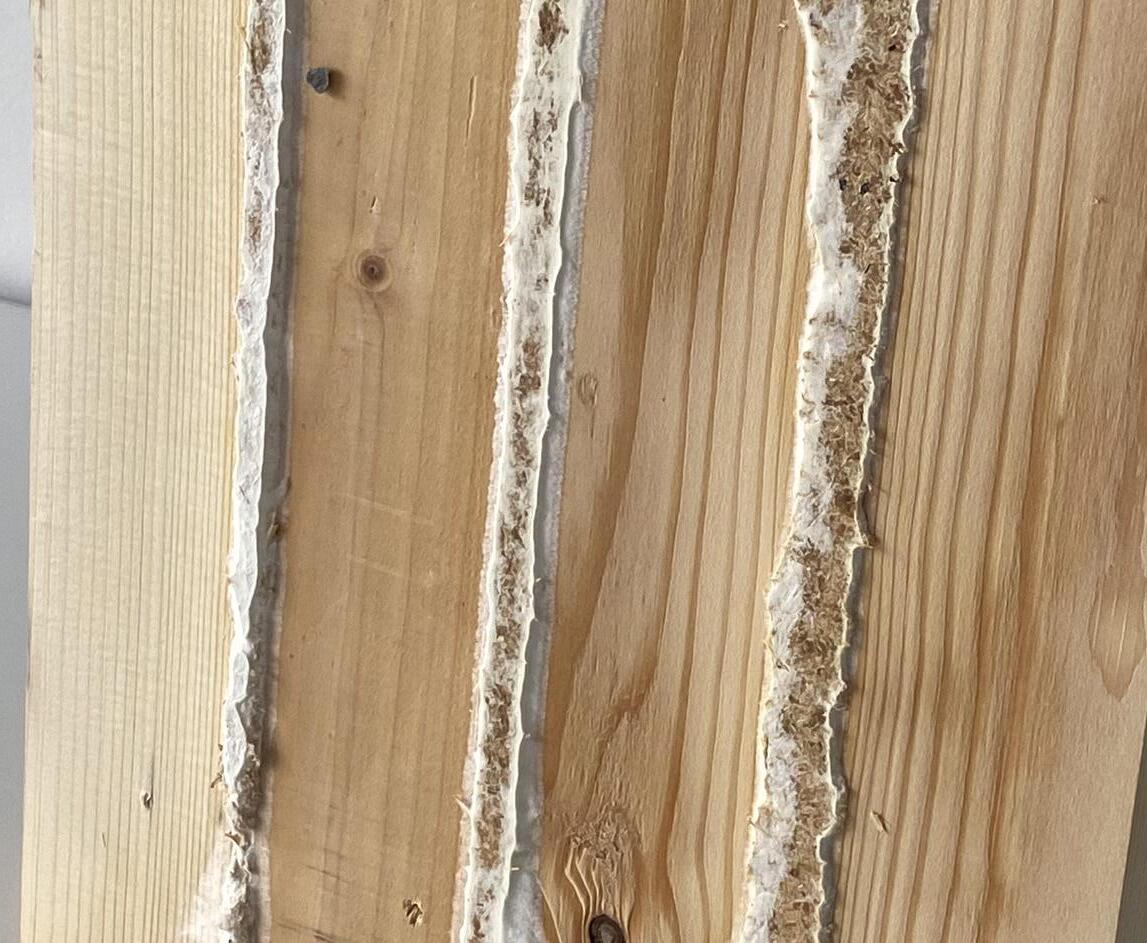



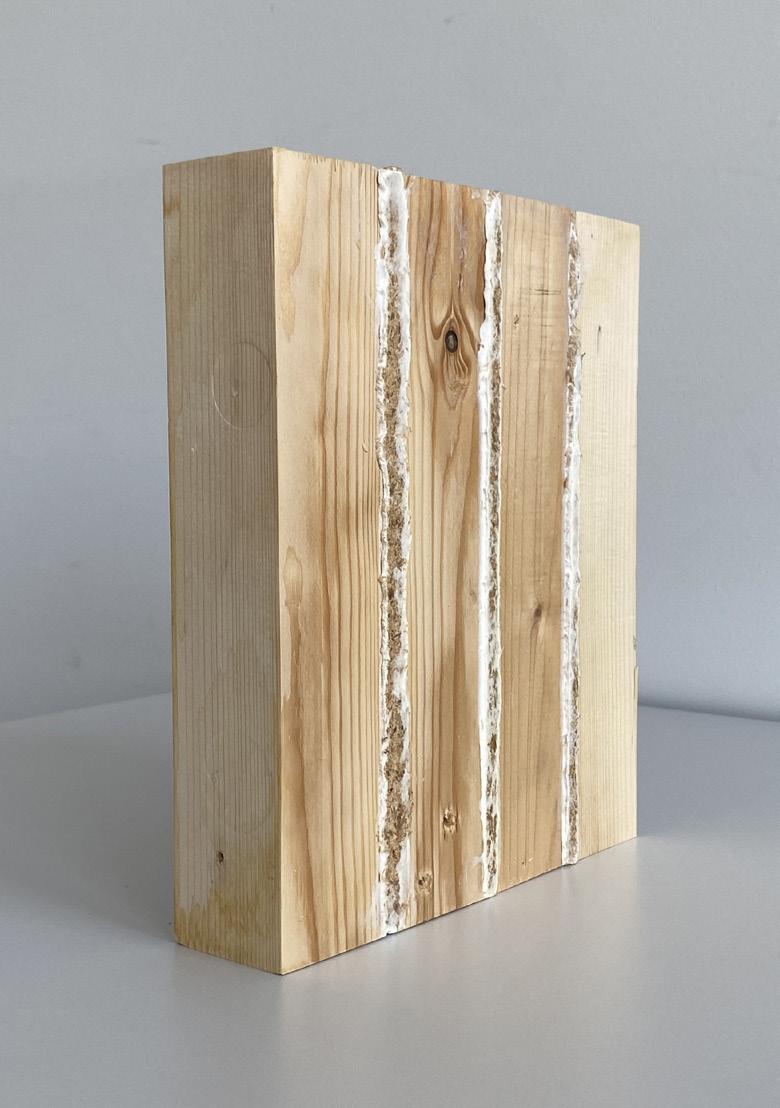

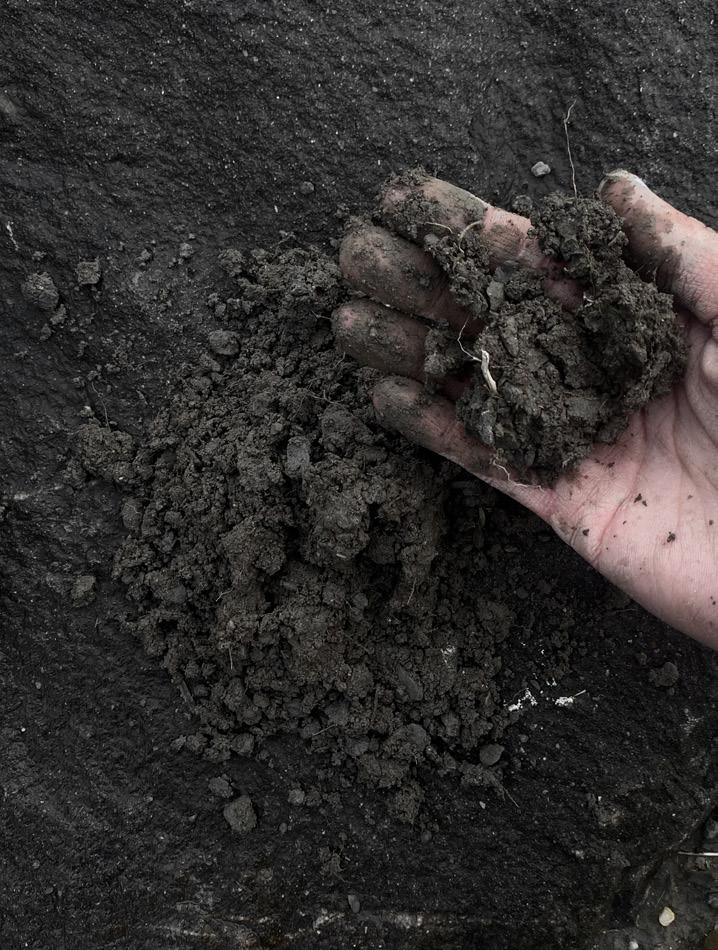
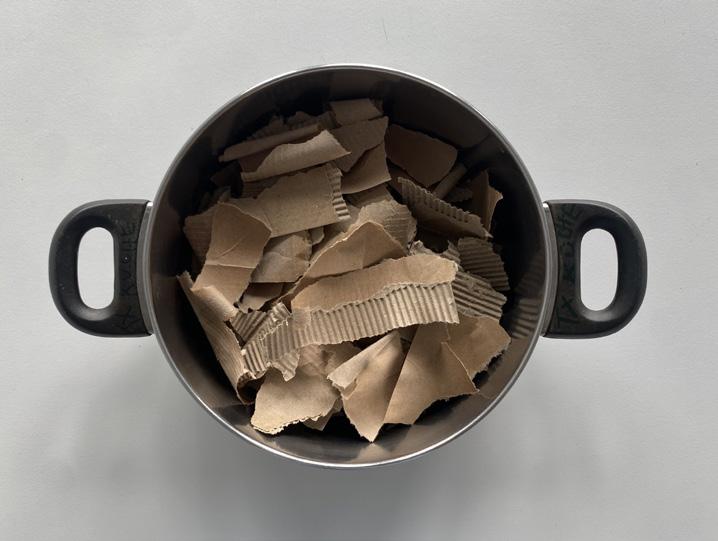

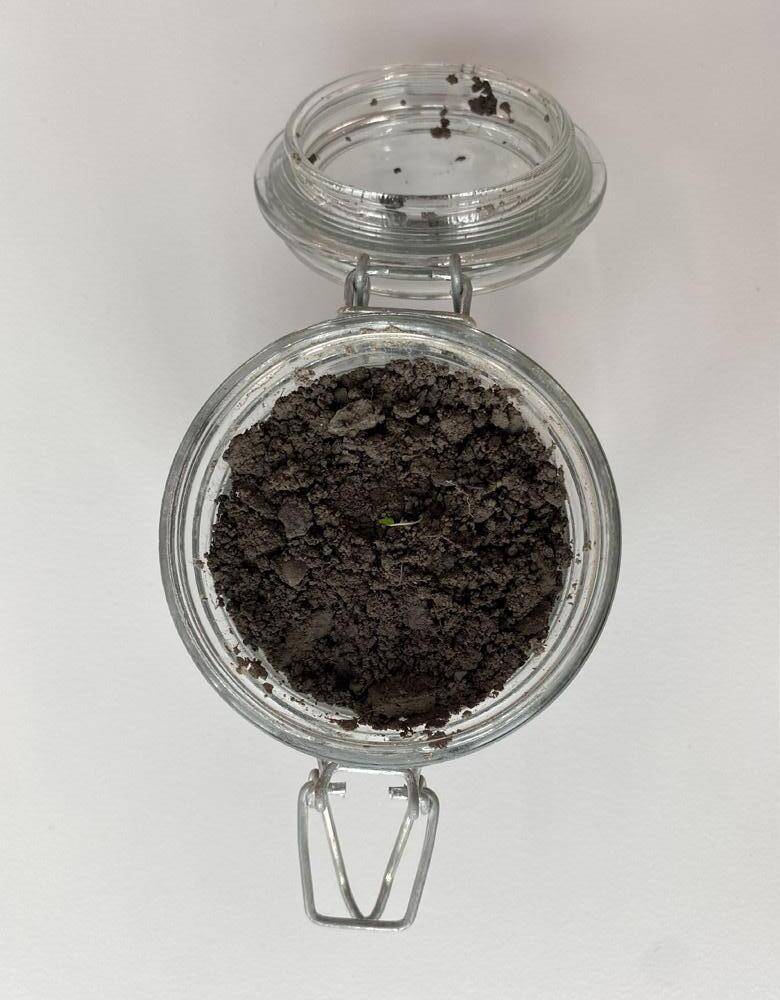
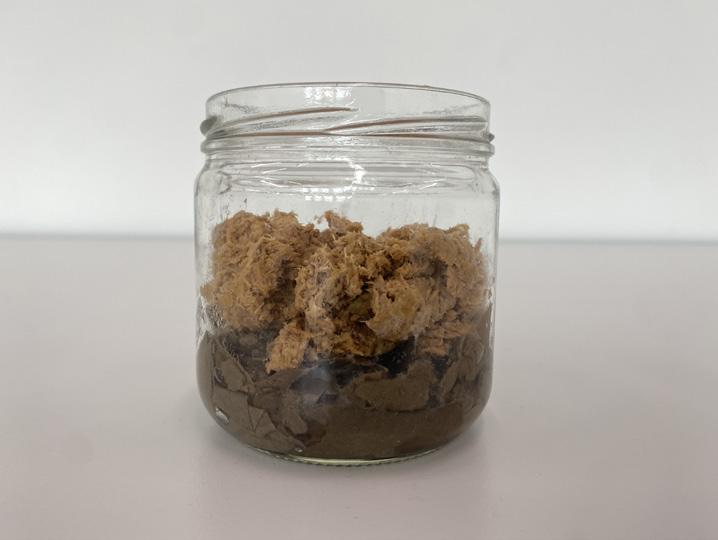

55 HYPHAE EXPERIMENTS








57 HYPHAE EXPERIMENTS
what are the ideal conditions for myceliumto attach to wood?
Thoroughly examining the hyphal network and its growth on surfaces allows for a better understanding of how and where it attaches most effectively. By using a lens with 200x magnification, the growth patterns become clearer. This detailed observation reveals the intricate ways in which the mycelium spreads and adheres to different substrates. Such insights are crucial for optimizing the conditions for mycelium attachment and growth, enabling more precise applications. The magnified view highlights the structural complexity and adaptive nature of mycelium.
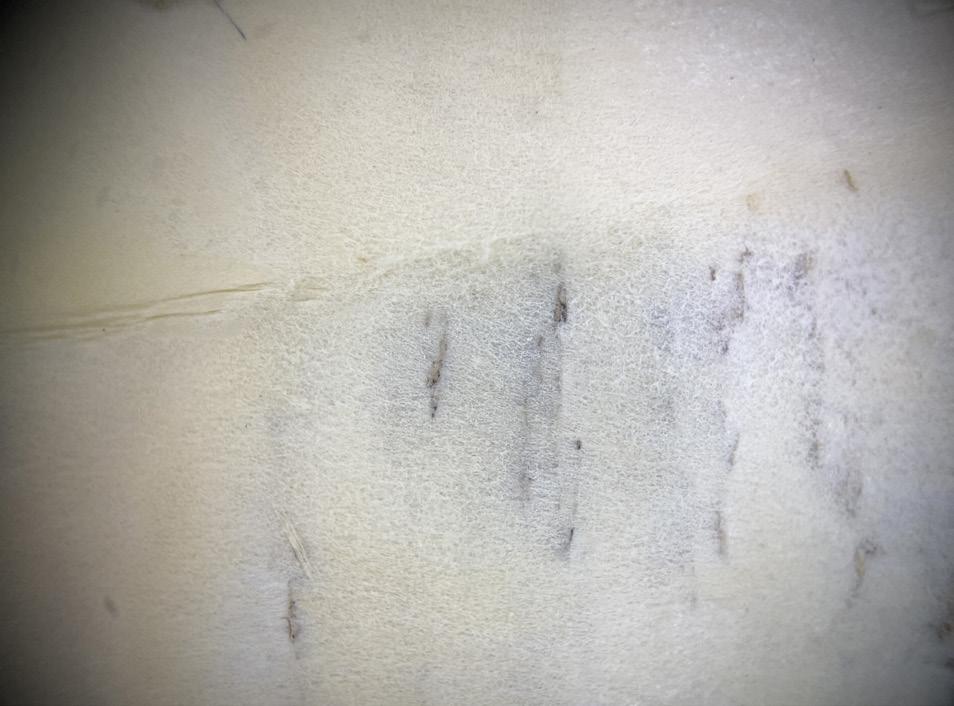



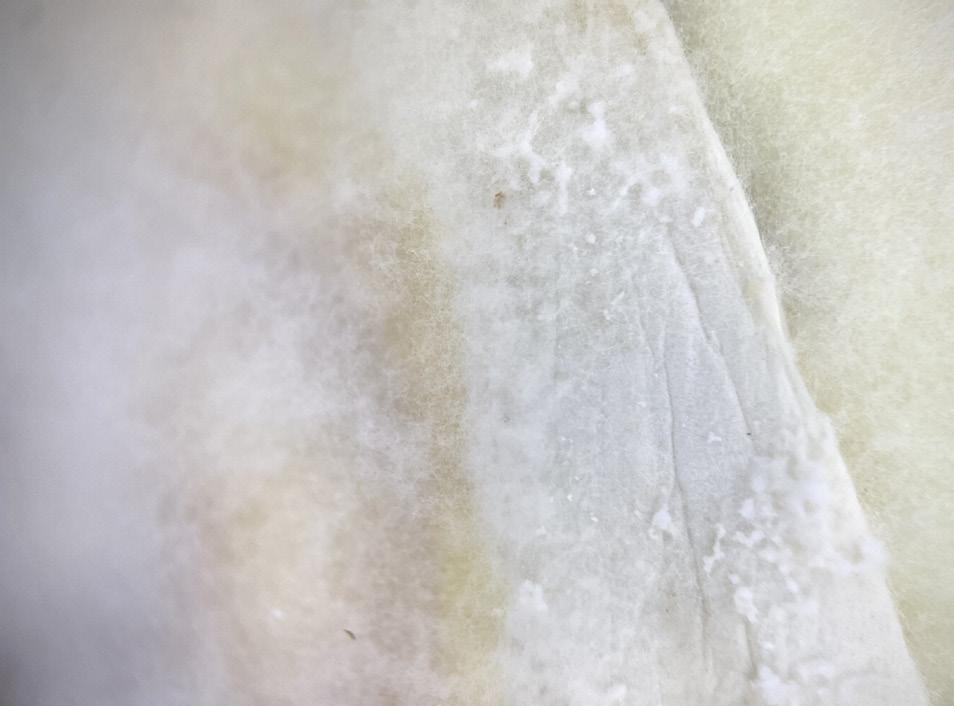

59 HYPHAE EXPERIMENTS
Mycelium connection with fibres.
Covered mycelum wall with hyphal network.
Closer view of completely grown structure with minimal wood parts.




UNIFICATION
The magnified view shows how mycelium grows on and within biomass at various stages. The filaments resemble those of silkworms or spider webs, creating a highly complex network. Form upclose it look so fragile but it is fascinating how recilience is fascinating. the samples for these pictures were taken from one of the rectangular, robust blocks. It is astounding how efficiently the mycelium finds the best way to spread its hyphae throughout the entire structure in a short amount of time. Even when the substrate is damaged, crumbled down, reshaped for hydration, or mixed with other carriers, the filaments still manage to spread and nourish themselves, covering the entire surface in white. It is literally like a natural 3D printer, spreading and building material.
61 HYPHAE EXPERIMENTS
SURFACE
Upon attaching the wood, I observed under 200x magnification that the slept wood showed smaller pores and a less suitable surface for mycelium attachment. Consequently, it is better for the surface to be rough: the rougher, the better. This observation is consistent with the close-up images, as well as with the previously observed mycelium growth patterns growing from one fiber to another.
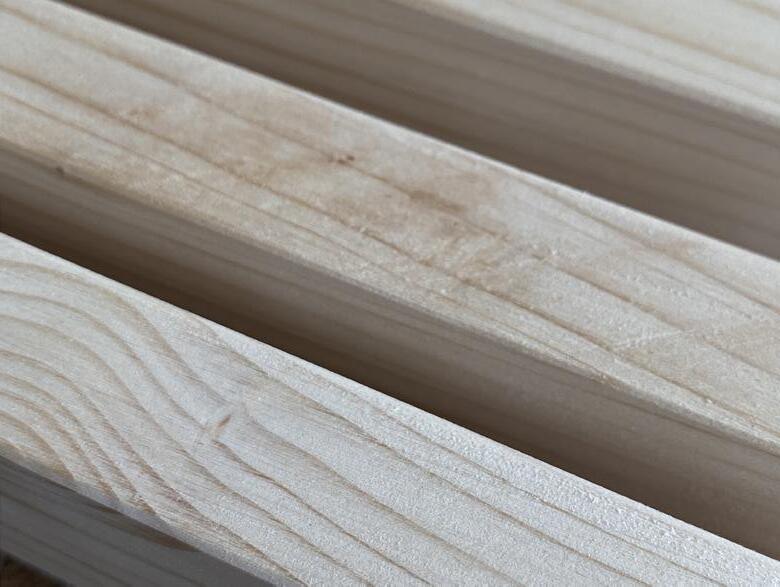

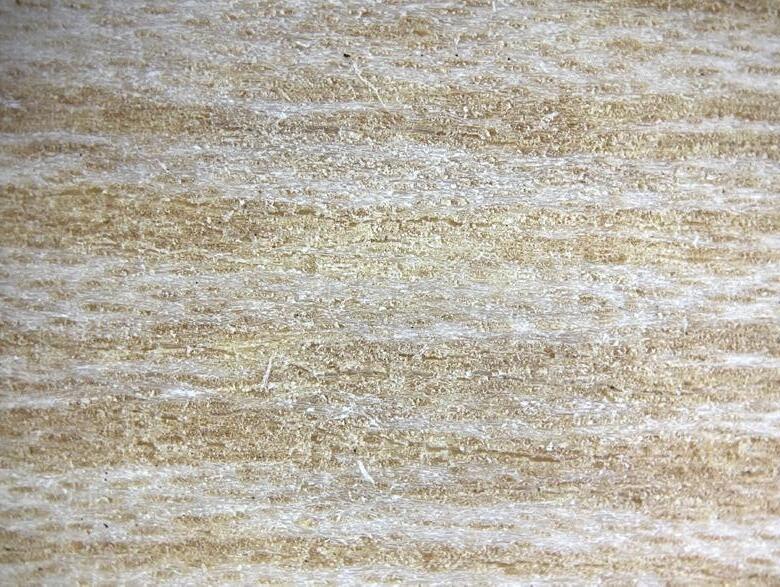

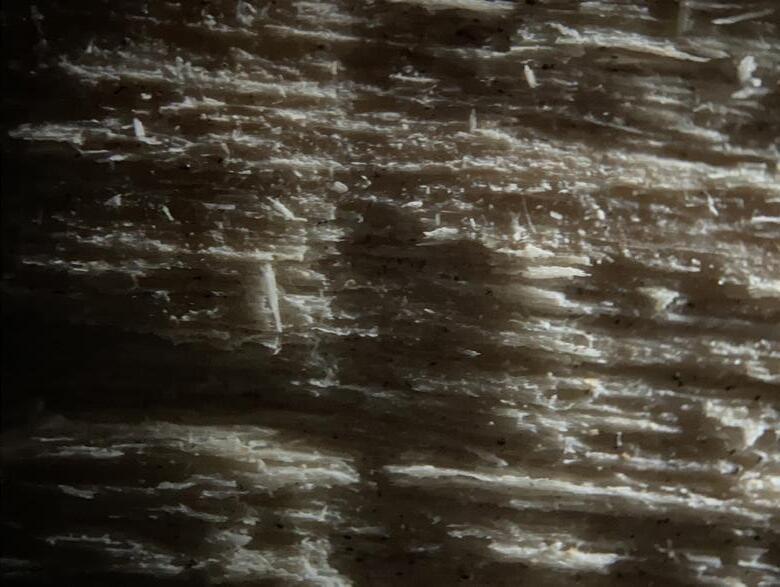

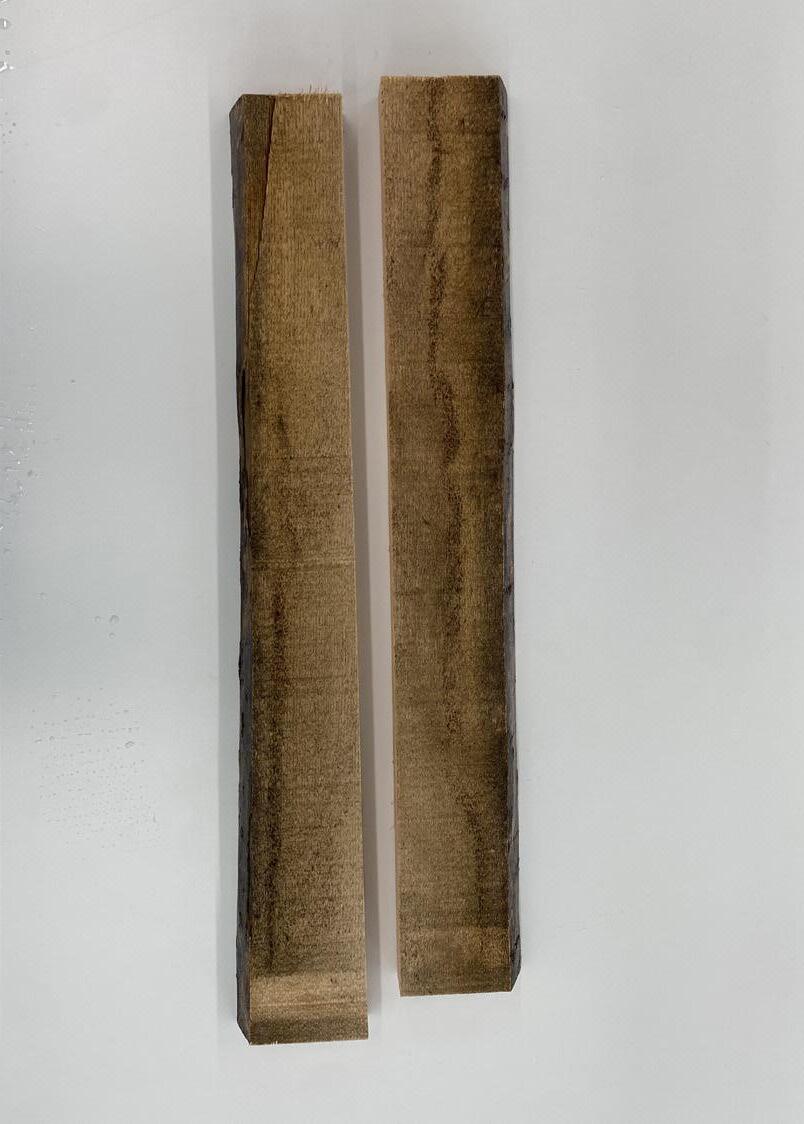





63 HYPHAE EXPERIMENTS



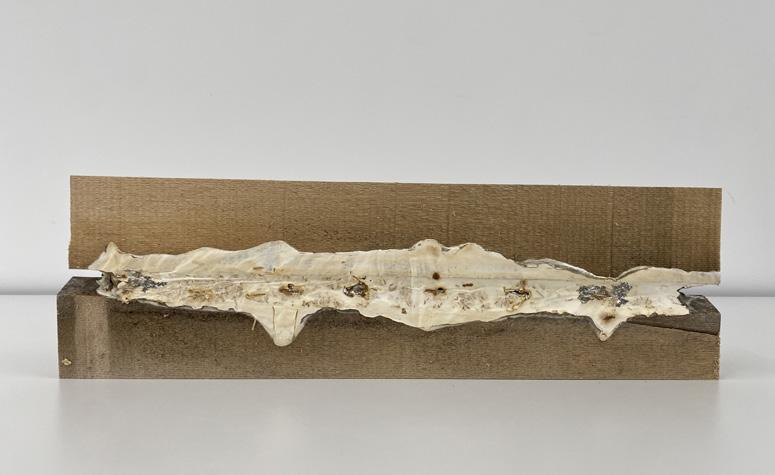
Mycelium is growing on hardwood with a rough surface. Both pieces were residual and have different dimensions.



wood that has been slept and mycelium after long-term dormant state
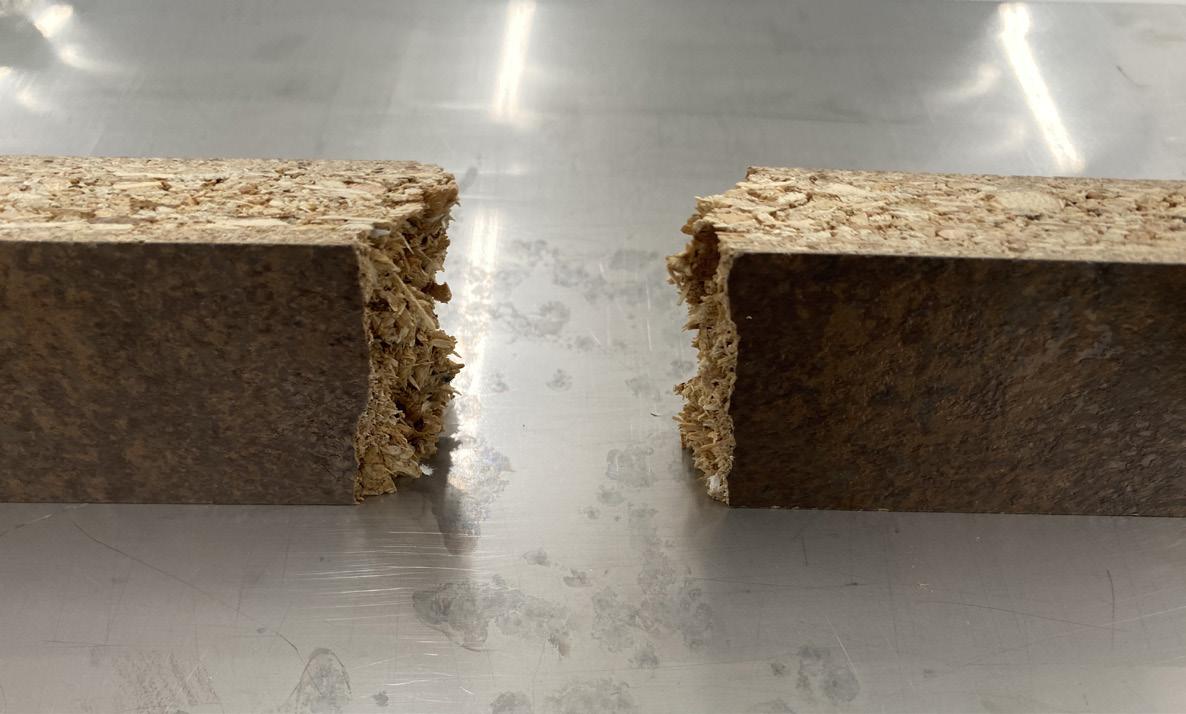

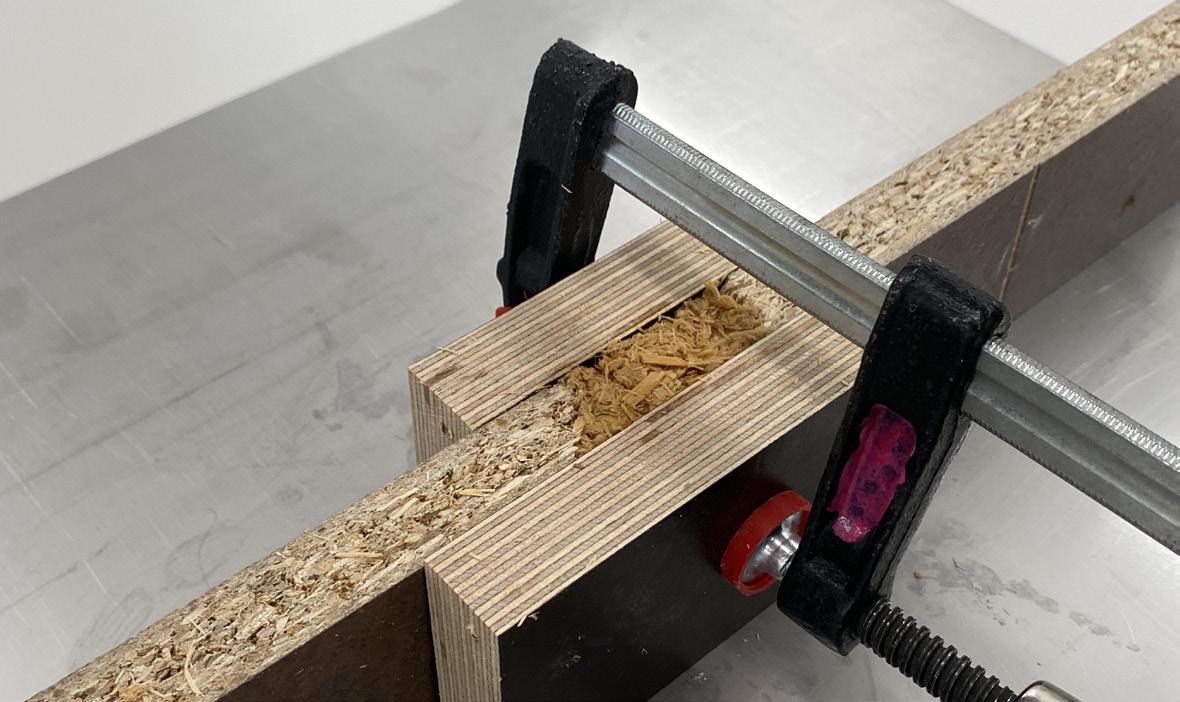

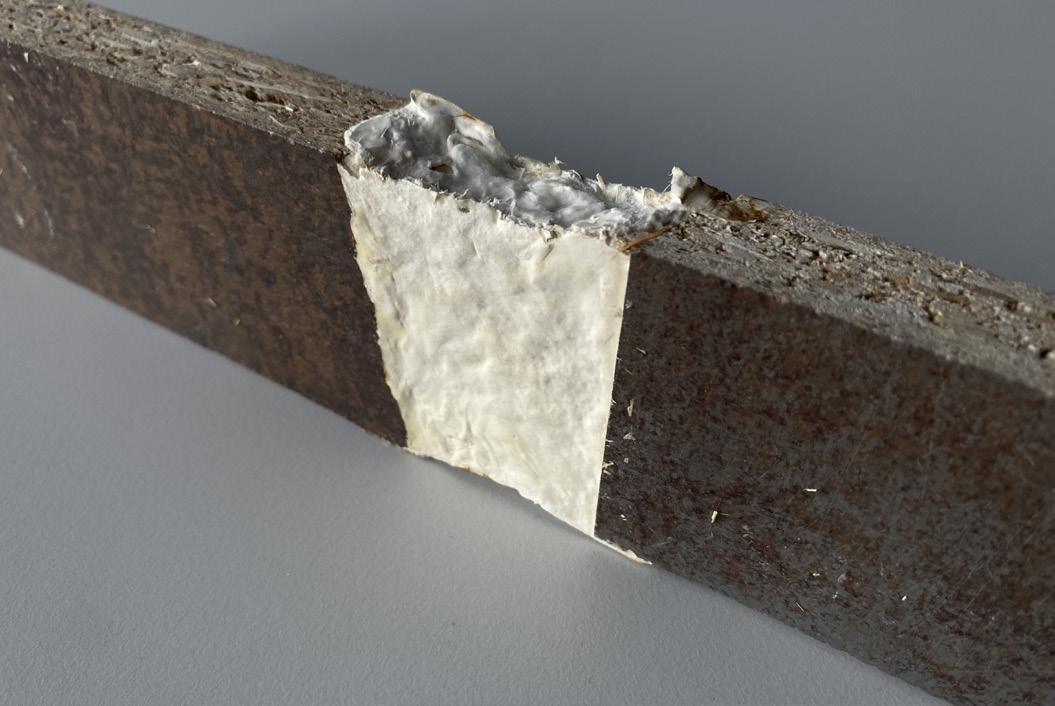

For trying different wood types, I used a similar carrier material as the mycelium substrate: span wood. Here, the surface is laminated with a brown plasticized layer, preventing the mycelium from growing. The line is clearly defined.
65 HYPHAE EXPERIMENTS

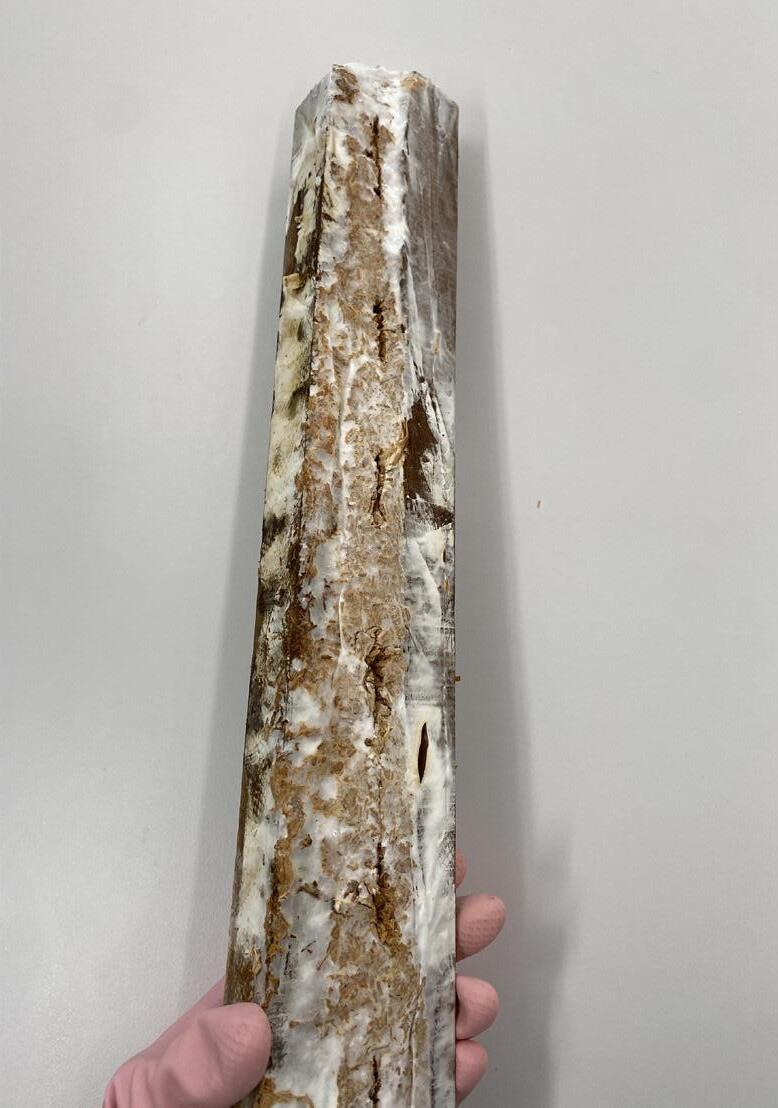
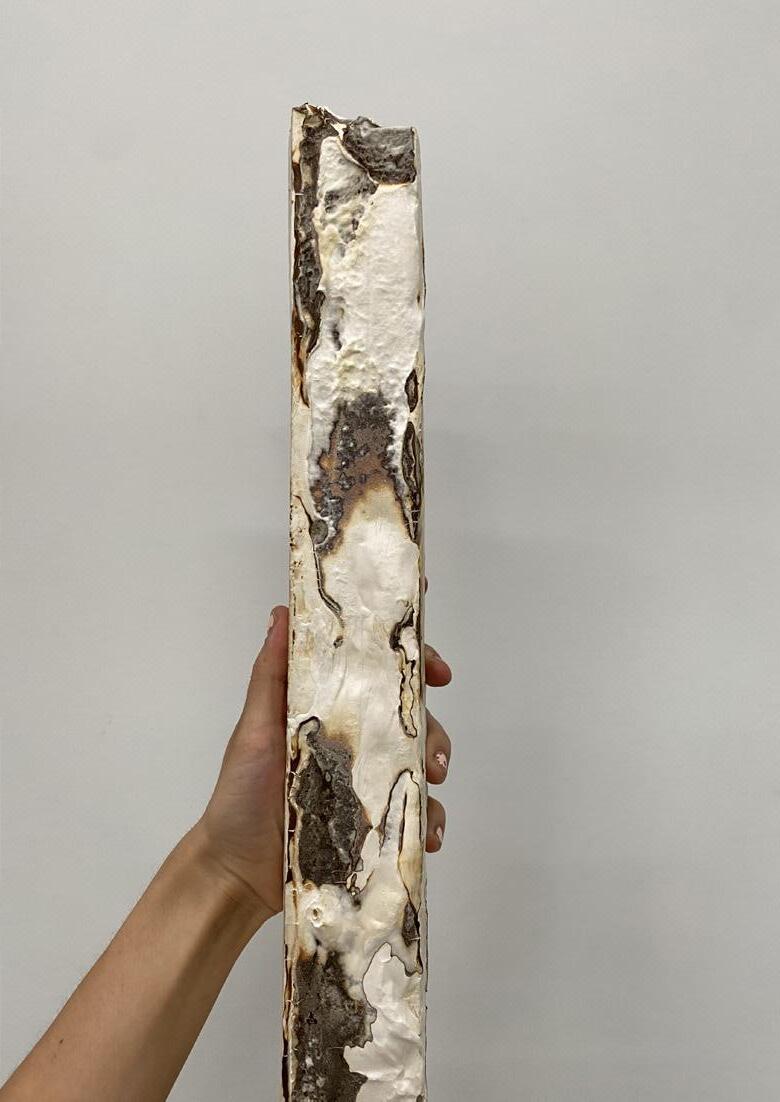
With the mycelium fully covering the entire wooden surface after allowing it to grow for several weeks, I then placed the wood underneath.


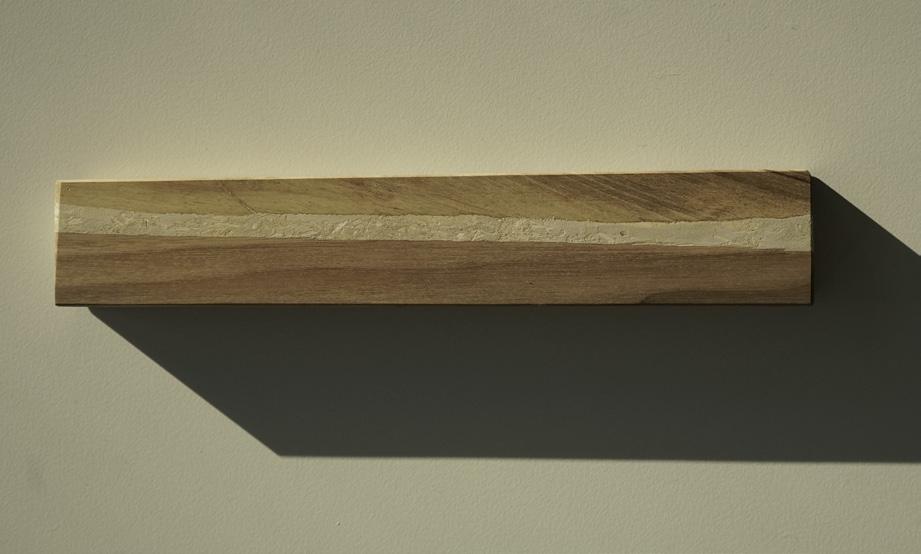
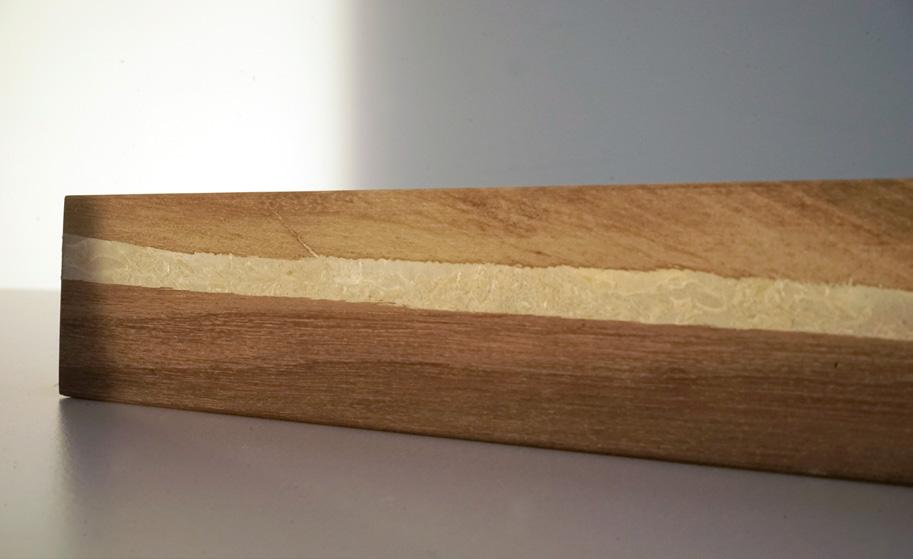
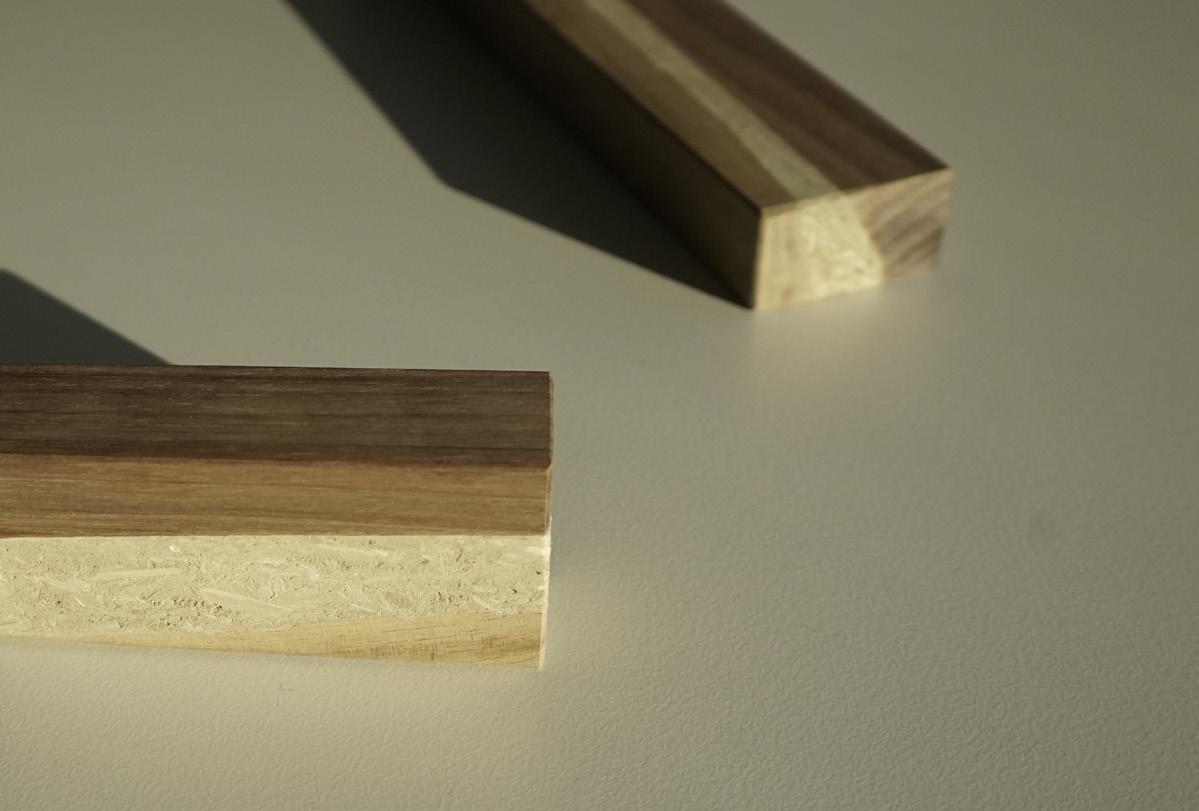



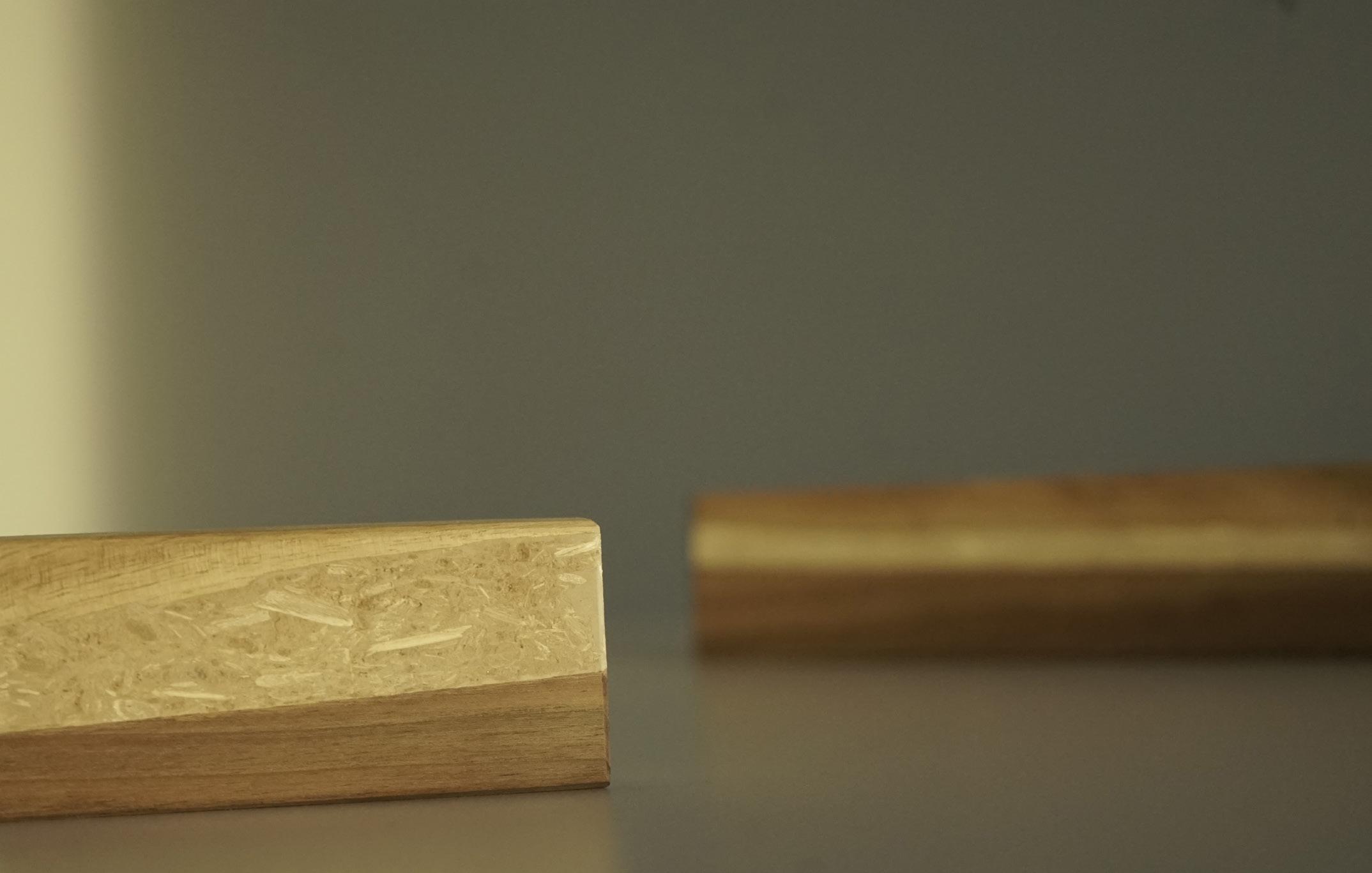
EXPERIMENTS
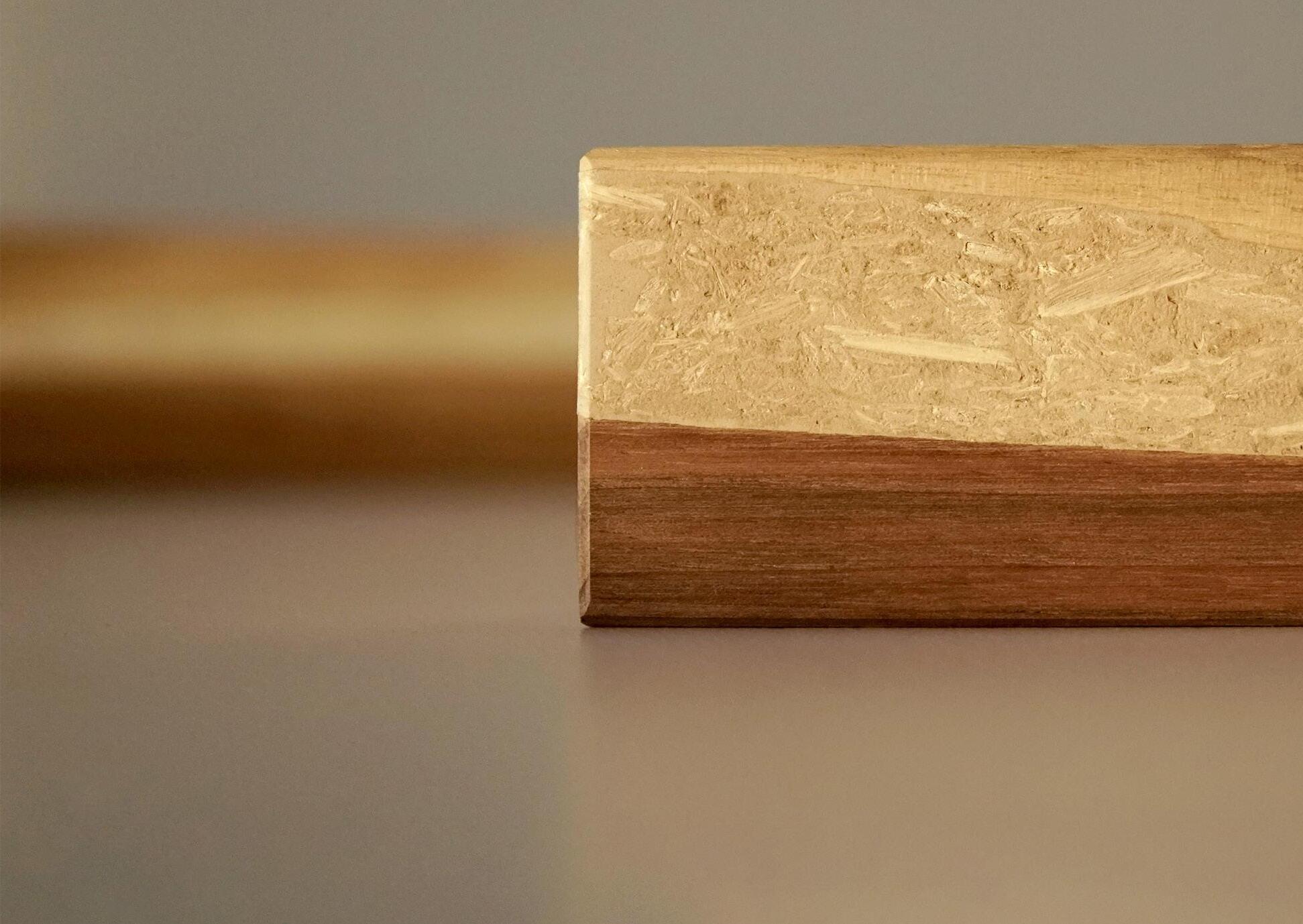
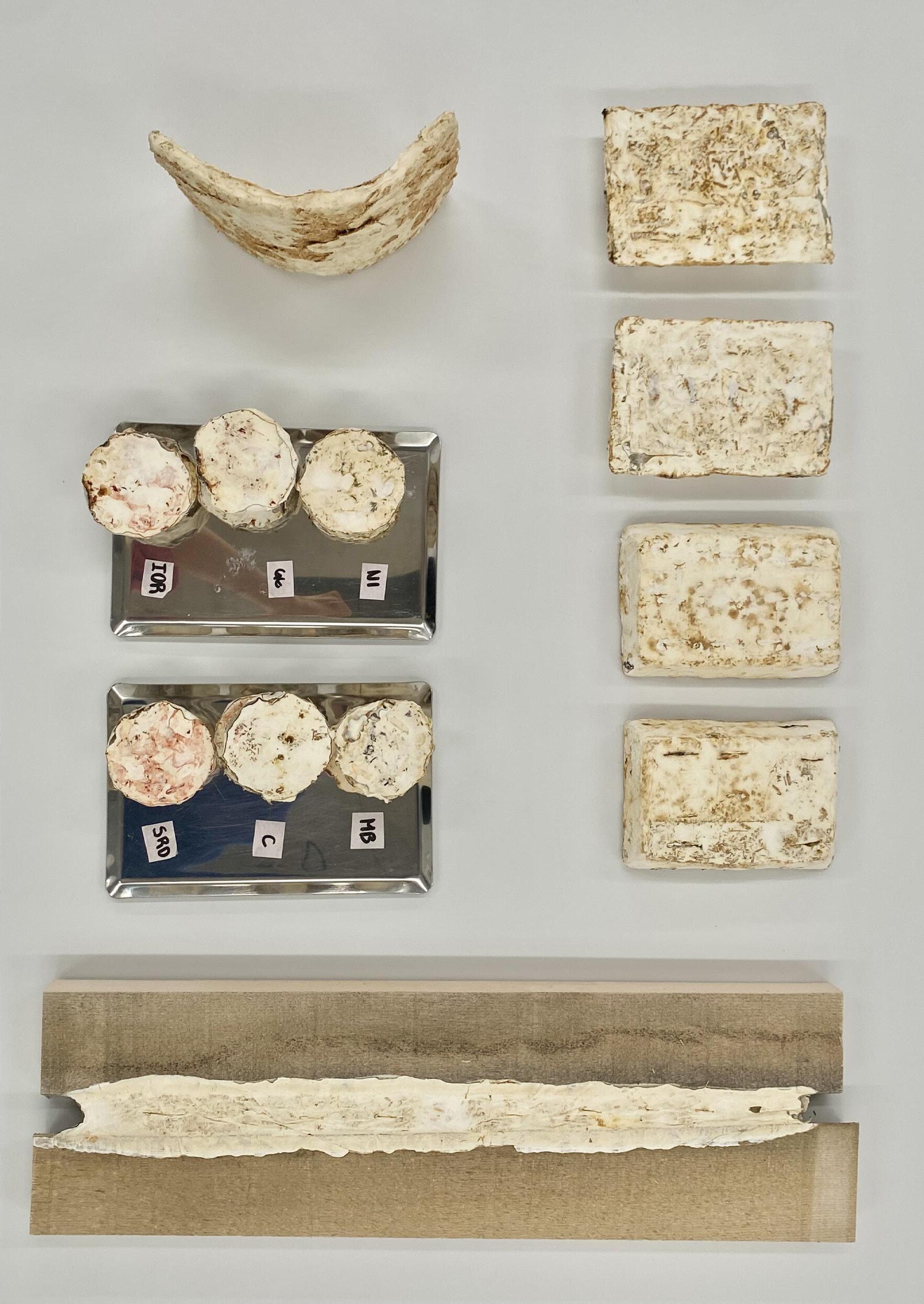
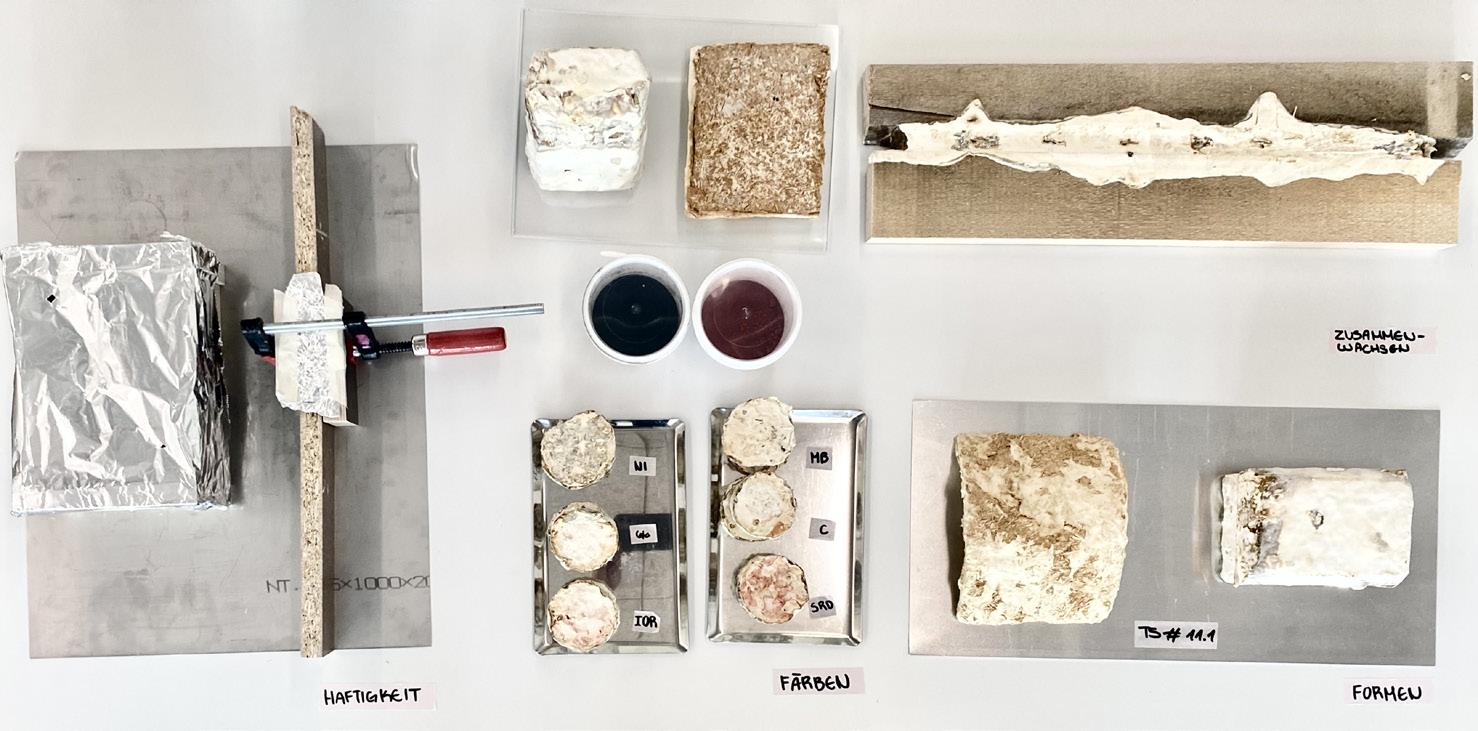
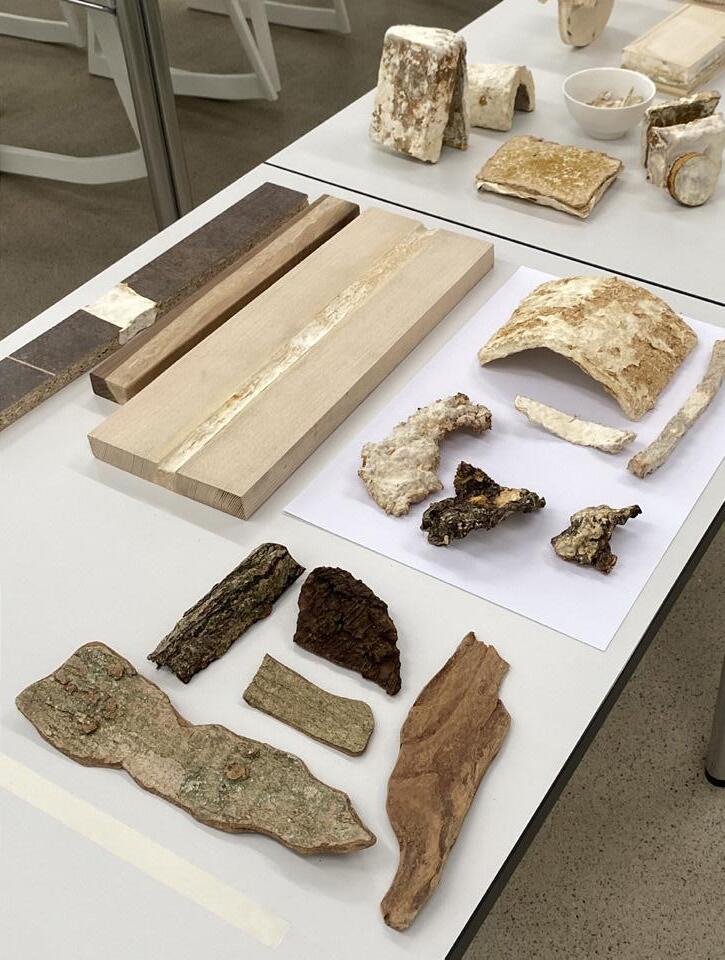
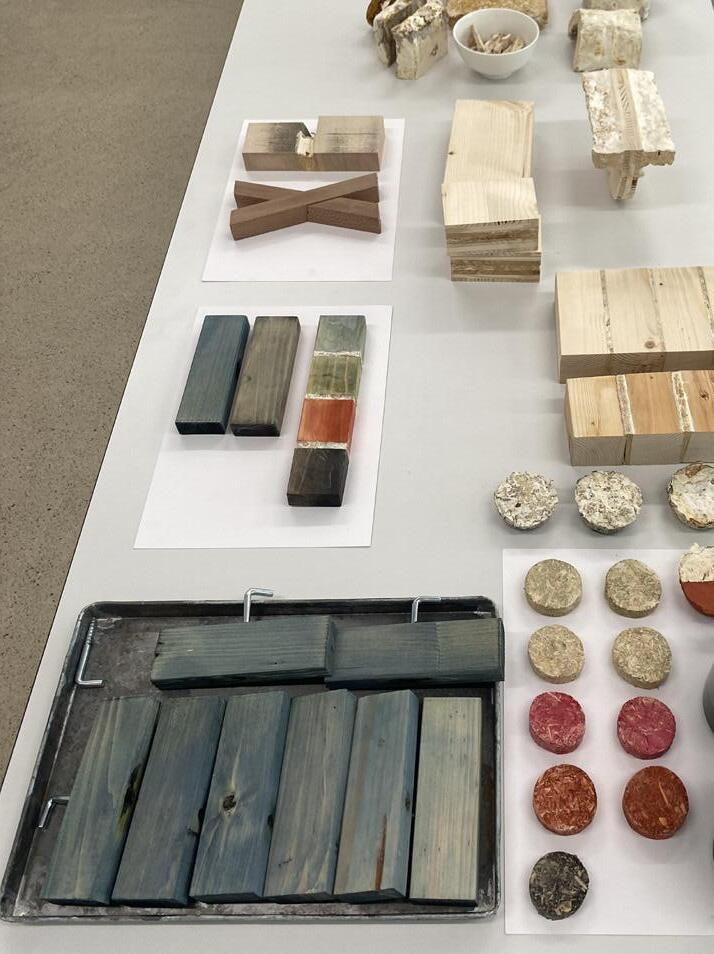
69 HYPHAE EXPERIMENTS
COLORING EXPERIMENTING WITH FABRIC
Mycelium is renowned for its bioremediation and filtration capabilities, effectively removing pollutants and other substances. In my research, I found that using milk paint or other paint formulations that do not contain oil or substances harmful to mycelium growth is crucial. This led me to wonder how pure pigment in a water-based solution would interact with mycelium - whether it would be absorbed or rejected.
For my experiment, I aimed to use entirely organic pigments or minerals since I wanted the coloring to be biodegradable. While synthetic colors might offer more vibrant hues, they were not considered due to their non-biodegradable nature. I selected six colors to test their effects on mycelium growth.
PIGMENTS


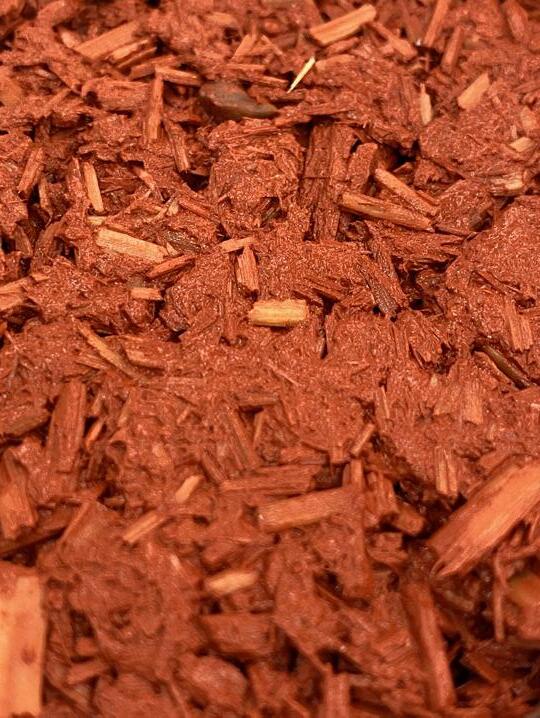


Greenarth Manganblack Ironixide-red
Curcuma Organic Indigo



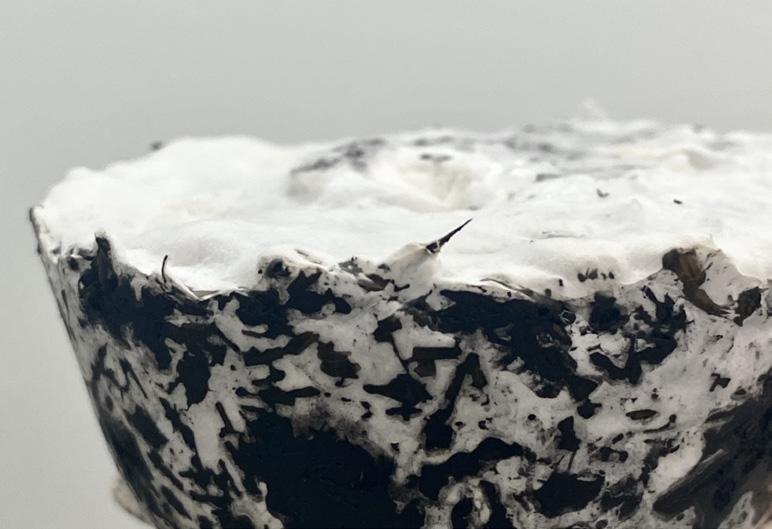
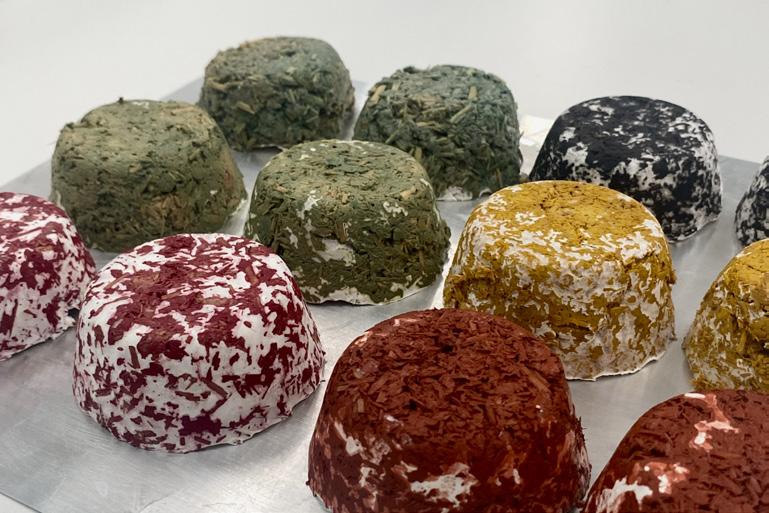

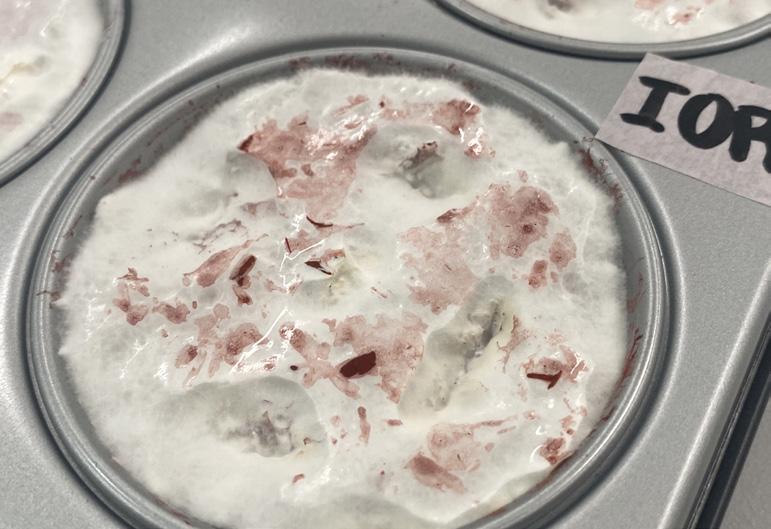



71 HYPHAE EXPERIMENTS


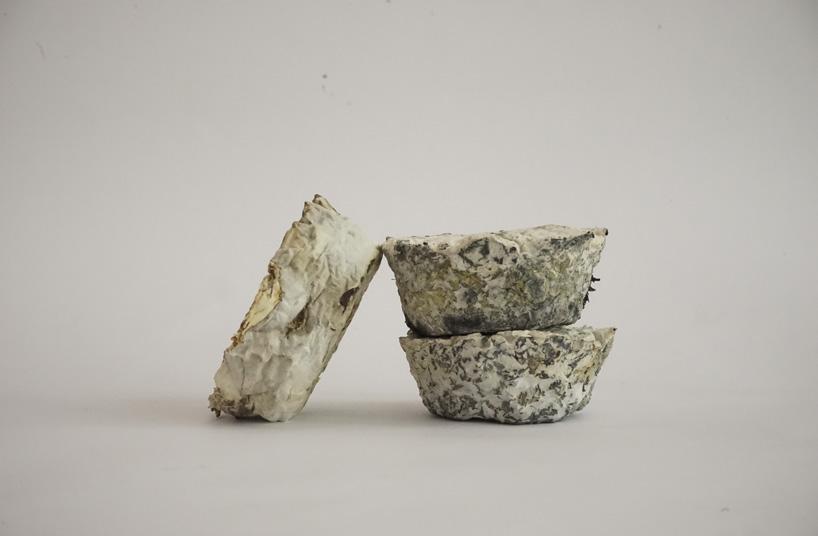
The mycelium covered the whole surface without a trace of the color underneath.



After processing the surface of the color samples
73 HYPHAE EXPERIMENTS

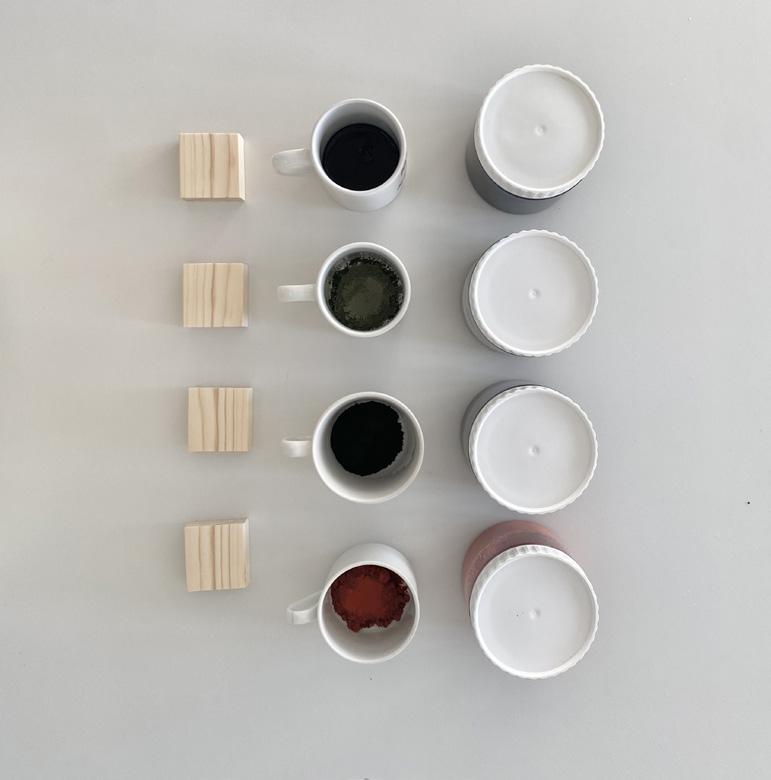
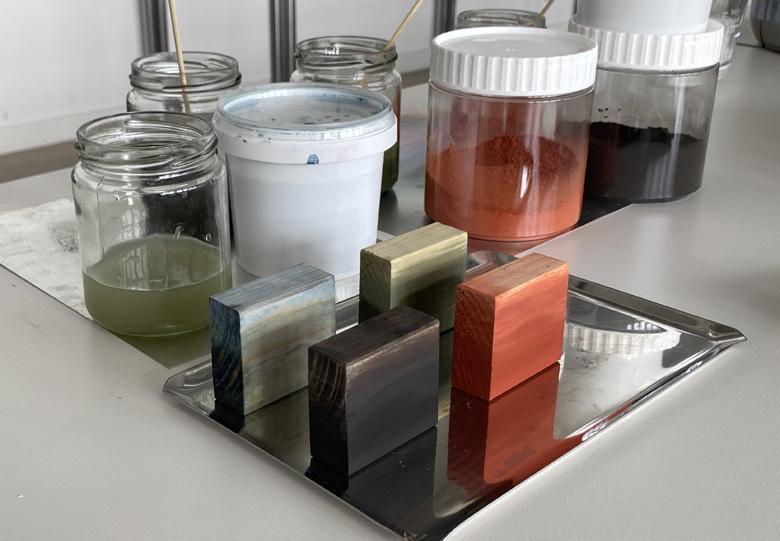






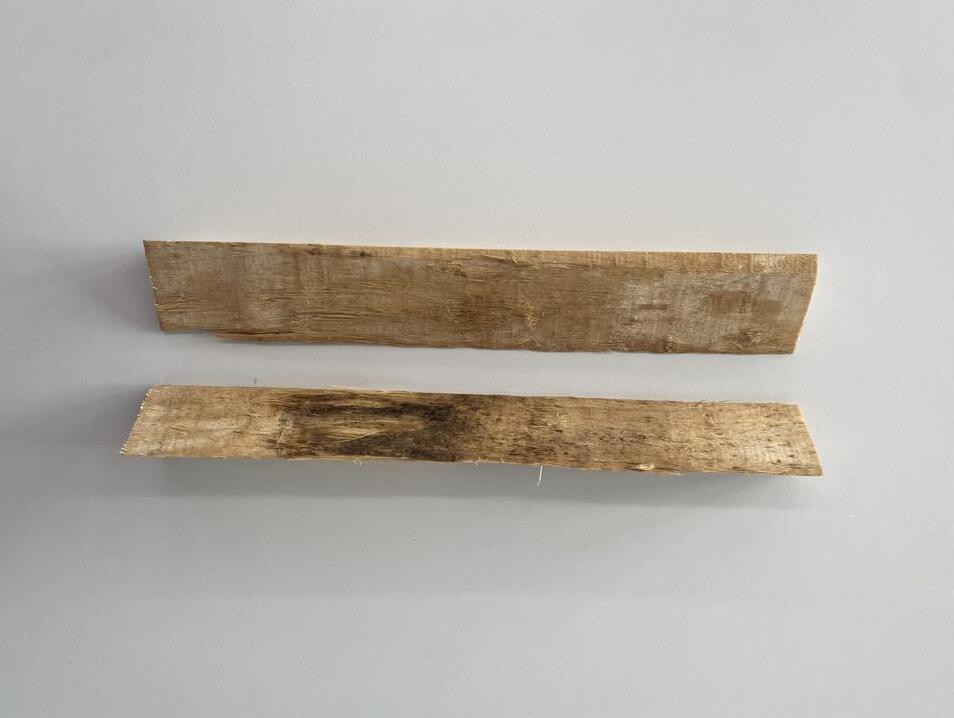

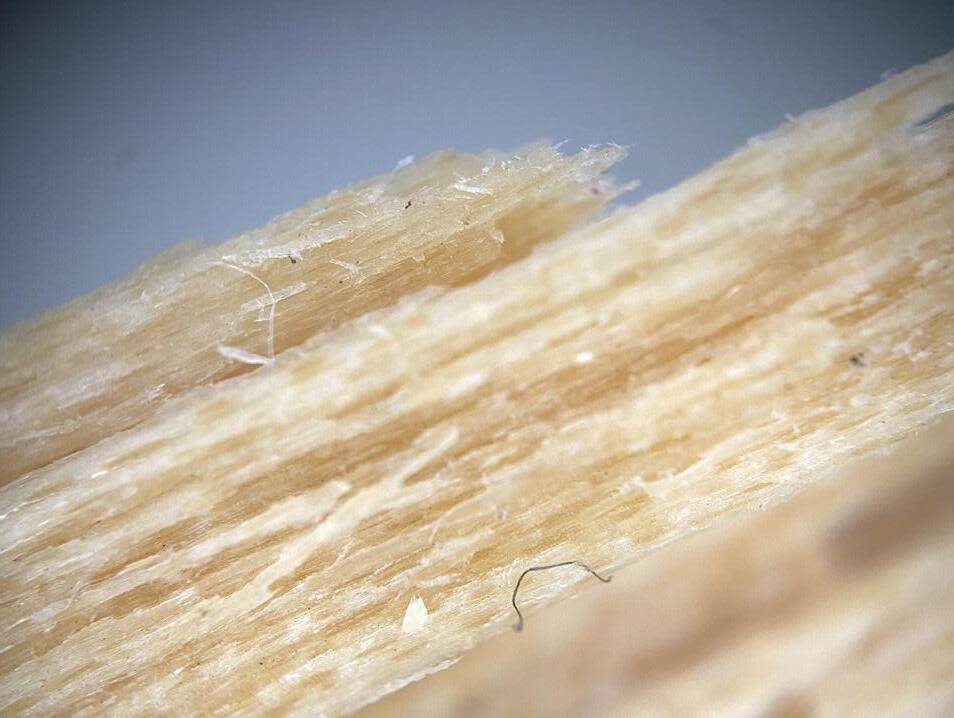
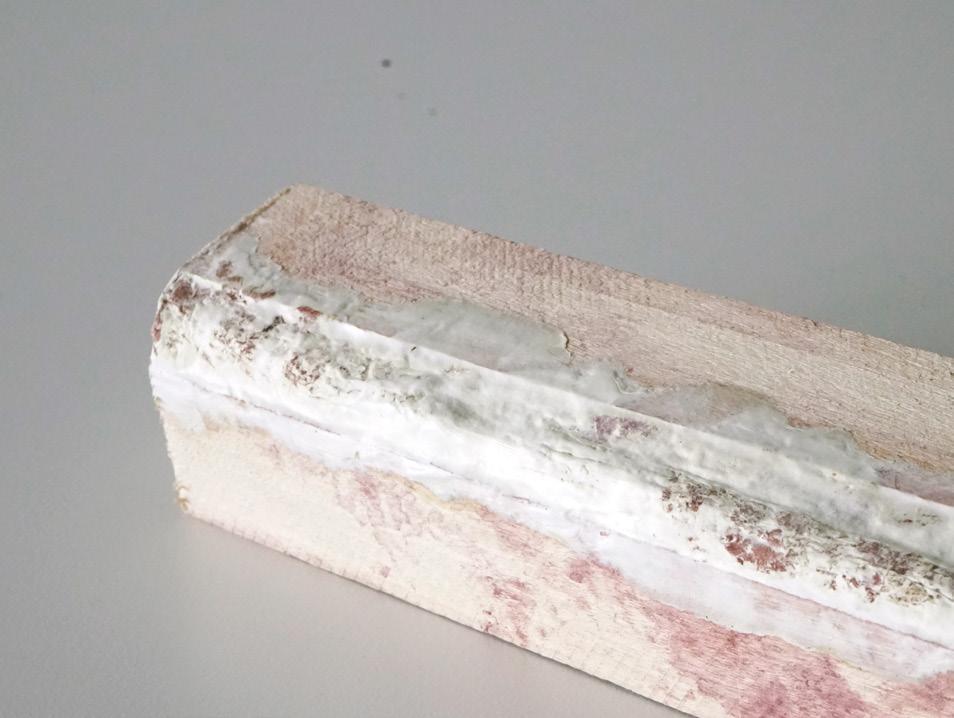



75 HYPHAE EXPERIMENTS
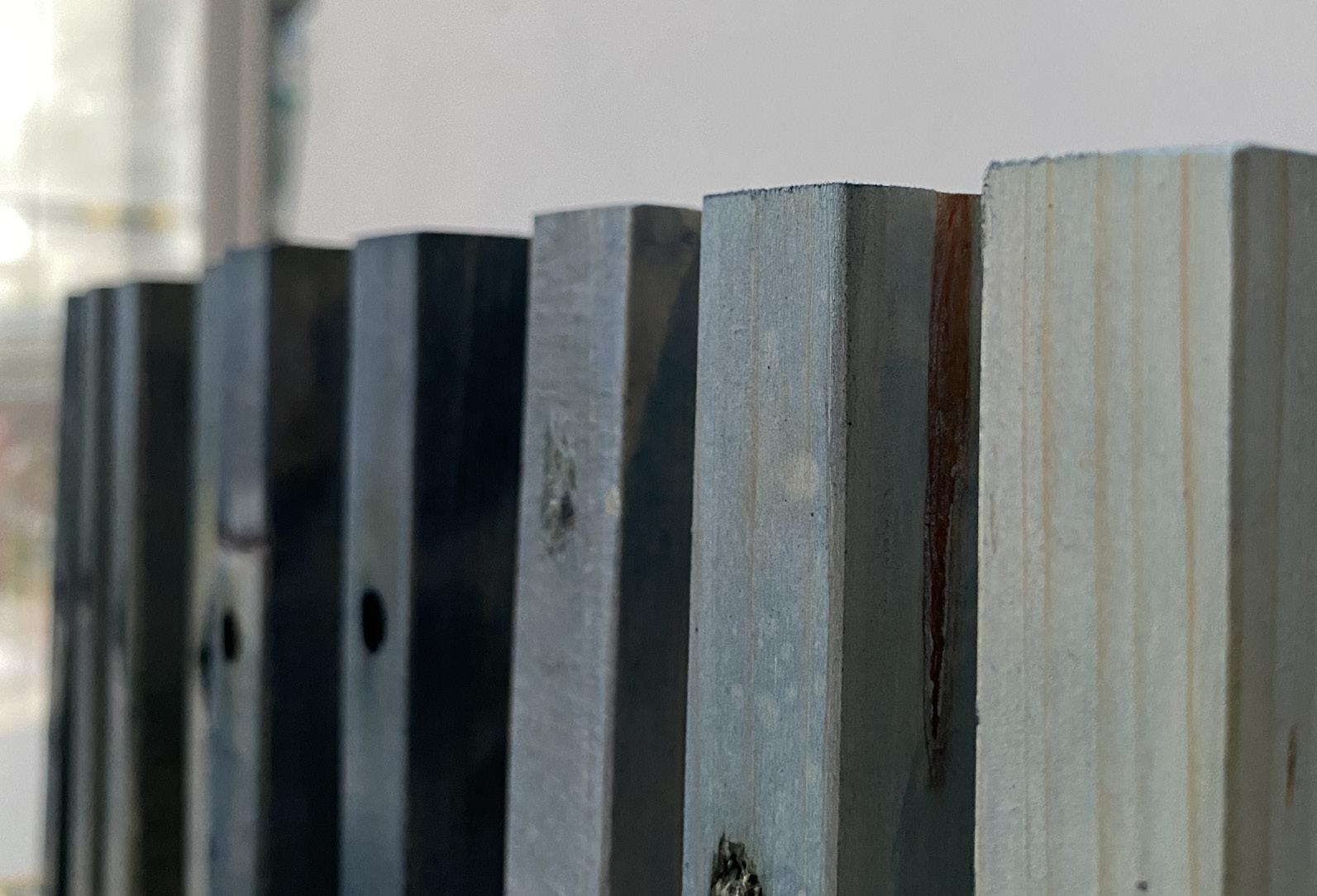
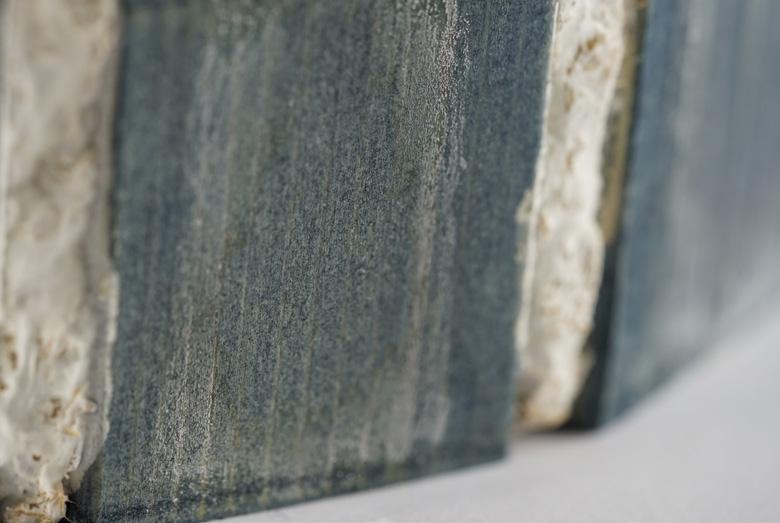



INDIGO WOOD COLORING
I was curious about how the mycelium might alter the water-based coloring of the wood and how it would appear alongside the white fuzzy surface of the mycelium. My intention was to explore the darkness nuances of natural indigo by dipping the wood into the mycelium. The lightest shade was dipped once, while the darkest was dipped nine times. I targeted natural stains and organic pigments such as indigo and minerals. Through the visuals, the wood can be seen without completely covering the surface, unlike everyday wood pigmentation. Then, I bonded the wooden slats with mycelium for about four days and let them dry for two days at room temperature.


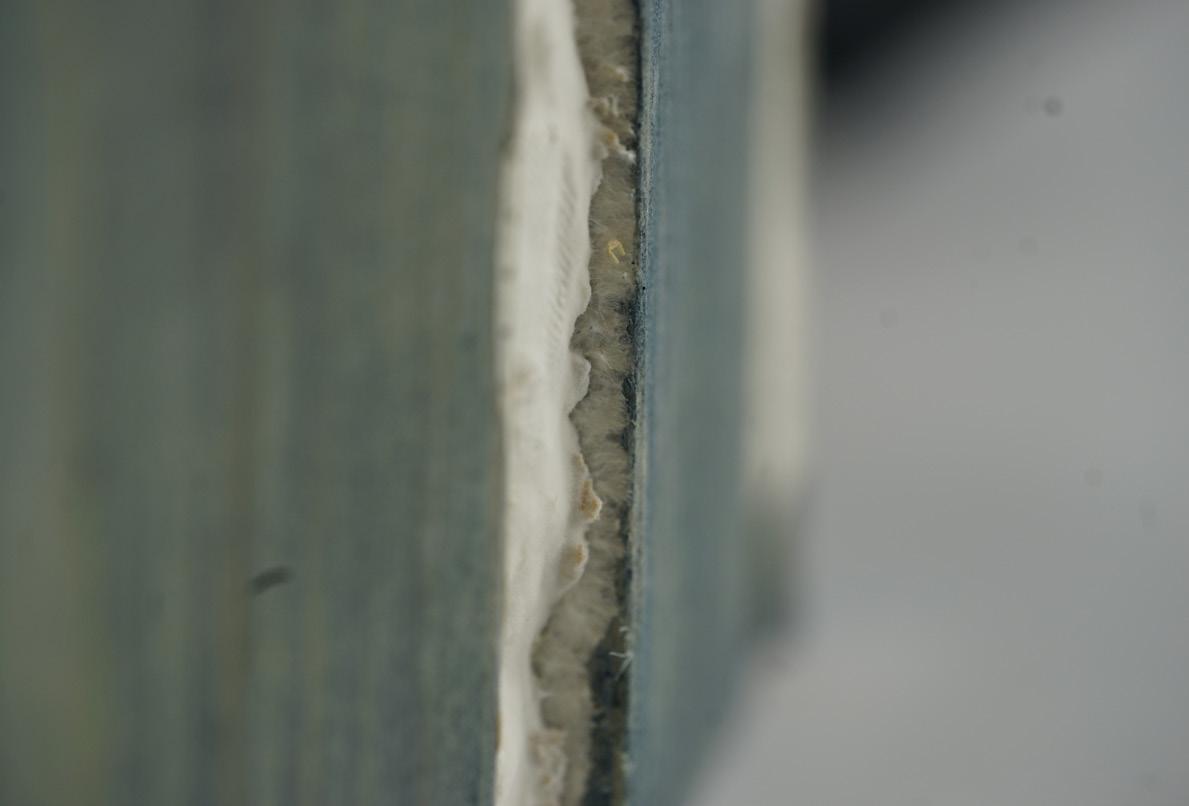
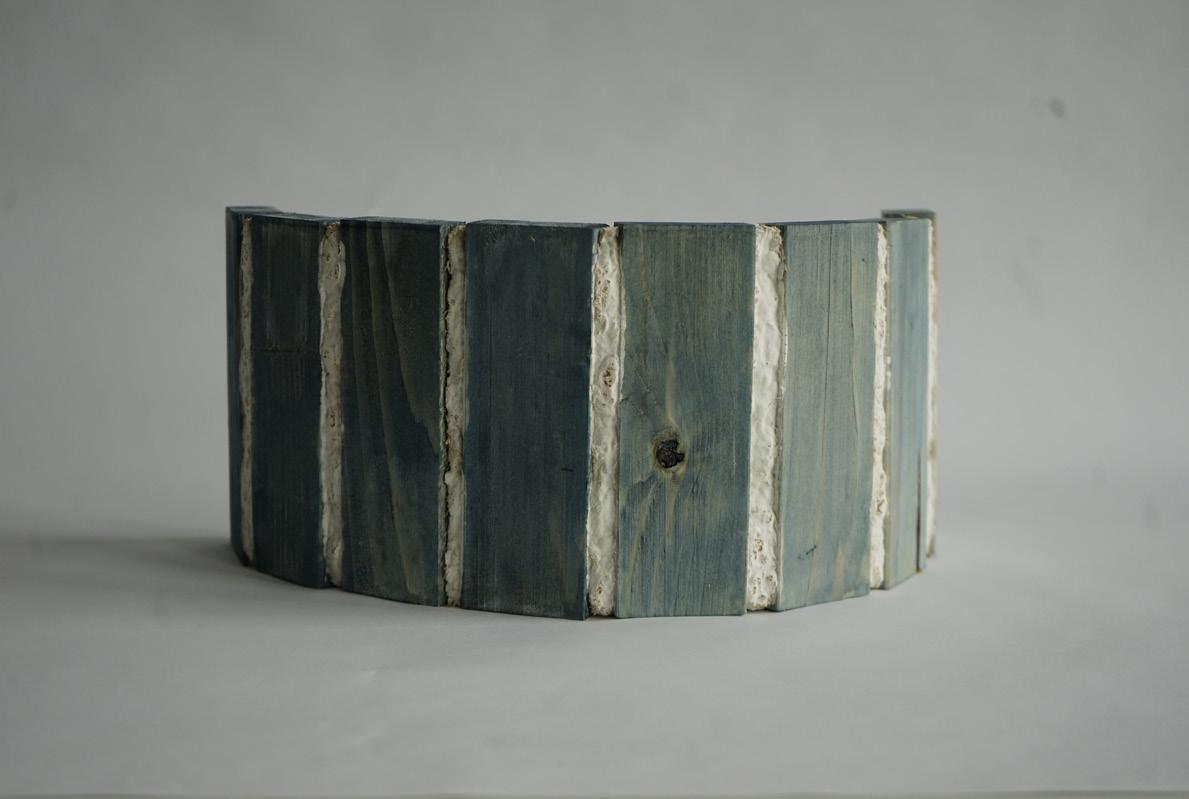

77 HYPHAE EXPERIMENTS
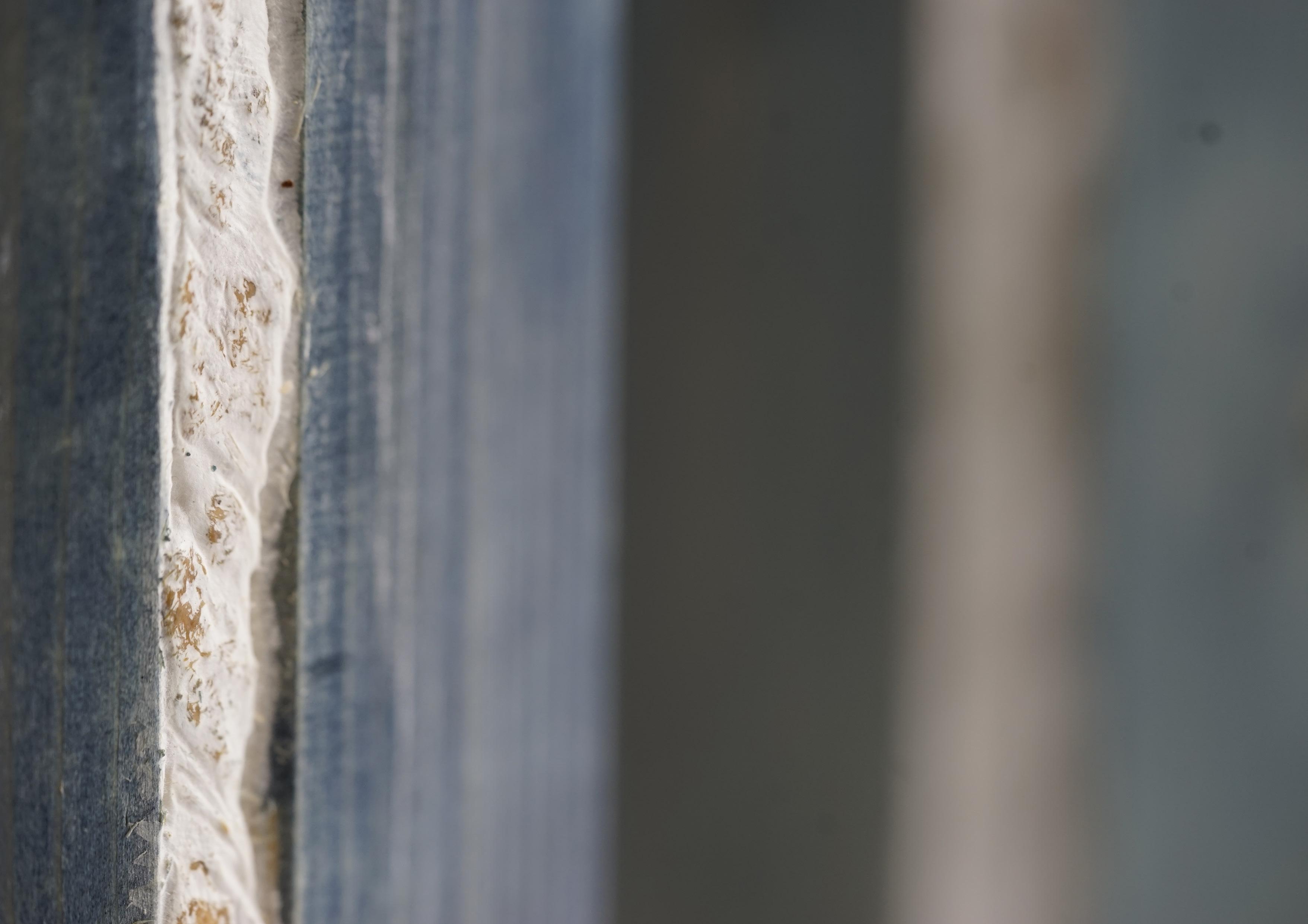




79 HYPHAE EXPERIMENTS




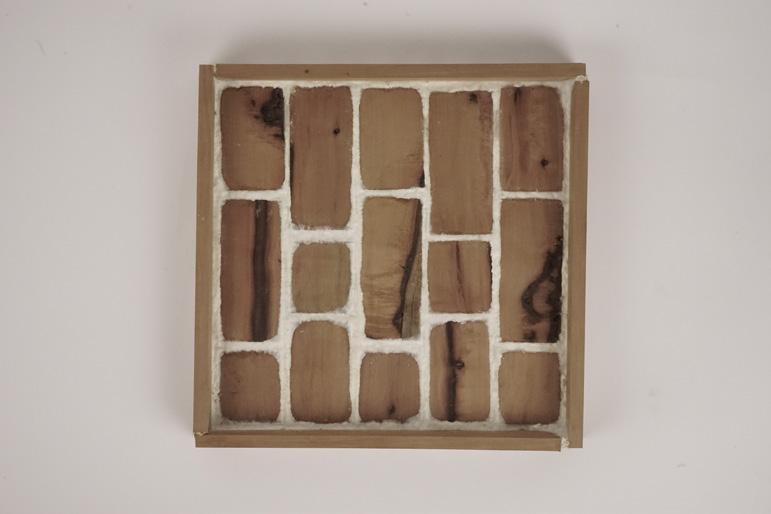


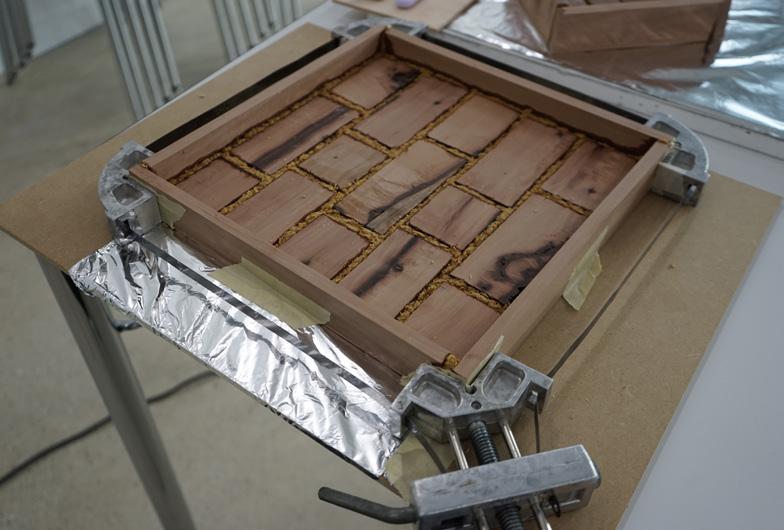

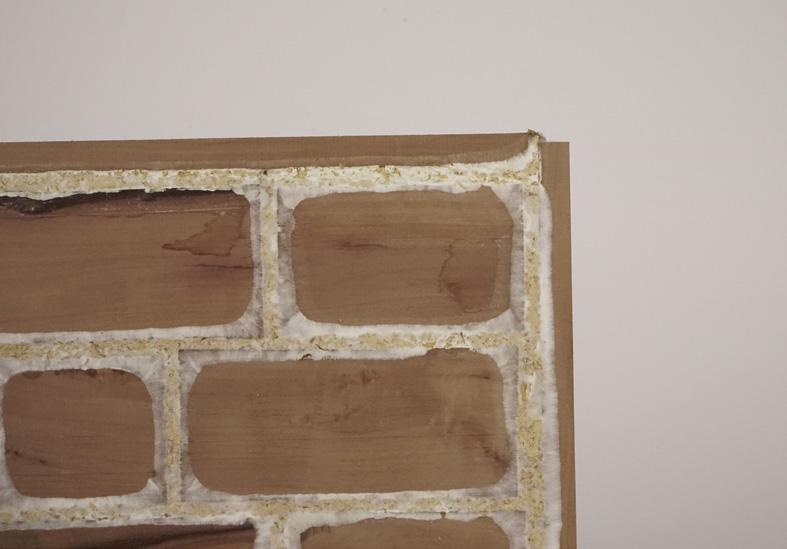
81 HYPHAE EXPERIMENTS
APPLIED CONTEXTS
adaptation and practical use
reflecting on mycelium in design

From my experiment on mycelium growth and binding, I discovered that if the mycelium is left alive, it will eventually develop its own design as a final form and surface. Its adhesive and bio-welding properties repeatedly demonstrate its potential to be used without harming the organism. I want to embrace its natural surface, color, and growth pattern.
Therefore, I suggest using simple geometrical structures that can easily attach to the mycelium. These attachments can be more or less visible depending on personal preference and can incorporate whole parts of the mycelium itself. The significant potential lies not only in witnessing the beauty of its growth but also in the fact that the mycelium is not „wasted.“ Unlike other materials, which cannot always be returned to their natural state or reused after production, mycelium can regenerate and continue to grow.





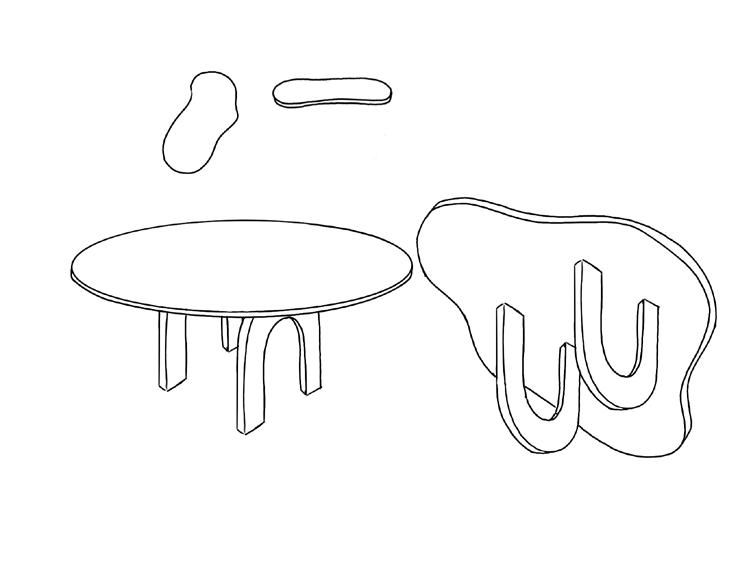

83 HYPHAE EXPERIMENTS


CONSTRUCTIONAL POTENTIAL
For attachment examples I want to use residue wood. But in a way that the mycelium is visible , taking the attention more than the wood. Therefore I dexided to binfd with the less amount of wood volume that I could to make the myceloum build the pattern instead of using it to bind big platte with mindlessly take off the awareness of the adhesive living matter. Since I tried to



85 HYPHAE EXPERIMENTS
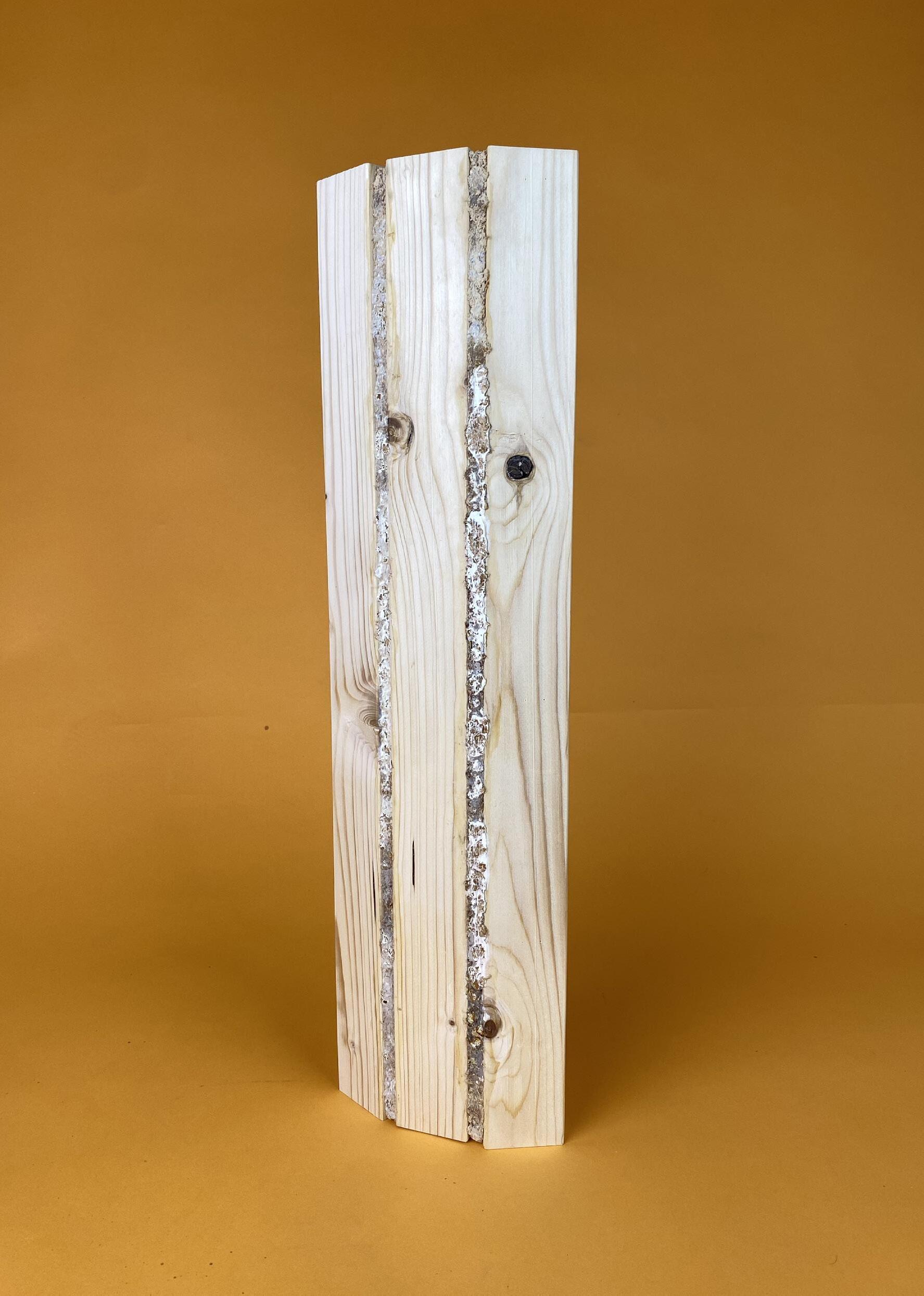
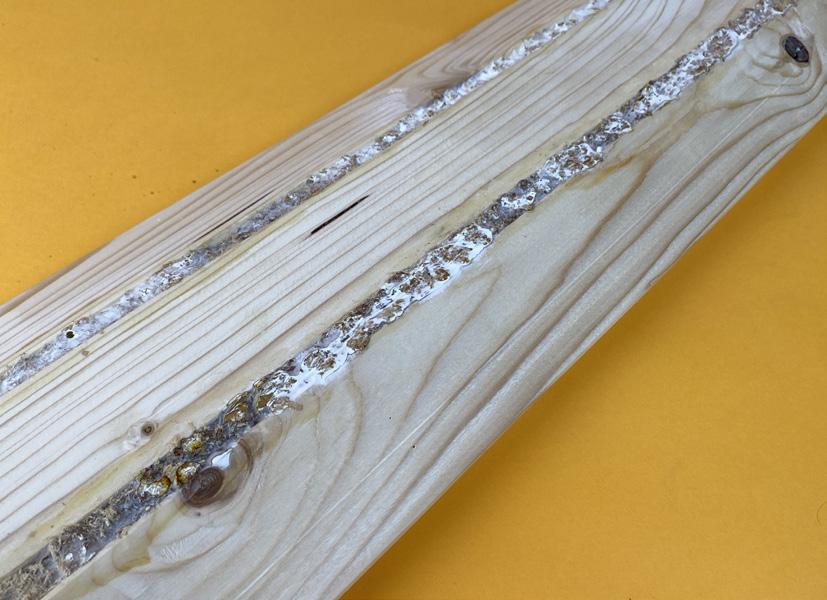



TEST FOR BREACKAGES
In my experiments, I observed that vertically-oriented structures such as tables and chairs are stable when constructed with fully dried mycelium. To test this, I applied pressure on a mycelium table and sat on a mycelium chair. The dried samples successfully supported the weight, even though the structures were minimal, consisting of only four slats. This demonstrates the impressive strength of dried mycelium.
However, I also tested mycelium that was only partially dried. When pressure was applied to the table or when sitting on the chair, these partially dried samples broke easily. This is because the mycelial network had not yet fully matured and solidified. For optimal strength and stability, it is crucial to ensure that the mycelium is fully dried. Additionally, incorporating several slats and a balanced form will enhance the structural integrity. Only with these conditions met can mycelium-based furniture reliably hold weight and maintain durability.
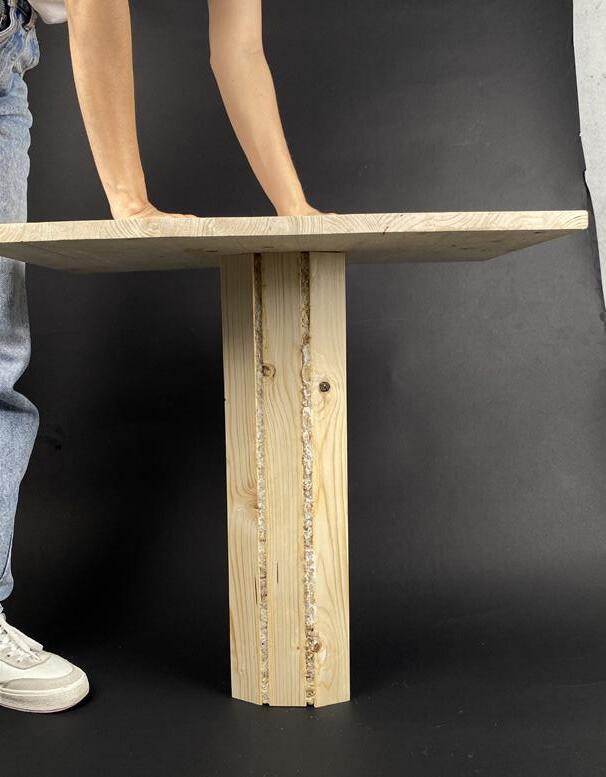


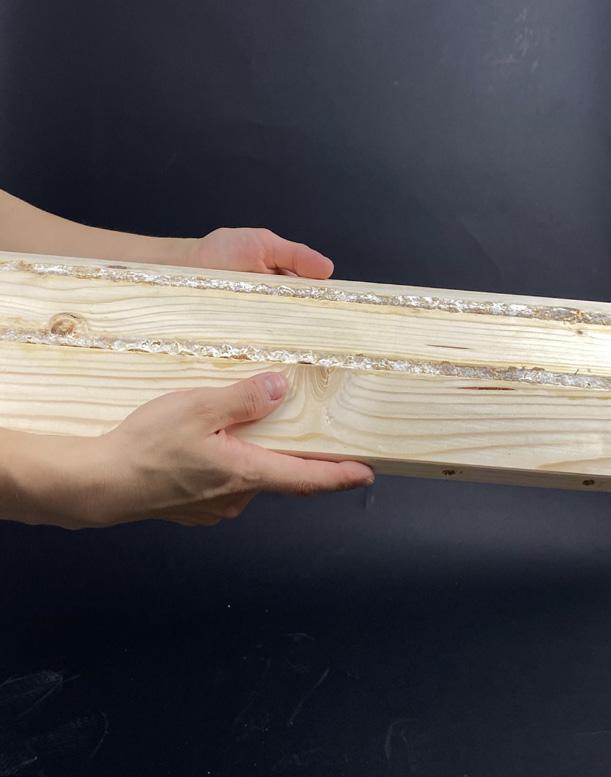
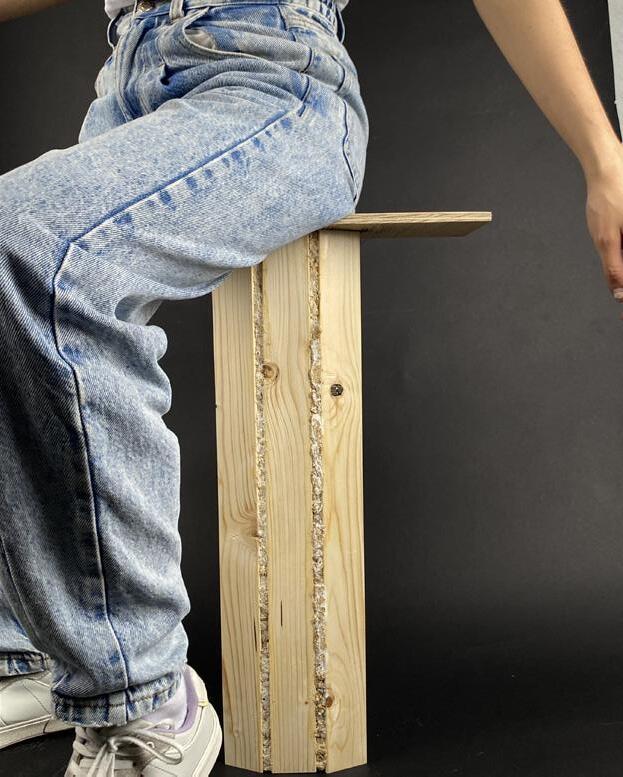

87 HYPHAE EXPERIMENTS





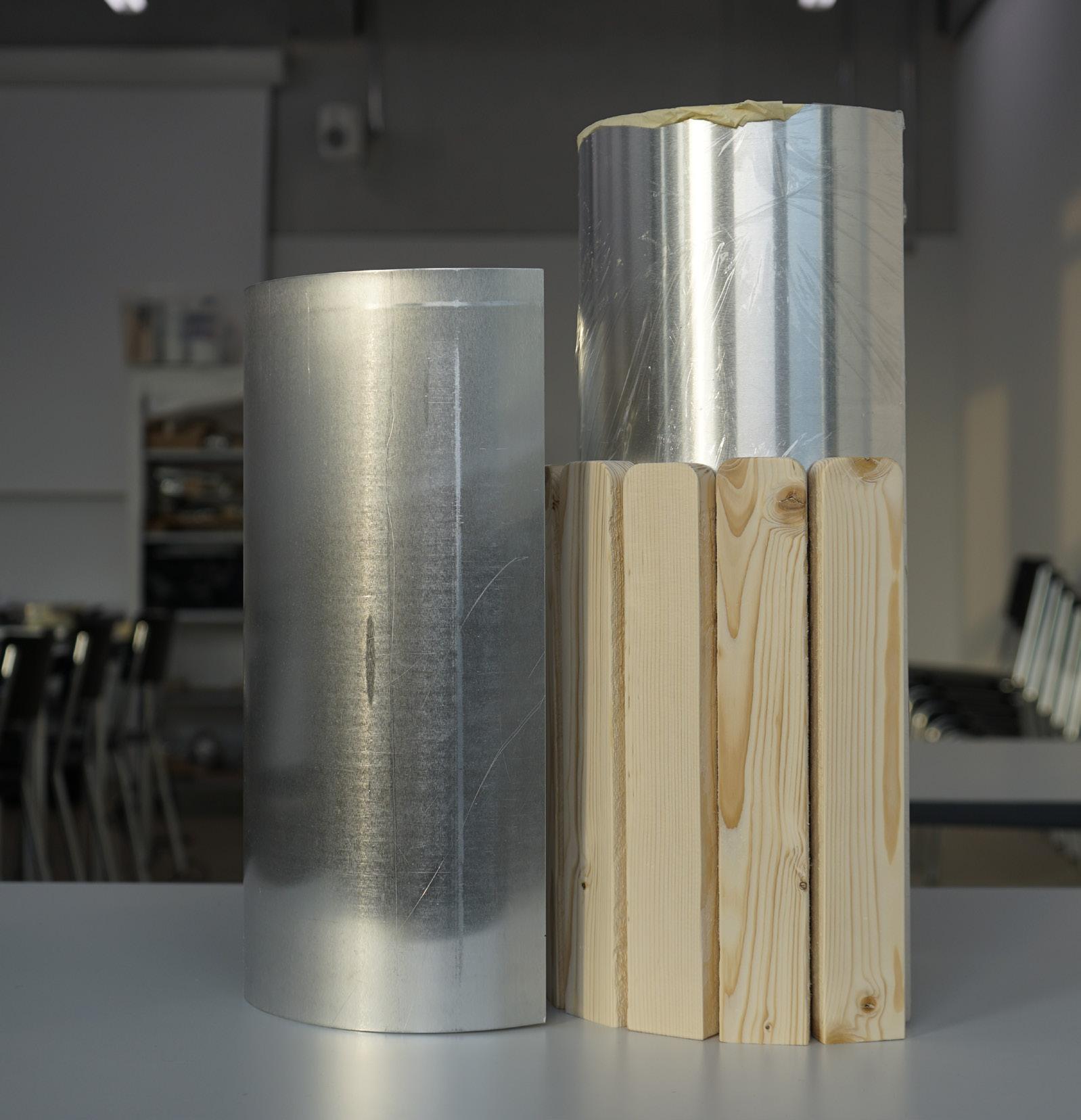

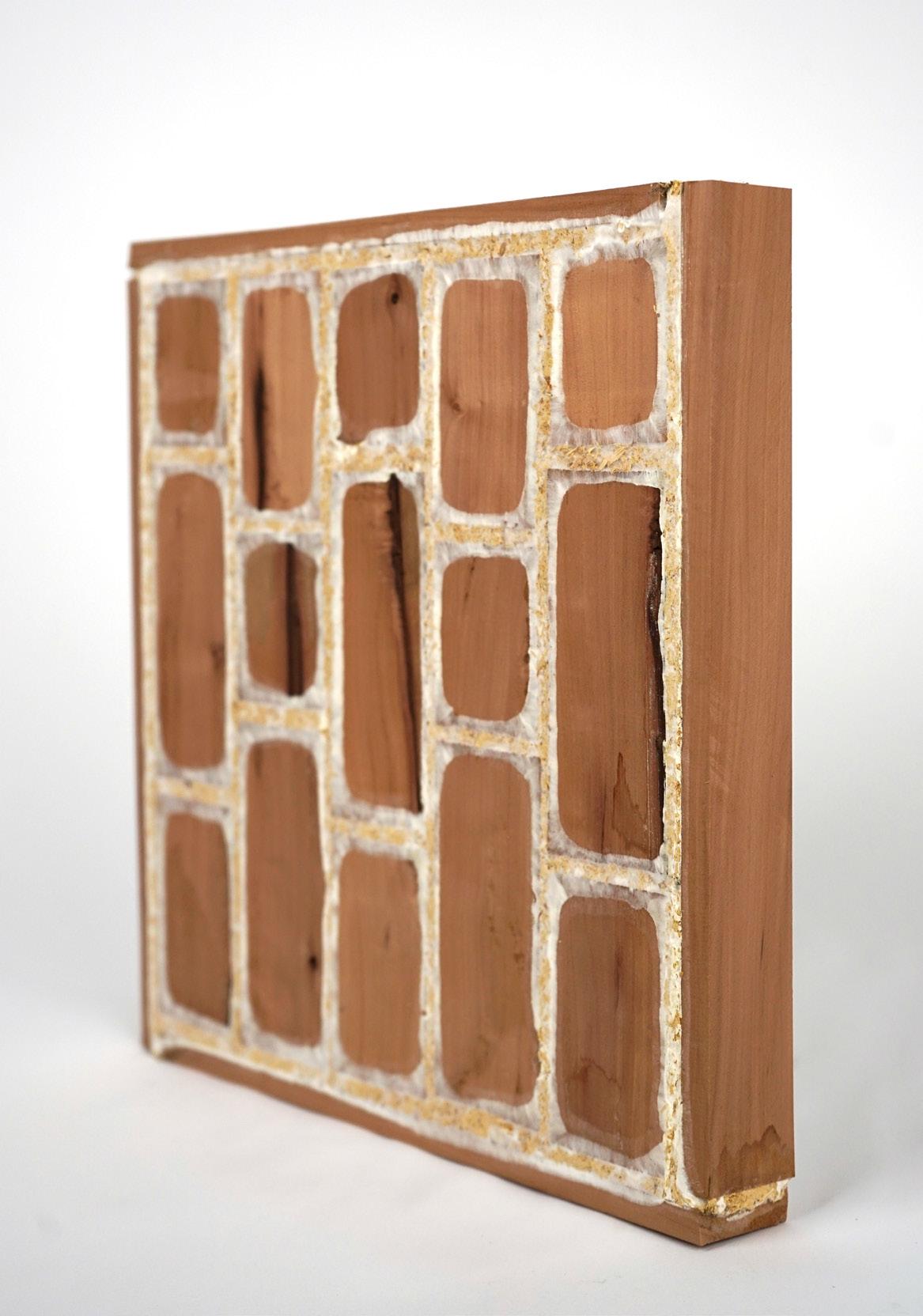
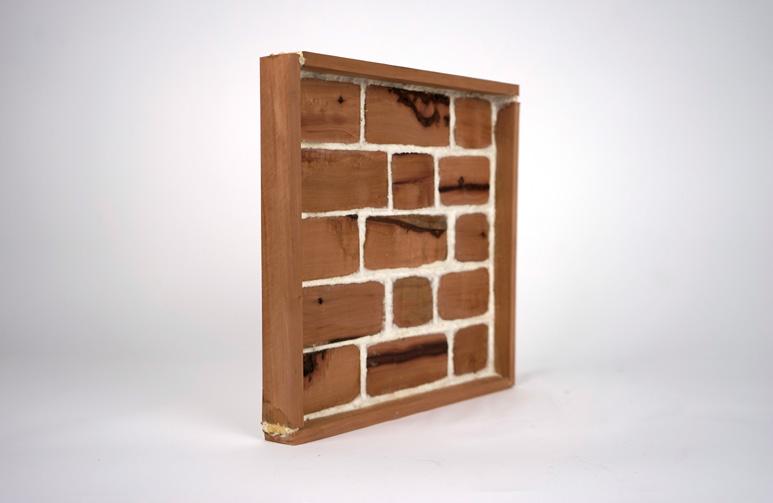



89 HYPHAE EXPERIMENTS
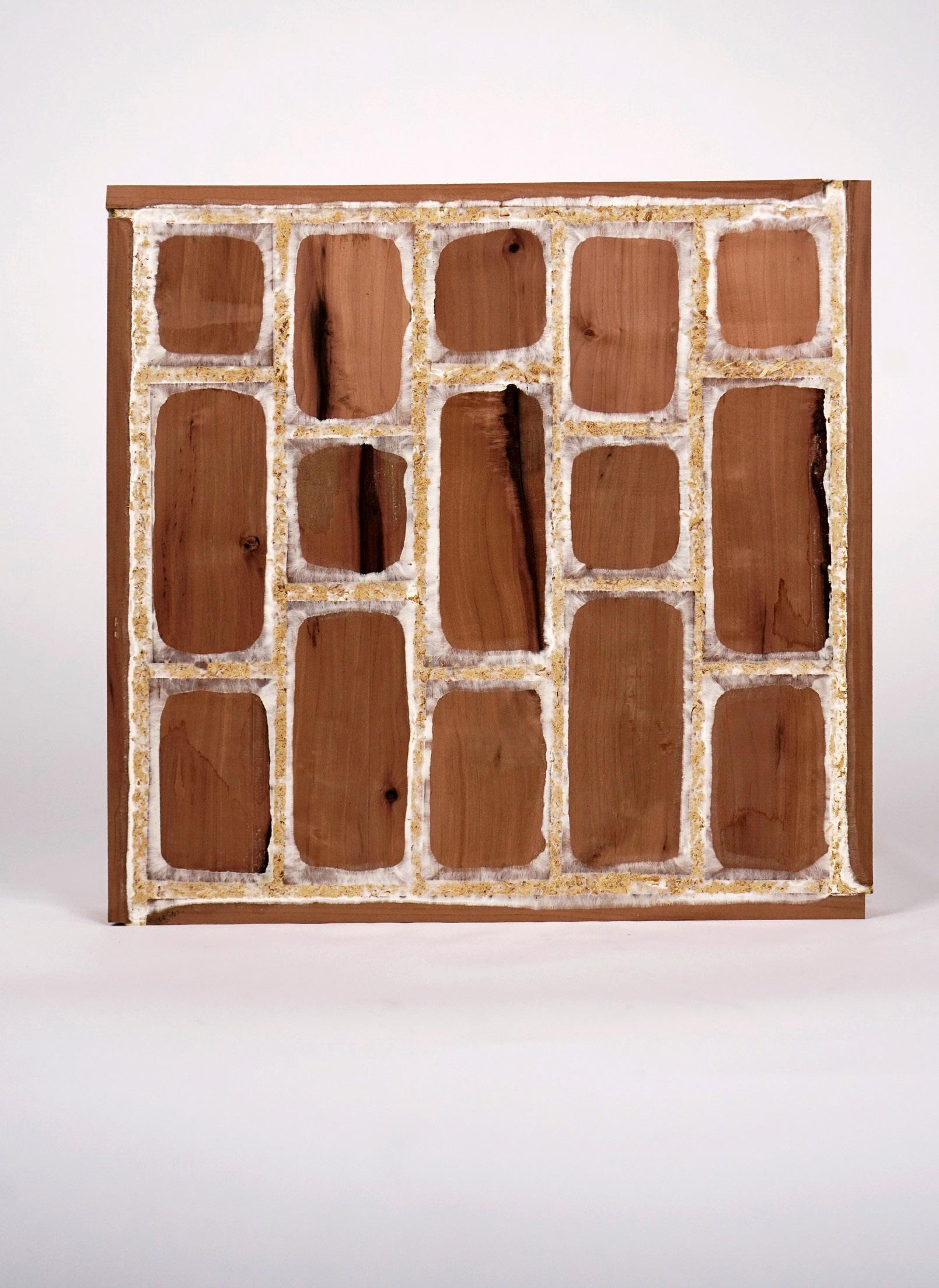




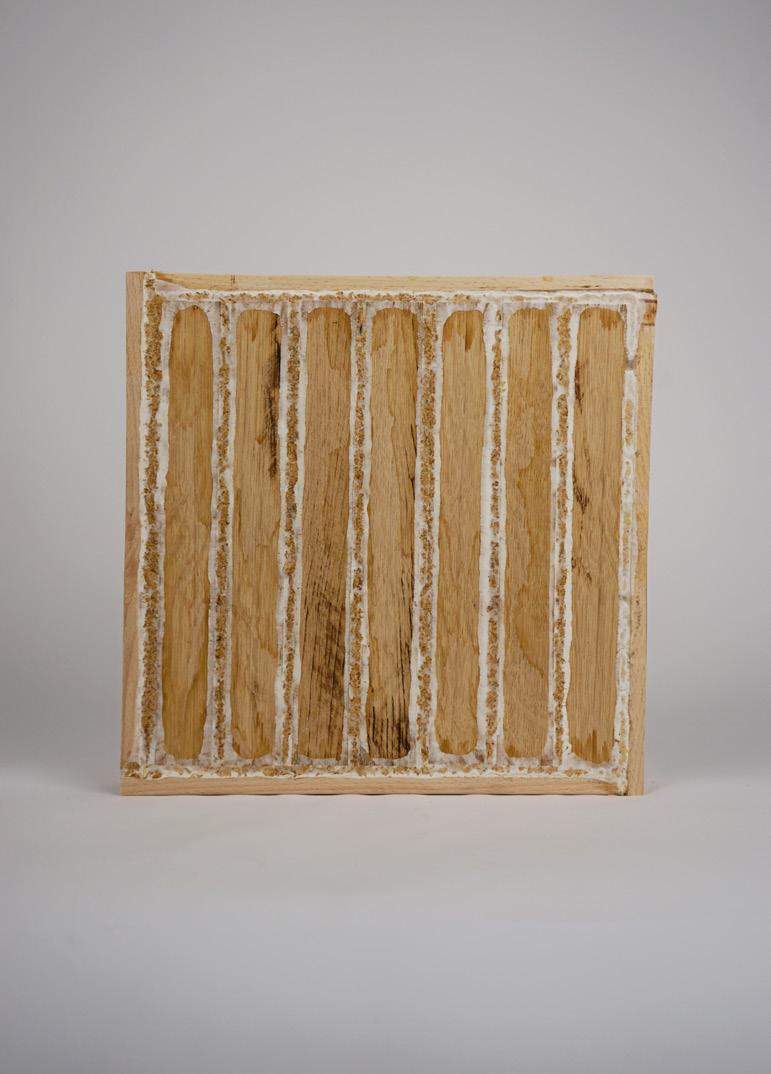
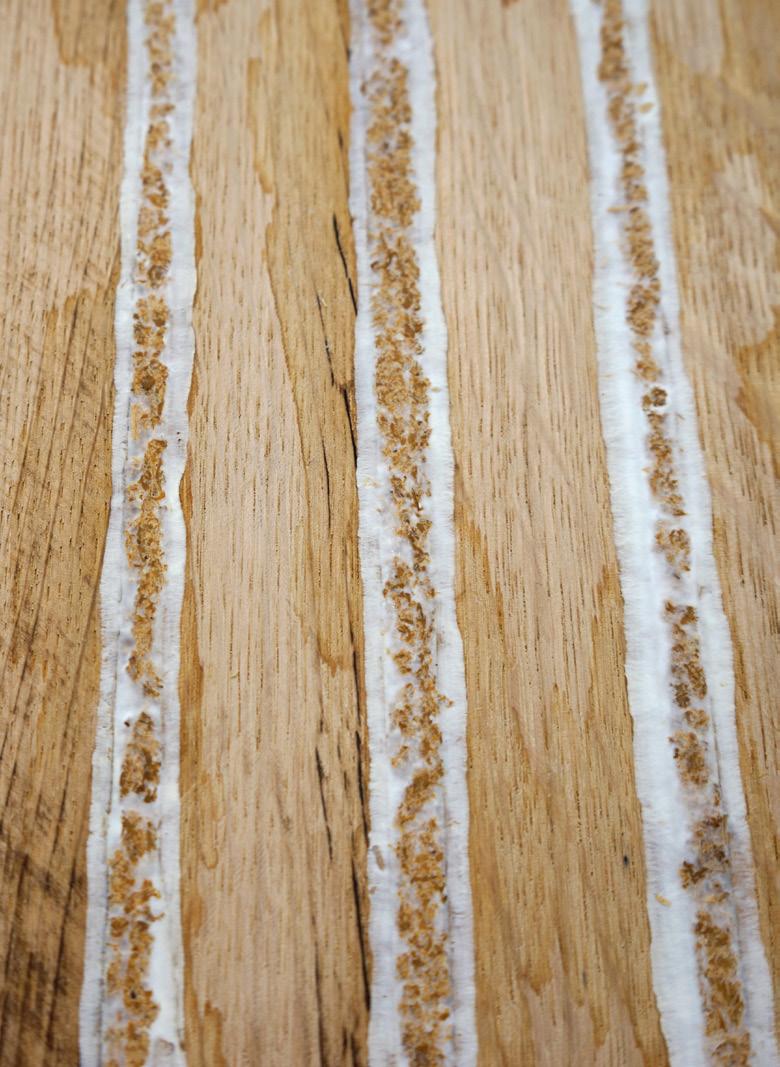
91 HYPHAE EXPERIMENTS

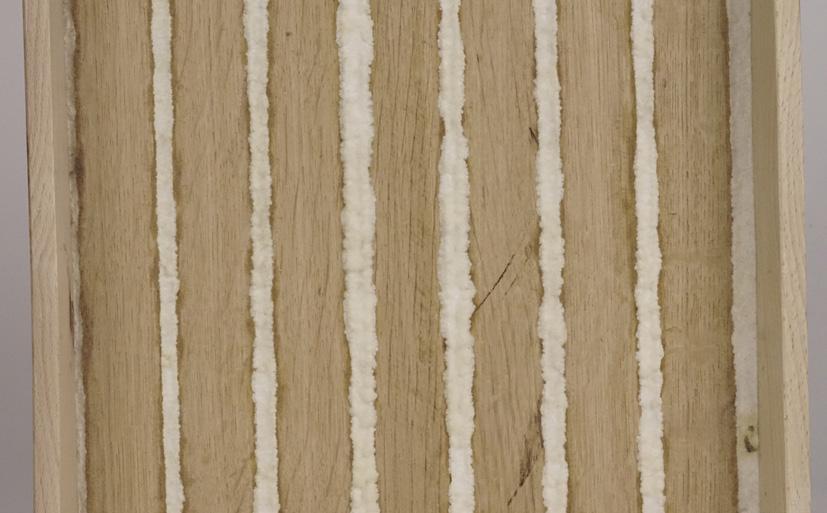



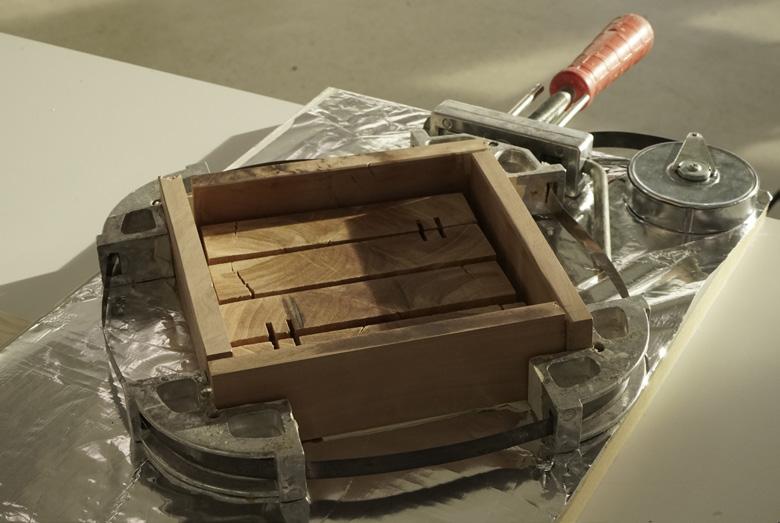







93 HYPHAE EXPERIMENTS
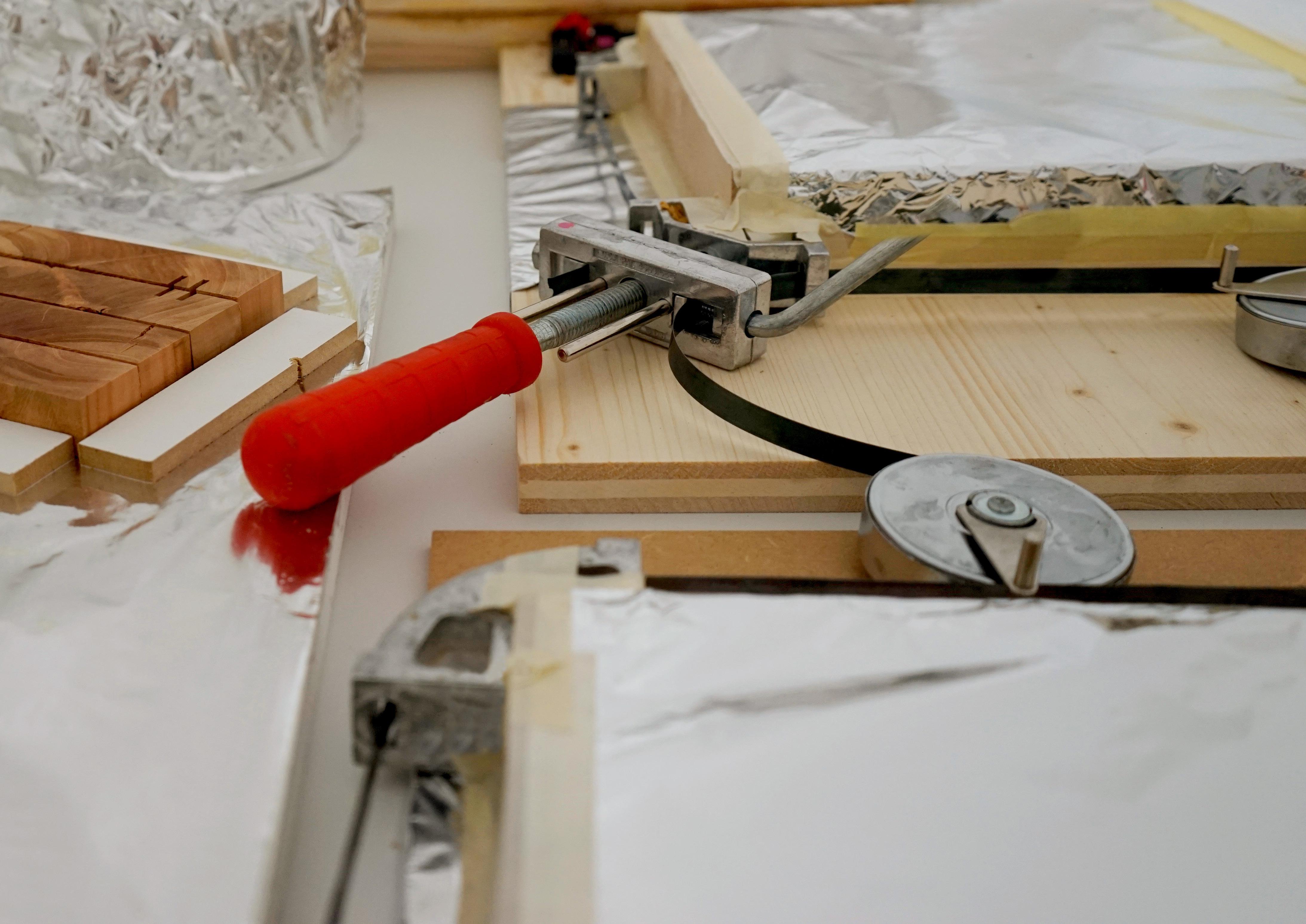

95 HYPHAE EXPERIMENTS


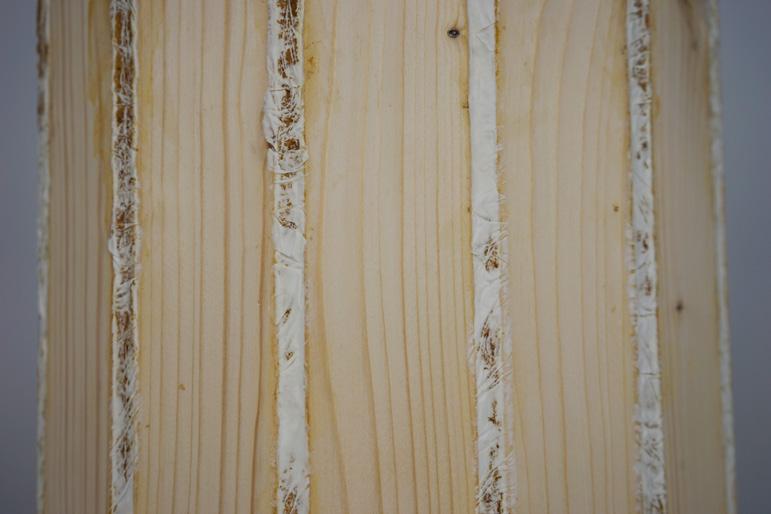





97 HYPHAE EXPERIMENTS
COSCLUSION AND OUTLOOK
This study of living mycelium takes a holistic approach to working with mycelium as a living organism rather than just a material. Its regenerative capabilities open up possibilities for modular applications in indoor spaces, room dividers, and even temporary installations that can be easily removed.
The ease of dismantling and repair makes mycelium-based structures highly adaptable. Because mycelium can grow and regenerate, damaged sections can be repaired by simply allowing the mycelium to regrow, ensuring longevity and sustainability. This characteristic makes it an excellent choice for dynamic environments where flexibility and adaptability are crucial.
Additionally, the inherent bio-welding properties of mycelium allow it to naturally bond with other mycelium pieces, creating unique and strong connections. This can simplify the construction and maintenance of larger structures, offering a sustainable alternative to traditional building materials.
In summary, utilizing living mycelium not only provides an environmentally friendly material but also introduces a new paradigm in design and architecture where structures are alive, self-repairing, and continually evolving.
This study views mycelium as a living organism with regenerative capabilities, ideal for modular indoor applications, room dividers, and temporary installations. Mycelium-based structures are highly adaptable, easily repaired by regrowth, ensuring sustainability. Its bio-welding properties allow seamless bonding, simplifying construction and maintenance. Utilizing living mycelium offers an eco-friendly, self-repairing, and evolving alternative to traditional materials, introducing a new paradigm in design and architecture.


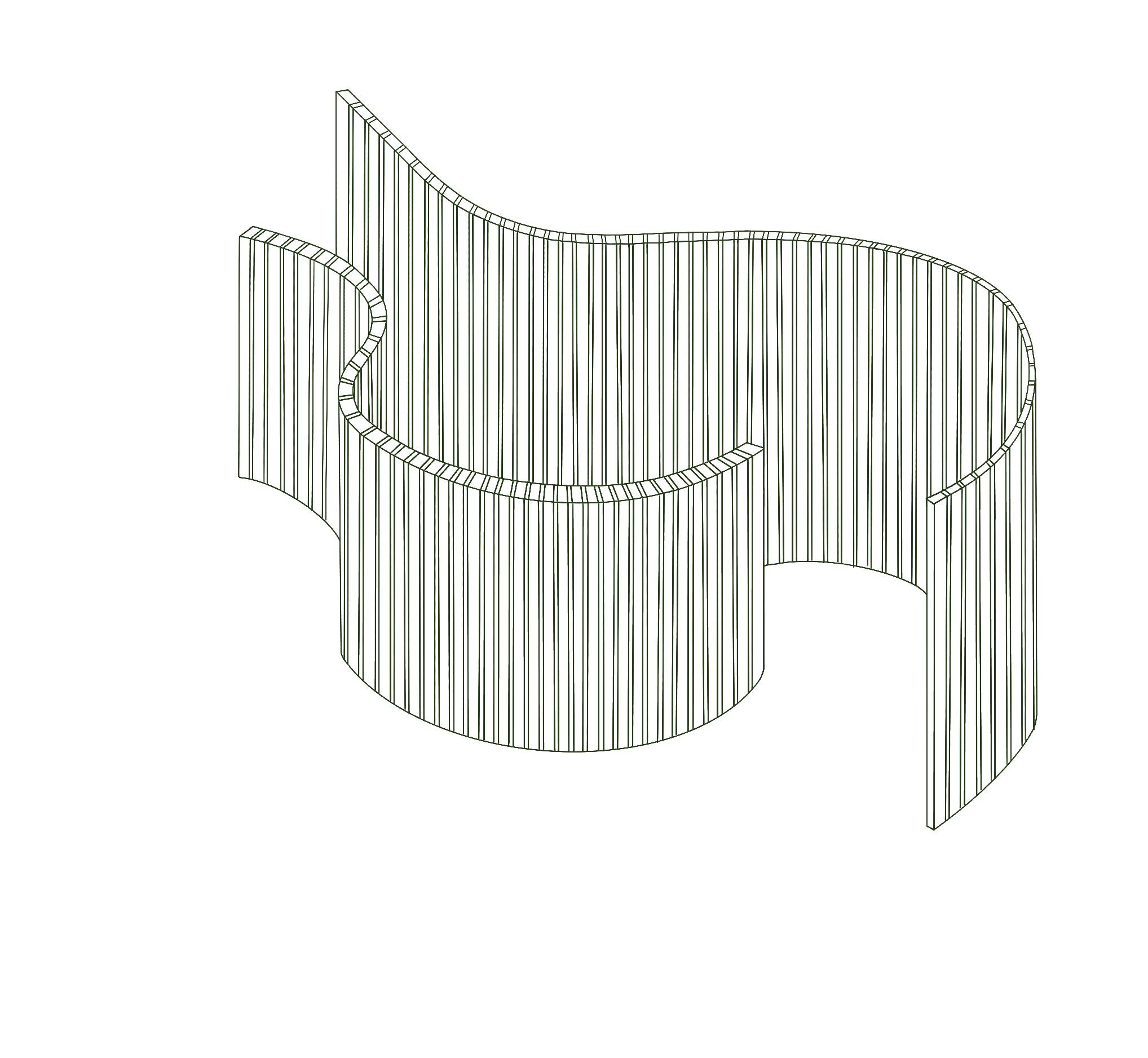

99 HYPHAE EXPERIMENTS
Growing living mycelium as a binder embodies a profound philosophical shift in design, reflecting a departure from the notion of human mastery over nature towards a more symbiotic relationship with the natural world. It signifies an acknowledgment of the intrinsic wisdom of ecosystems and the potential for collaboration with living organisms in design processes. Mycelium, with its ability to connect and transform organic matter, becomes a metaphor for interconnectedness and resilience, reminding us of the intricate web of life that sustains us. This approach invites contemplation on the concept of design not as imposition but as co-creation, where human intentionality intertwines with the agency of living systems, fostering a deeper understanding of our place within the ecological whole and encouraging designs that honor the principles of sustainability, regeneration, and harmony with nature.
101 HYPHAE EXPERIMENTS
HYPHAE

AN ORGANIC BINDING INVENTORY





























































































































































































































































































































































































